Downloadable on the soundcloud link and also available on iTunes, subscribe HERE
RSS feed, if required, here
Also available on Spotify, Stitcher
Real Madrid’s stingy defence, Ansu Fati’s antecedents, the free-kick prowess of Óscar Rodríguez and Paco Alcácer’s fit at Villarreal. It’s all here in this week’s La Liga wrap.
Real Madrid retained their three-point advantage at the top of the table with a 1–0 victory over local rivals Atlético Madrid, a win that provides a perfect microcosm of their approach this season. Madrid took 16 shots, right on their league-high average of 15.91, but most were of relatively poor quality. They and Barcelona are pretty much dead even in terms of expected goals (xG) this season, but the two got there in very different ways: Madrid prioritise volume over quality; Barcelona take fewer shots of higher average quality.  Five of those shots came from set pieces, where Real Madrid lead the league.
Five of those shots came from set pieces, where Real Madrid lead the league.  At the other end, they conceded just four shots for a tally of 0.20 xG. On average this season, only Getafe’s hyper-press has limited opponents to fewer shots than Madrid. No team has conceded fewer goals, and in xG terms, Madrid also have the league’s joint-best defence, alongside their city rivals.
At the other end, they conceded just four shots for a tally of 0.20 xG. On average this season, only Getafe’s hyper-press has limited opponents to fewer shots than Madrid. No team has conceded fewer goals, and in xG terms, Madrid also have the league’s joint-best defence, alongside their city rivals. 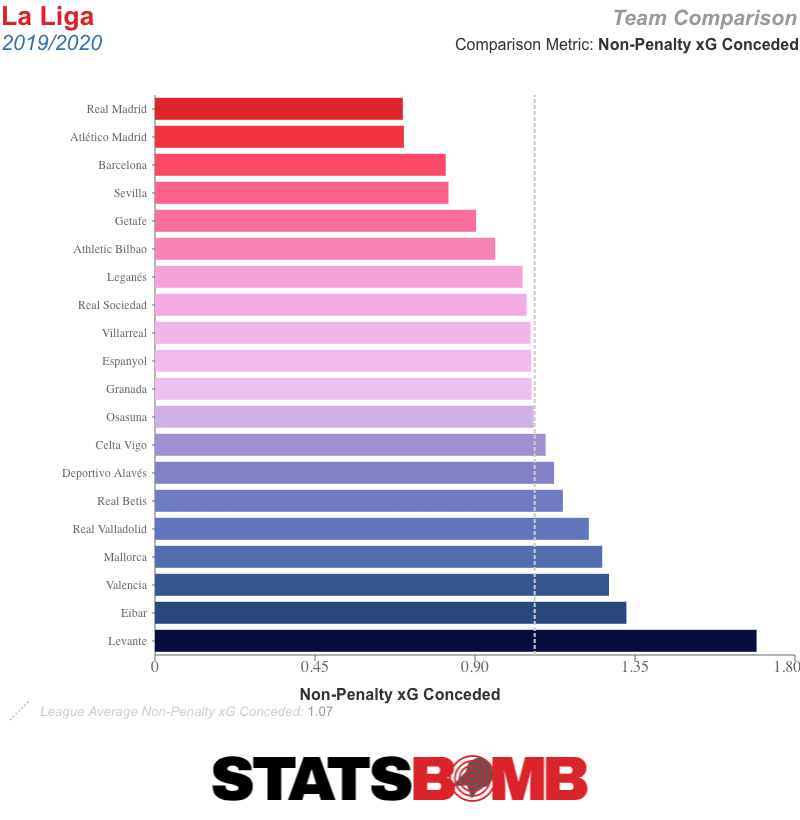 After what was, at least in their terms, a pretty disastrous campaign last time around, Zinedine Zidane has crafted a solid side capable of constricting their opponents and then piling on enough shots from crosses, set pieces and general play to more often than not get the goals they need to emerge victorious.
After what was, at least in their terms, a pretty disastrous campaign last time around, Zinedine Zidane has crafted a solid side capable of constricting their opponents and then piling on enough shots from crosses, set pieces and general play to more often than not get the goals they need to emerge victorious. 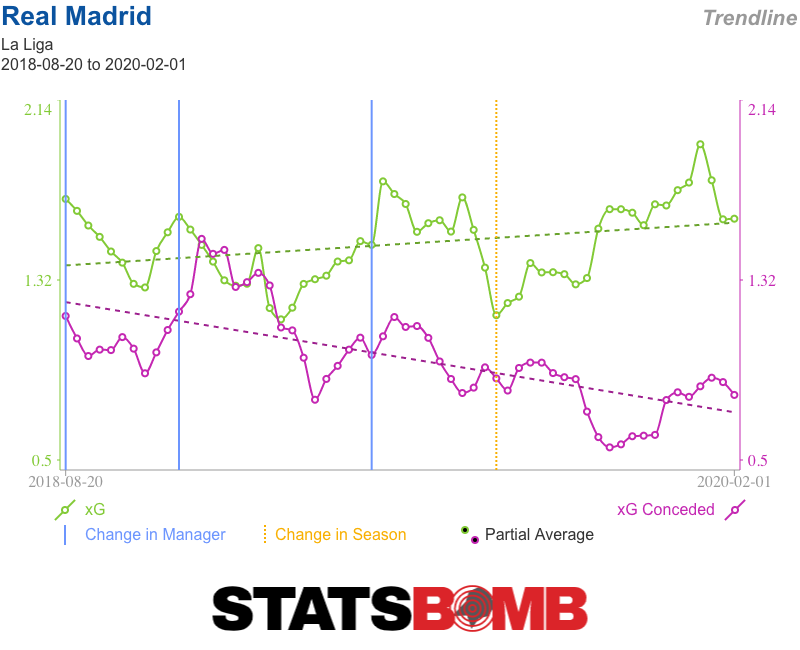 If Madrid continue to score at their current rate, they could reach 70 goals — better than last season, yet miles away from their average of over 100 goals per season over the previous five campaigns. But even if their concession rate slackens somewhat, this will still be their best defensive season since the late eighties, perhaps even further back than that. It’s a combination that may well be enough to see the league title return to the Bernabéu.
If Madrid continue to score at their current rate, they could reach 70 goals — better than last season, yet miles away from their average of over 100 goals per season over the previous five campaigns. But even if their concession rate slackens somewhat, this will still be their best defensive season since the late eighties, perhaps even further back than that. It’s a combination that may well be enough to see the league title return to the Bernabéu.
On Sunday night, Ansu Fati added another record to his growing collection by becoming the youngest-ever player to score a brace in La Liga. Two quick-fire goals, both assisted by Lionel Messi, powered Barcelona to a 2–1 win over Levante and continued his incredible ascension. “This is all a dream,” he admitted afterwards. Fati’s output to date is crazy good for a 17-year-old. 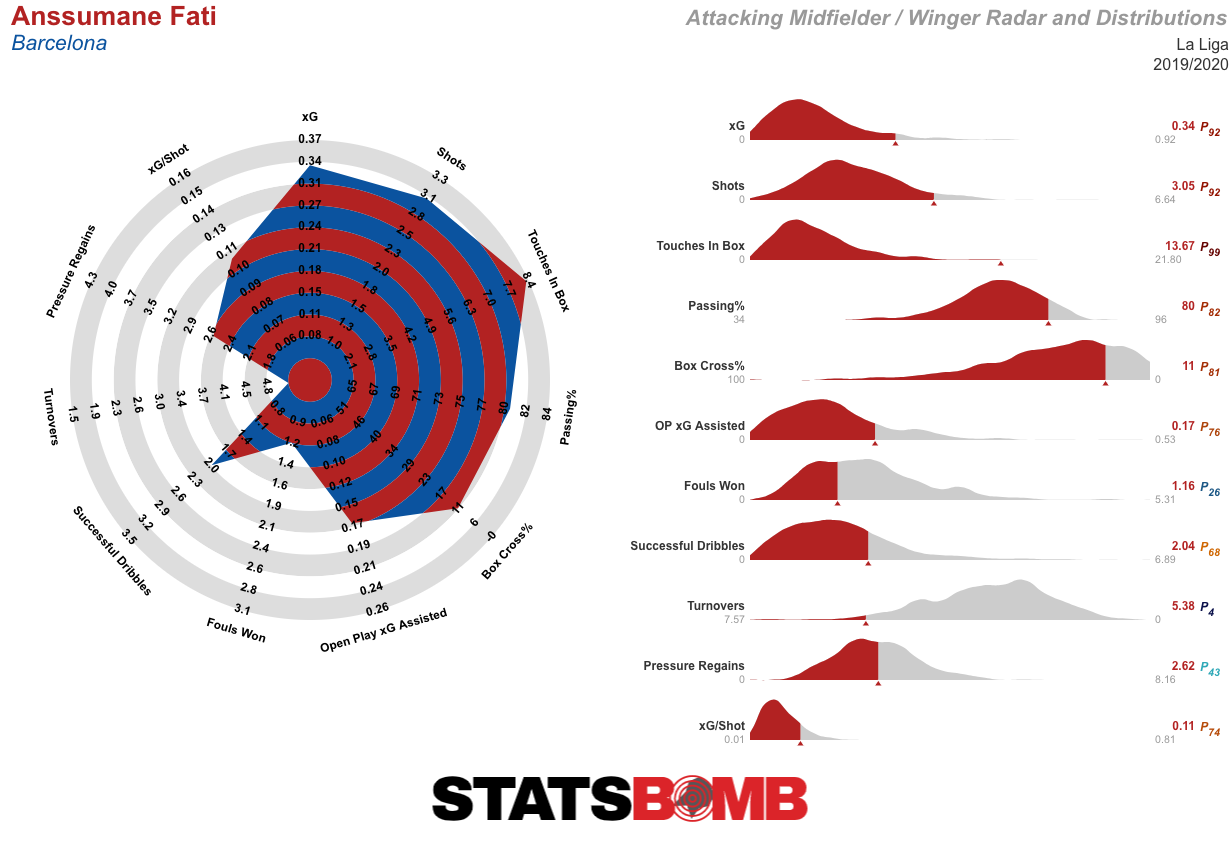 No one likes to put limits on young talents, especially ones who break through at one of the world’s biggest clubs at such a preternatural age, but two lingering questions remain: 1) Can he replicate that output over a larger sample size? Usually, a player needs to see at least 900 minutes of action before any sort of useful conclusions can be drawn about a player, and ideally more than that; and 2) How does he compare to other forwards who’ve broken through young at Barcelona? Does this kind of output necessarily precede superstardom? Thanks to our Messi Data Biography, we can answer that second question. Here is how Fati compares to several of the other starlets who’ve made strong early impressions at Barcelona. First up, the man himself: Lionel Messi.
No one likes to put limits on young talents, especially ones who break through at one of the world’s biggest clubs at such a preternatural age, but two lingering questions remain: 1) Can he replicate that output over a larger sample size? Usually, a player needs to see at least 900 minutes of action before any sort of useful conclusions can be drawn about a player, and ideally more than that; and 2) How does he compare to other forwards who’ve broken through young at Barcelona? Does this kind of output necessarily precede superstardom? Thanks to our Messi Data Biography, we can answer that second question. Here is how Fati compares to several of the other starlets who’ve made strong early impressions at Barcelona. First up, the man himself: Lionel Messi. 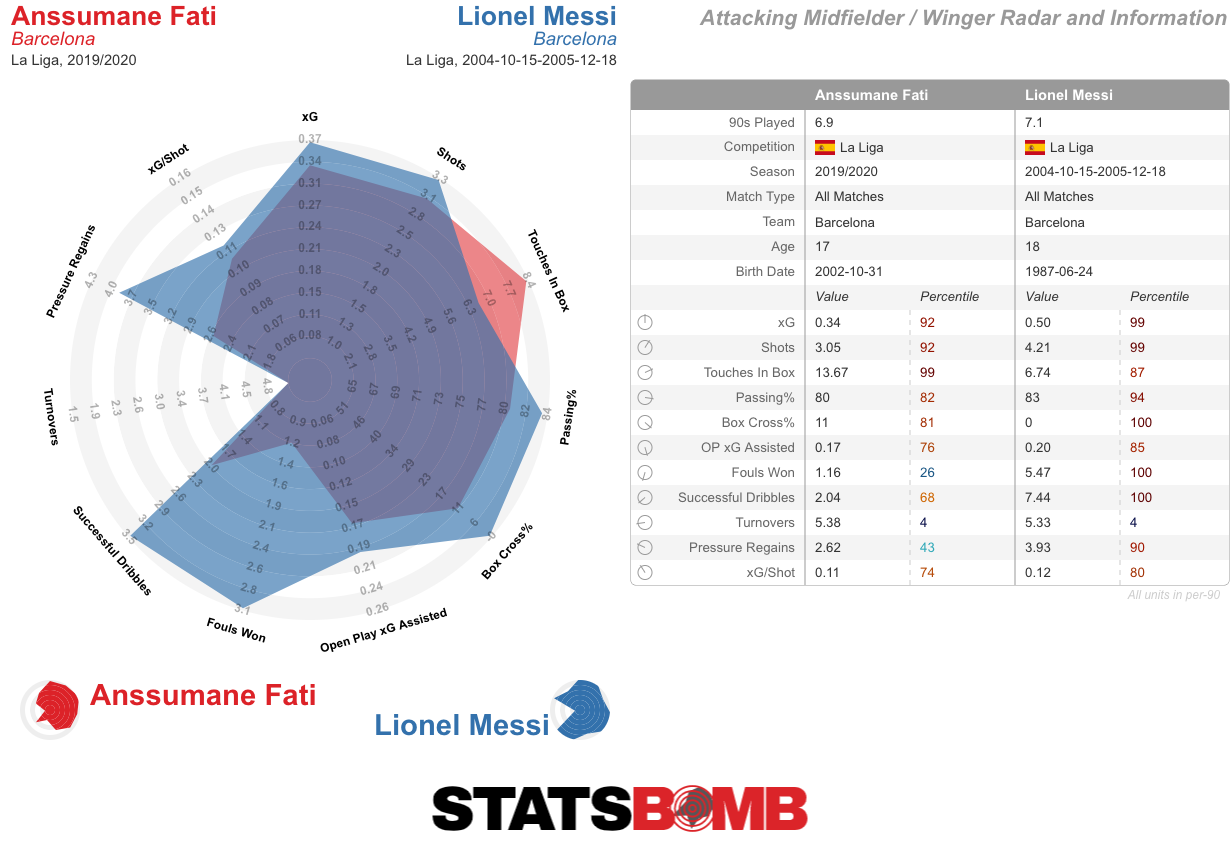 That’s probably an unfair comparison for anyone. Messi’s output was extraordinary from the get-go. Next up, Bojan. He debuted in September 2007, less than three weeks after his 17th birthday.
That’s probably an unfair comparison for anyone. Messi’s output was extraordinary from the get-go. Next up, Bojan. He debuted in September 2007, less than three weeks after his 17th birthday.  Fati just about prevails, but it’s close. Finally, we have Munir. He scored on his debut as an 18-year-old near the end of August 2014 and was a Spain international just a couple of weeks later — his one and only cap.
Fati just about prevails, but it’s close. Finally, we have Munir. He scored on his debut as an 18-year-old near the end of August 2014 and was a Spain international just a couple of weeks later — his one and only cap. 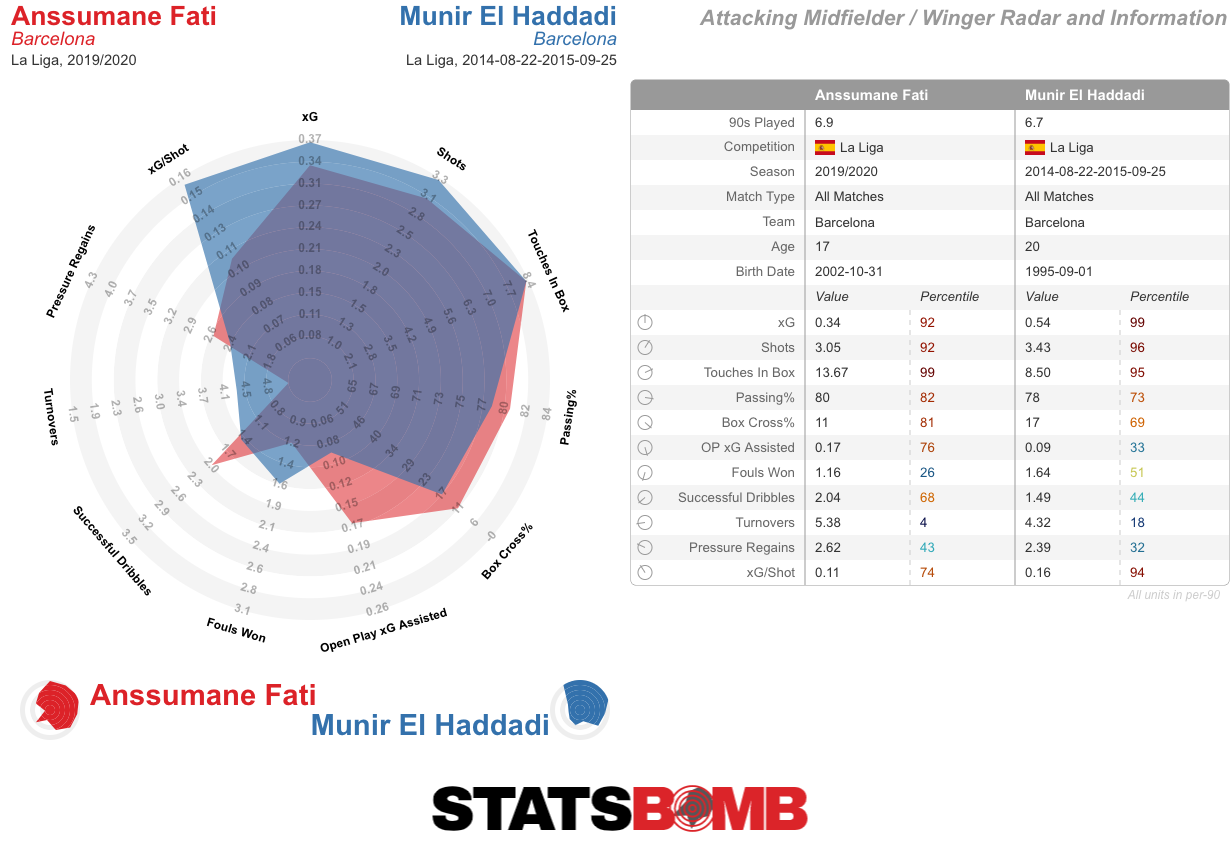 This one is pretty much a tie: better shooting output from Munir; better creative output from Fati. These quick and dirty comparisons serve to provide some context as to what Fati might go on to achieve from here. Superstar, rotational forward in a top-four chasing side or playing in MLS before age 30 — it feels like all of those outcomes are still in play.
This one is pretty much a tie: better shooting output from Munir; better creative output from Fati. These quick and dirty comparisons serve to provide some context as to what Fati might go on to achieve from here. Superstar, rotational forward in a top-four chasing side or playing in MLS before age 30 — it feels like all of those outcomes are still in play.
Leganés and Real Sociedad seemed headed for a draw in their meeting at Butarque on Sunday when the home team were awarded a free-kick deep into stoppage time. Óscar Rodríguez placed the ball down and retreated a few paces. The whistle blew, and up he stepped to fire a superb strike right into the top corner.  It wasn’t the first time he’s done that this season. It was his 3rd free-kick goal from 10 attempts, and he also struck the woodwork against Valencia.
It wasn’t the first time he’s done that this season. It was his 3rd free-kick goal from 10 attempts, and he also struck the woodwork against Valencia.  So do we have a new free-kick maestro on our hands? The truth is there's no way to tell at this stage. The sample size is far too small. However, a goal scored in every three or so free-kicks is an insanely high scoring rate. Smooth it out with last season’s data, when he failed to score in 10 attempts, and the Rodríguez scores a goal in every 6.67 free-kicks, which is still quite high. Messi is one of the few players for whom there's enough data to say with a degree of confidence that he is a skilled set-piece shooter, and even he averages less than one goal in 10 free kicks over the course of his career. Over smaller sample sizes, we can see all manner of misleading hot streaks. Enis Bardhi is the go-to example in La Liga. In the 2017–18 season, he scored five goals from 16 direct free-kicks — barely less than one goal for every three he took.
So do we have a new free-kick maestro on our hands? The truth is there's no way to tell at this stage. The sample size is far too small. However, a goal scored in every three or so free-kicks is an insanely high scoring rate. Smooth it out with last season’s data, when he failed to score in 10 attempts, and the Rodríguez scores a goal in every 6.67 free-kicks, which is still quite high. Messi is one of the few players for whom there's enough data to say with a degree of confidence that he is a skilled set-piece shooter, and even he averages less than one goal in 10 free kicks over the course of his career. Over smaller sample sizes, we can see all manner of misleading hot streaks. Enis Bardhi is the go-to example in La Liga. In the 2017–18 season, he scored five goals from 16 direct free-kicks — barely less than one goal for every three he took. 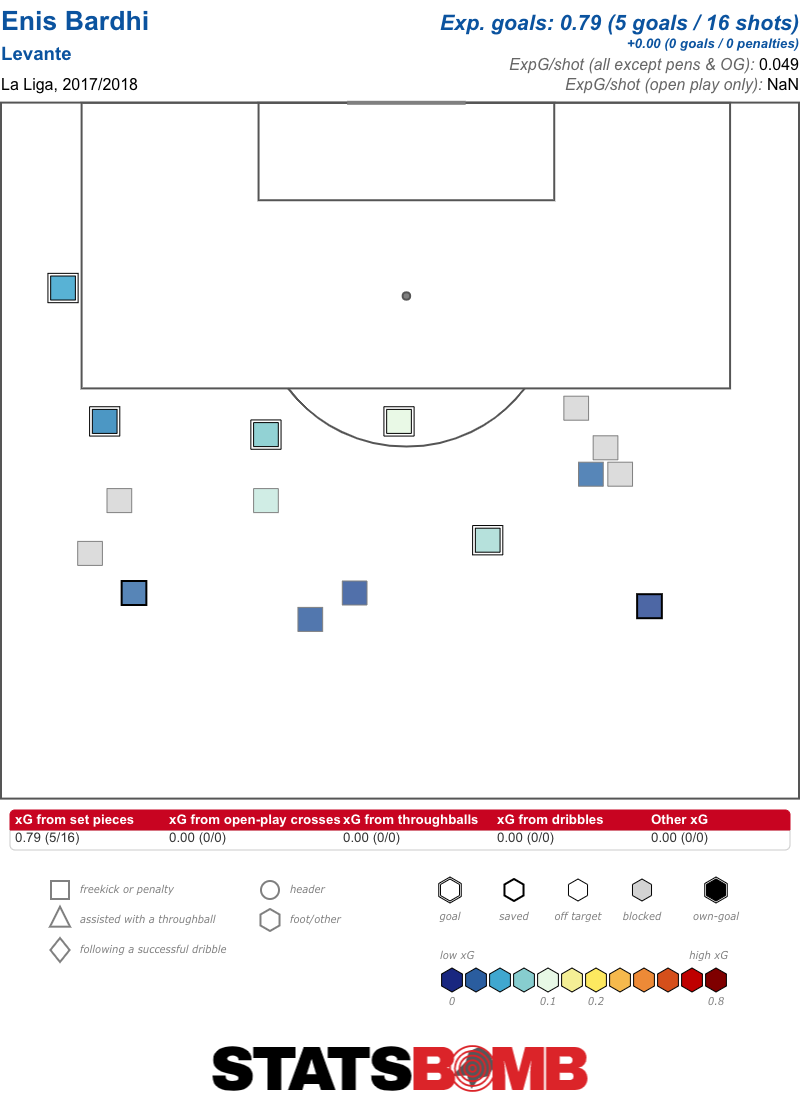 In reality, that conversion rate was never going to be sustainable. But what was, in effect, a statistical aberration was widely treated as evidence of supreme ability. Bardhi was hailed as a challenger to Messi’s crown as Europe’s best at free-kicks. Fast forward a season and a half, and the folly of that argument is evident. From his subsequent 26 shots from direct free-kicks, he has scored just once.
In reality, that conversion rate was never going to be sustainable. But what was, in effect, a statistical aberration was widely treated as evidence of supreme ability. Bardhi was hailed as a challenger to Messi’s crown as Europe’s best at free-kicks. Fast forward a season and a half, and the folly of that argument is evident. From his subsequent 26 shots from direct free-kicks, he has scored just once.  Bardhi still has an impressive but slightly more realistic hit-rate of a goal for every seven direct free-kicks he has attempted in La Liga. He is probably an above-average taker, but the evidence still only amounts to less than 50 shots. Messi has maintained an impressive rate over more than 350. Rodríguez has a long way to go to match either of them.
Bardhi still has an impressive but slightly more realistic hit-rate of a goal for every seven direct free-kicks he has attempted in La Liga. He is probably an above-average taker, but the evidence still only amounts to less than 50 shots. Messi has maintained an impressive rate over more than 350. Rodríguez has a long way to go to match either of them.
Paco Alcácer’s debut for Villarreal didn’t quite match the one of his replacement at Borussia Dortmund, but it did give an early indication that he'll be well-suited to the style of play at his new club. He moved in behind onto a Manu Trigueros pass to give them a first-half lead at home to Osasuna on Sunday, and later won the penalty from which they wrapped things up in a 3–1 win, again springing in behind before being taken down. Villarreal were already one of the most dangerous teams in La Liga in terms of moving forward in transition and getting in behind opposing defences. They lead the league in counter-attacking shots and rank in the top three for clear shots (essentially those that are one-on-one with the goalkeeper).  They’ve got pace in behind, and plenty of good passers. Even the two central defenders Raúl Albiol and Pau Torres — both in the top three in the league in terms of completed long balls — sometimes get in on the act, as this map of their key passes demonstrates.
They’ve got pace in behind, and plenty of good passers. Even the two central defenders Raúl Albiol and Pau Torres — both in the top three in the league in terms of completed long balls — sometimes get in on the act, as this map of their key passes demonstrates. 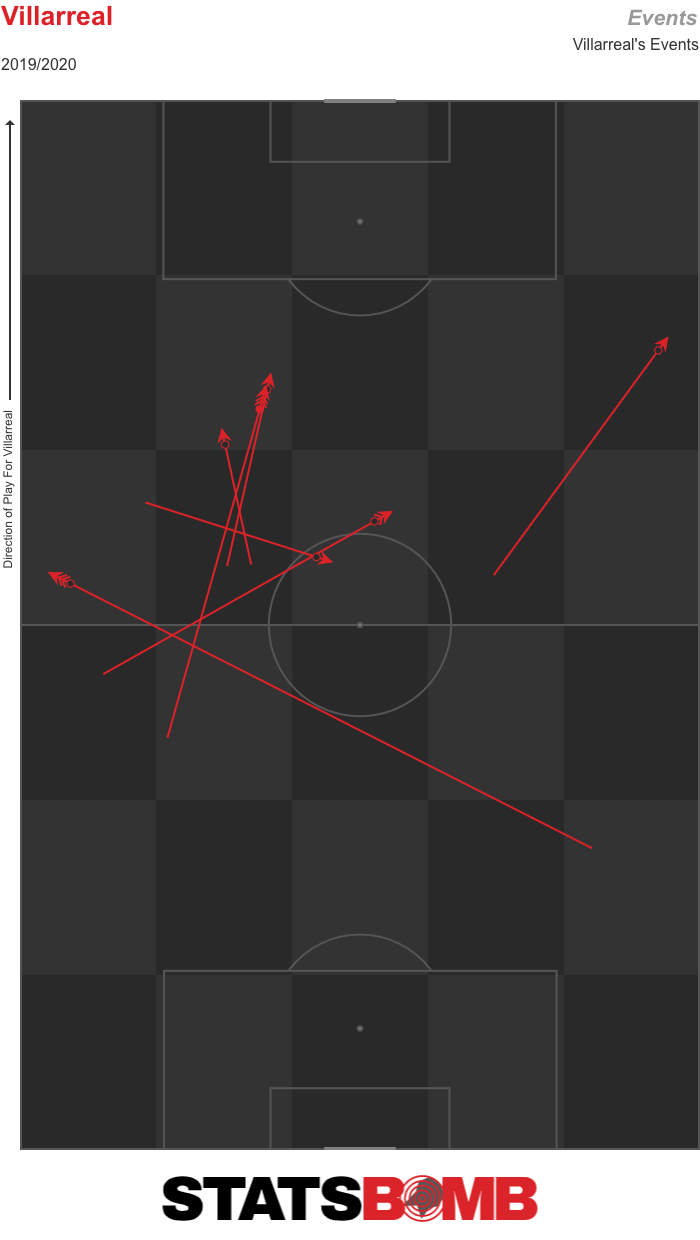 It is an environment in which a player with Alcácer’s smarts can be expected to thrive. Header image courtesy of the Press Association
It is an environment in which a player with Alcácer’s smarts can be expected to thrive. Header image courtesy of the Press Association
Have teams made upgrades? This was not a January transfer window to remember in the Premier League. Many sides largely sat it out due to the difficulty in getting things done, while others were happy with what they had. Even so, there are players who can have a big impact at their clubs down the stretch and next season. Let’s take a look at some of the bigger moves and what they might be capable of.
Oh, Bruno Fernandes, you fearless player. 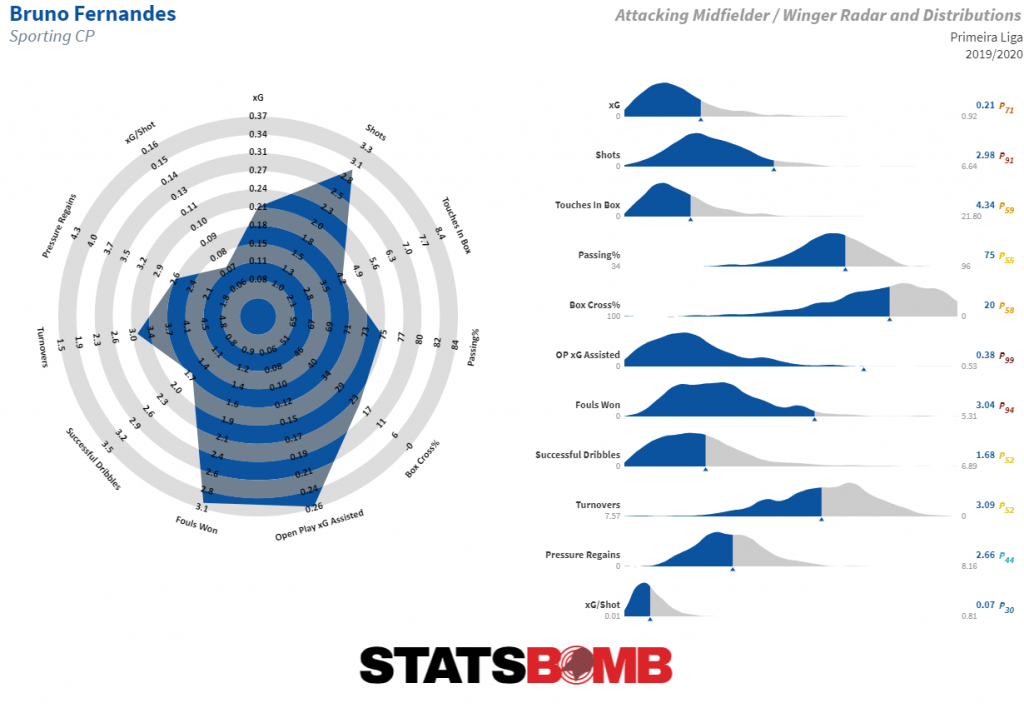 Here’s what there is to know about Fernandes: he’s an incredible playmaker. He’s been blowing the Primeira Liga away with his vision and passing range. In many regards he is to Portugal’s top flight what Kevin De Bruyne is to the Premier League, with the obvious understanding that we’re talking a significant gap in league difficulty. But here’s the issue: the way he does this is by constantly taking risks whenever he has the ball. A pass completion of 75% seems low for a top playmaker at one of the best sides in Portugal, but it makes sense when you see what he’s actually doing with the ball. He’s constantly taking risks, trying the most ambitious things in the hope, more than anything else, that they’ll pay off. Let’s start with his shot map. Fernandes likes a punt from range.
Here’s what there is to know about Fernandes: he’s an incredible playmaker. He’s been blowing the Primeira Liga away with his vision and passing range. In many regards he is to Portugal’s top flight what Kevin De Bruyne is to the Premier League, with the obvious understanding that we’re talking a significant gap in league difficulty. But here’s the issue: the way he does this is by constantly taking risks whenever he has the ball. A pass completion of 75% seems low for a top playmaker at one of the best sides in Portugal, but it makes sense when you see what he’s actually doing with the ball. He’s constantly taking risks, trying the most ambitious things in the hope, more than anything else, that they’ll pay off. Let’s start with his shot map. Fernandes likes a punt from range. 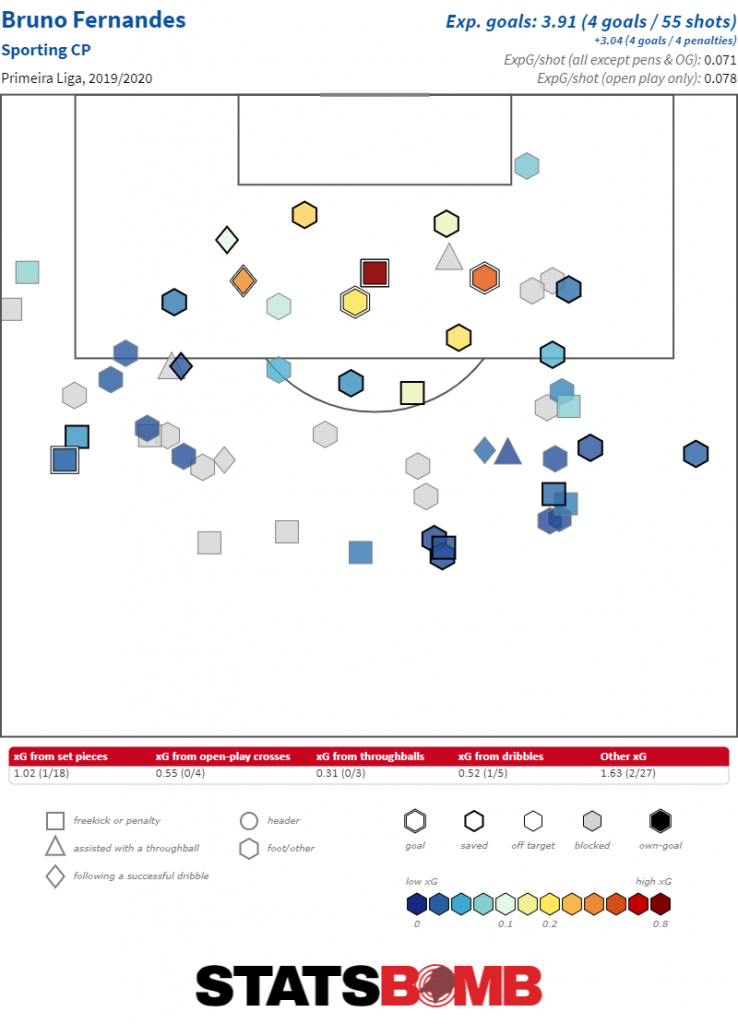 He’s a player who might be using his reputation from range to better his passing options. If a defender knows Fernandes might have a go from 30 yards, he’s more likely to rush out and close him down, opening up spaces in behind for the Portugal international to pick out a pass. But it’s not just his shooting where he’s prone to consistently bold choices.
He’s a player who might be using his reputation from range to better his passing options. If a defender knows Fernandes might have a go from 30 yards, he’s more likely to rush out and close him down, opening up spaces in behind for the Portugal international to pick out a pass. But it’s not just his shooting where he’s prone to consistently bold choices.  The passing sonar above shows us just how much he takes the riskier, more ambitious option in possession. For point of comparison, here’s another Man Utd attacking midfielder who puts up a much higher pass completion rate, but clearly chooses to play things a lot safer.
The passing sonar above shows us just how much he takes the riskier, more ambitious option in possession. For point of comparison, here’s another Man Utd attacking midfielder who puts up a much higher pass completion rate, but clearly chooses to play things a lot safer. 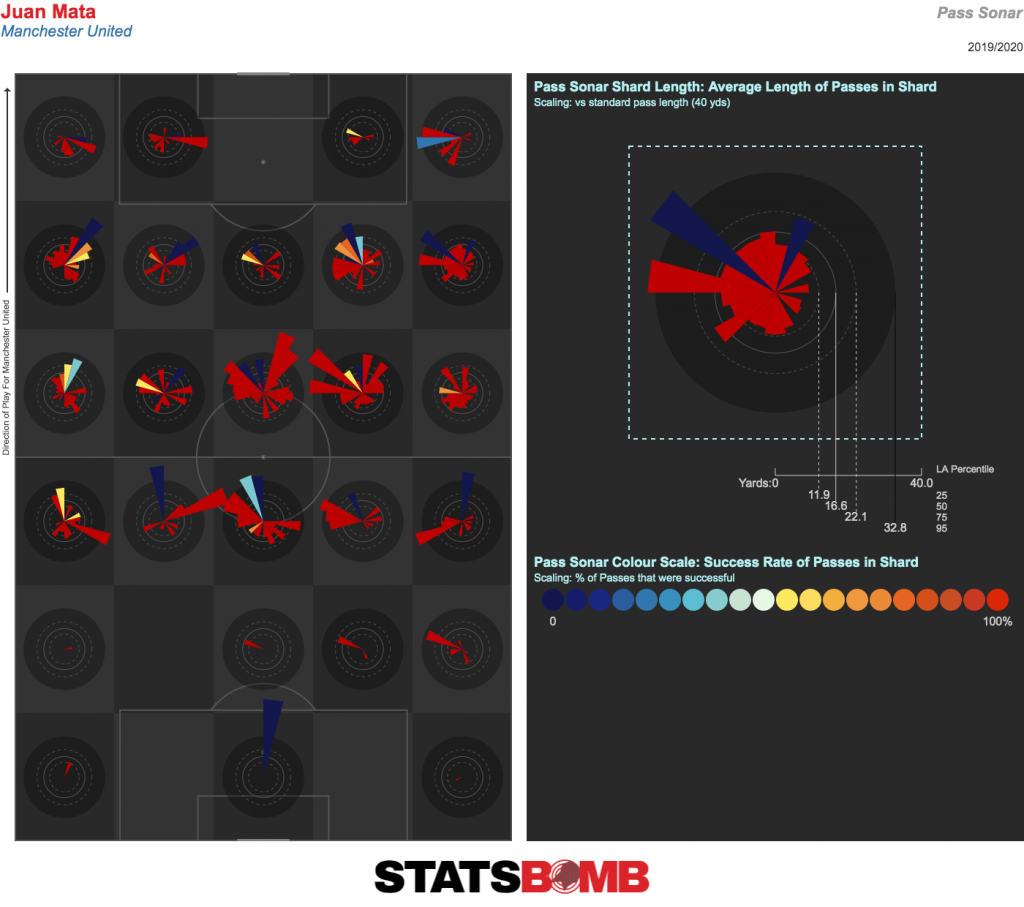 If Fernandes had signed for another big club, I might have more concerns, but he fills such a need for United that this should be a clear upgrade. In the increasingly common instances where Paul Pogba is not on the pitch, the side totally lack the creative passing threat to break teams down. Juan Mata is currently their most creative player in terms of open play passes into the box, but he’s 31 and we’re not talking Lionel Messi here. Ole Gunnar Solskjaer got exactly the type of player he needed, even if there are questions over how good he truly is.
If Fernandes had signed for another big club, I might have more concerns, but he fills such a need for United that this should be a clear upgrade. In the increasingly common instances where Paul Pogba is not on the pitch, the side totally lack the creative passing threat to break teams down. Juan Mata is currently their most creative player in terms of open play passes into the box, but he’s 31 and we’re not talking Lionel Messi here. Ole Gunnar Solskjaer got exactly the type of player he needed, even if there are questions over how good he truly is.
Well he certainly delivered a good first impression. Spurs signed Steven Bergwijn from PSV for a fee thought to be £26.7 million to fill a need from wide areas. During the Mauricio Pochettino era, much of Spurs’ best football came with the trio of Dele Alli, Christian Eriksen and Son Heung-min behind Harry Kane. Dele and Son offered shots and movements into the box, while Eriksen offered guile with the ball at his feet and Kane posed an all round centre forward threat. It’s no secret that Eriksen had one foot out the door long before he officially joined Inter, and Spurs had been planning for this in the summer. Giovani Lo Celso had been signed as Pochettino’s idea of an Eriksen replacement, but Jose Mourinho sees things differently, with the playmaker thriving more recently in a central midfield role. Kane’s absence has led to Lucas Moura taking up the striking role, leaving only Dele and Son as obvious attacking midfield starters. Mourinho doesn’t need as much passing threat, and has all he wants from Lo Celso in a deeper role. What he really wants is a direct running wide player, who can offer a robust dribbling threat but defensive solidity. Enter Bergwijn. His numbers are somewhat down from last year (in blue, while 18/19 is in red), and you’d hope it’s just an issue with PSV. But he still looks solid regardless.  The success rate of transfers from the Eredivisie to the Premier League is what it is. But nonetheless, Bergwijn looks a good fit for what Mourinho is going to want from a winger in this team. It might not be the most exciting comparison, but he could have his new Willian in Bergwijn. The best case scenario is that he translates everything he’s done in the Netherlands into being a genuine star, but a more modest outcome would still prove a good signing.
The success rate of transfers from the Eredivisie to the Premier League is what it is. But nonetheless, Bergwijn looks a good fit for what Mourinho is going to want from a winger in this team. It might not be the most exciting comparison, but he could have his new Willian in Bergwijn. The best case scenario is that he translates everything he’s done in the Netherlands into being a genuine star, but a more modest outcome would still prove a good signing.
First of all, I like Jarrod Bowen. His xG and xG assisted per 90 in the Championship this season has been bettered only by Nahki Wells and Patrick Bamford (if he could just learn how to finish). He’s the right age at 23, left footed, and able to get plenty of good shots despite starting in wide areas. Those players are always valuable.  He has beaten his expected goals this season, but the fundamentals are still strong.
He has beaten his expected goals this season, but the fundamentals are still strong. 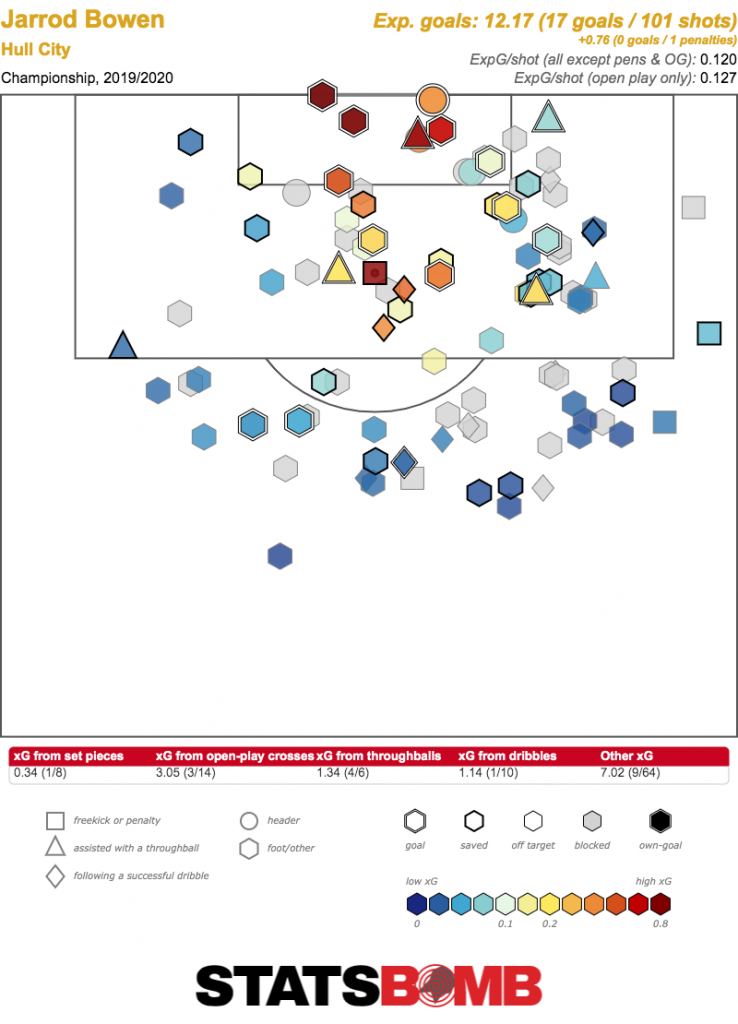 The real question, then, is how he fits into David Moyes’ side. The Hammers’ biggest need for many years has been in central midfield. They have addressed this with Tomáš Souček, but it’s really hard to gauge how a player from the Czech First League will do in England’s top flight. Moyes has been starting the also left footed Robert Snodgrass on the right since his return to the London Stadium, and while we’re looking at a small sample size here, it’s hard to imagine there isn’t room for improvement.
The real question, then, is how he fits into David Moyes’ side. The Hammers’ biggest need for many years has been in central midfield. They have addressed this with Tomáš Souček, but it’s really hard to gauge how a player from the Czech First League will do in England’s top flight. Moyes has been starting the also left footed Robert Snodgrass on the right since his return to the London Stadium, and while we’re looking at a small sample size here, it’s hard to imagine there isn’t room for improvement. 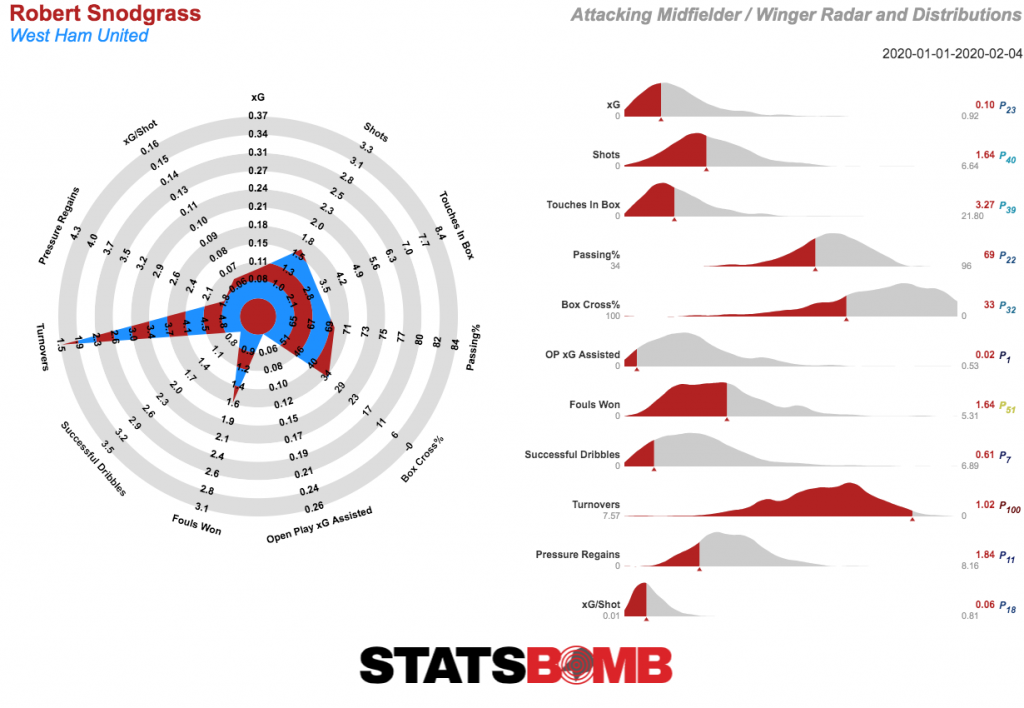 The concern is that Moyes’ style won’t exactly encourage Bowen to get into the box a lot. There’s nothing innately wrong with using wide players conservatively, and West Ham were certainly far too open before his arrival. But I remain unsure that Bowen is the ideal player for this role. Regardless, West Ham are getting a talented player at the right age (23), with an English premium in the future. So it’s hard to see much in the way of downside.
The concern is that Moyes’ style won’t exactly encourage Bowen to get into the box a lot. There’s nothing innately wrong with using wide players conservatively, and West Ham were certainly far too open before his arrival. But I remain unsure that Bowen is the ideal player for this role. Regardless, West Ham are getting a talented player at the right age (23), with an English premium in the future. So it’s hard to see much in the way of downside.
Liverpool’s signing of Takumi Minamino from Red Bull Salzburg feels like it happened so long ago that it's strange to include him on this list. Everyone knows how good the Reds’ front three are, so there’s no need to discuss that, but when the fourth choice attacker is Divock Origi (who has his uses, but remains a limited player), it’s understandable that you’d want to go into the market to find someone. The top line numbers point to this deal making a lot of sense. 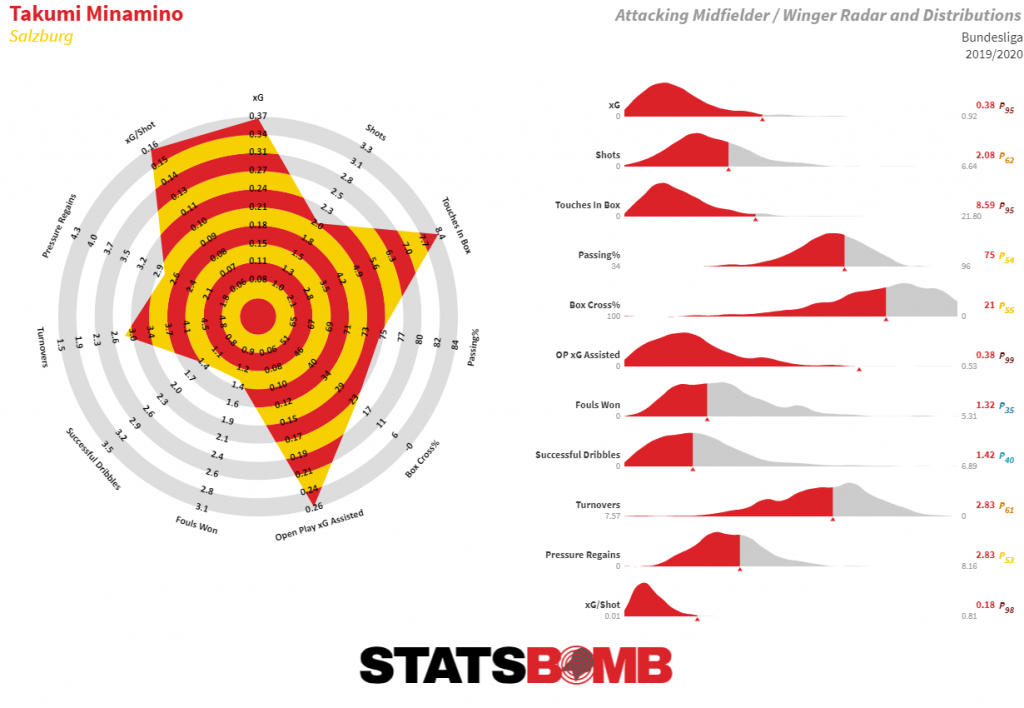 Minamino can also offer flexibility. As the Japan international’s former assistant manager (and friend of StatsBomb) René Marić has explained, Minamino is “normally best as [a number ten], but can play as a forward/striker or winger, too”, while he has also played at wing back and as a number eight style central midfielder. Liverpool have preferred to keep a relatively thin squad behind a strong starting eleven in recent years, so someone who can fill in for a number of players is useful. Thus far, he has featured as an alternative to Roberto Firmino in the false nine role without really looking up to speed. While adapting to the Premier League could take time, he shouldn’t have too much issue learning the pressing system that isn’t a million miles away from Red Bull’s approach. Even if this doesn’t pay off, for a low fee it’s a relatively risk free move for Liverpool.
Minamino can also offer flexibility. As the Japan international’s former assistant manager (and friend of StatsBomb) René Marić has explained, Minamino is “normally best as [a number ten], but can play as a forward/striker or winger, too”, while he has also played at wing back and as a number eight style central midfielder. Liverpool have preferred to keep a relatively thin squad behind a strong starting eleven in recent years, so someone who can fill in for a number of players is useful. Thus far, he has featured as an alternative to Roberto Firmino in the false nine role without really looking up to speed. While adapting to the Premier League could take time, he shouldn’t have too much issue learning the pressing system that isn’t a million miles away from Red Bull’s approach. Even if this doesn’t pay off, for a low fee it’s a relatively risk free move for Liverpool.
If the table hadn’t told you already, Sheffield United’s signing of Sander Berge from Genk made it obvious: the Blades are here to stay. Chris Wilder’s side has relied on a midfield three of Oliver Norwood, John Fleck and John Lundstram to keep things compact in the centre of the park. This has been effective, but it’s understandable that they might look for a little more sparkle here without sacrificing what’s worked. 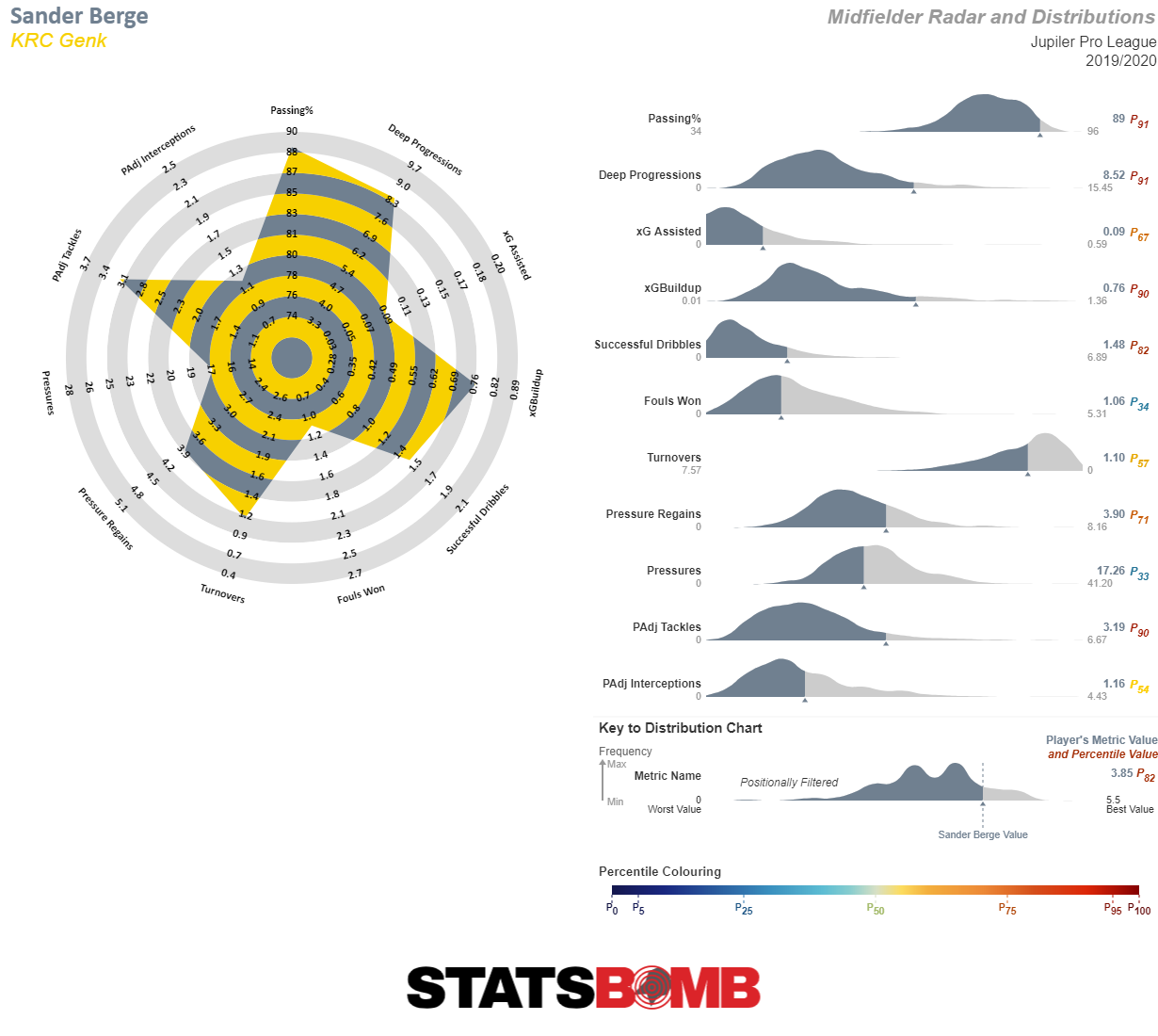 Berge is a good all rounder of a midfielder. He can pass and dribble well while putting up decent defensive work, and he stands at all of 6’5. Typically one might expect a player of his technique and mobility to lack in stature, so it’s a real bonus that he’s so big. There’s obviously going to be a steep adaptation curve from Belgium, but at age 21, this should all be doable and it’s hard to find fault in this deal.
Berge is a good all rounder of a midfielder. He can pass and dribble well while putting up decent defensive work, and he stands at all of 6’5. Typically one might expect a player of his technique and mobility to lack in stature, so it’s a real bonus that he’s so big. There’s obviously going to be a steep adaptation curve from Belgium, but at age 21, this should all be doable and it’s hard to find fault in this deal.
Wolves signed another Portuguese player. Drink. 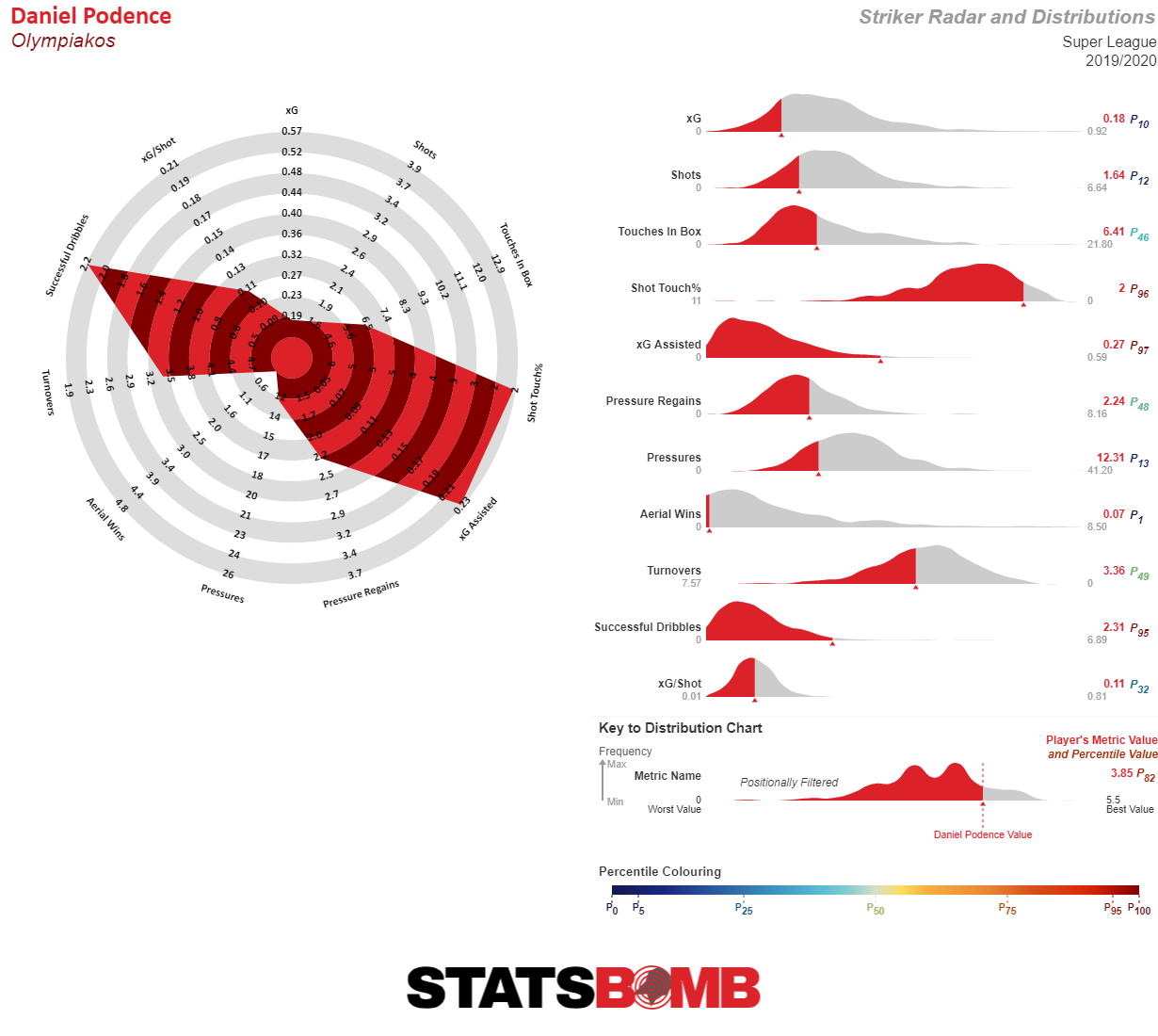 Nuno Espirito Santo seems wed to his 3-4-3 system, with Adama Traoré and Diogo Jota either side of Raúl Jiménez. Traoré has been receiving a lot of hype this year, with his out-of-this-world dribbling ability finally being met with better decision making in the final third. Jota, meanwhile, has been putting up strong numbers, taking or assisting just under half an expected goal a game. Pedro Neto hasn’t been too far behind in his contributions as the third choice option. It’s not really clear why Wolves felt they needed Podence. Perhaps he is a rotation option. Perhaps they are intending to sell one of the current attackers in the summer and want to give the new man time to bed in. Perhaps they think he is better than the good-for-Greece numbers he’s putting up in our data. Regardless, this one is slightly perplexing in purely footballing terms.
Nuno Espirito Santo seems wed to his 3-4-3 system, with Adama Traoré and Diogo Jota either side of Raúl Jiménez. Traoré has been receiving a lot of hype this year, with his out-of-this-world dribbling ability finally being met with better decision making in the final third. Jota, meanwhile, has been putting up strong numbers, taking or assisting just under half an expected goal a game. Pedro Neto hasn’t been too far behind in his contributions as the third choice option. It’s not really clear why Wolves felt they needed Podence. Perhaps he is a rotation option. Perhaps they are intending to sell one of the current attackers in the summer and want to give the new man time to bed in. Perhaps they think he is better than the good-for-Greece numbers he’s putting up in our data. Regardless, this one is slightly perplexing in purely footballing terms.
Where else can you find the likes of Demba Ba and Robinho sitting on one team’s bench? Welcome to the Turkish Süper Lig — the land where old players on crazy salaries parachute in as one of their final stops on the way to retirement and mingle with domestic up and coming stars. It may not be your first destination to watch high-quality football, but if you’re looking for some world-class derby atmospheres, genuine excitement and a 7-way title race, you’re at the right place.
Global citizens of football who regularly check what’s going on in leagues around the world likely have been wondering what magic touch suddenly turned Sivasspor into a title contender after years of mediocrity. Sivasspor has owned the top spot for a while now, 2 points clear of second-place Başakşehir and 5 points clear of holders Galatasaray. Journeyman manager Rıza Çalımbay is in his 16th (!) spell coaching a side in Süper Lig since starting his career in 2001. Did he finally develop into a top-level coach able to mount a successful title challenge with underdogs? Well, with all due respect, no. Sivasspor is massively overperforming their underlying numbers, scoring 8 goals more than their expected goals and conceding 3.5 less for a staggering 11.5 goals overperformance. Take out half those goals and they're a mid-table side, which is probably where they belong. 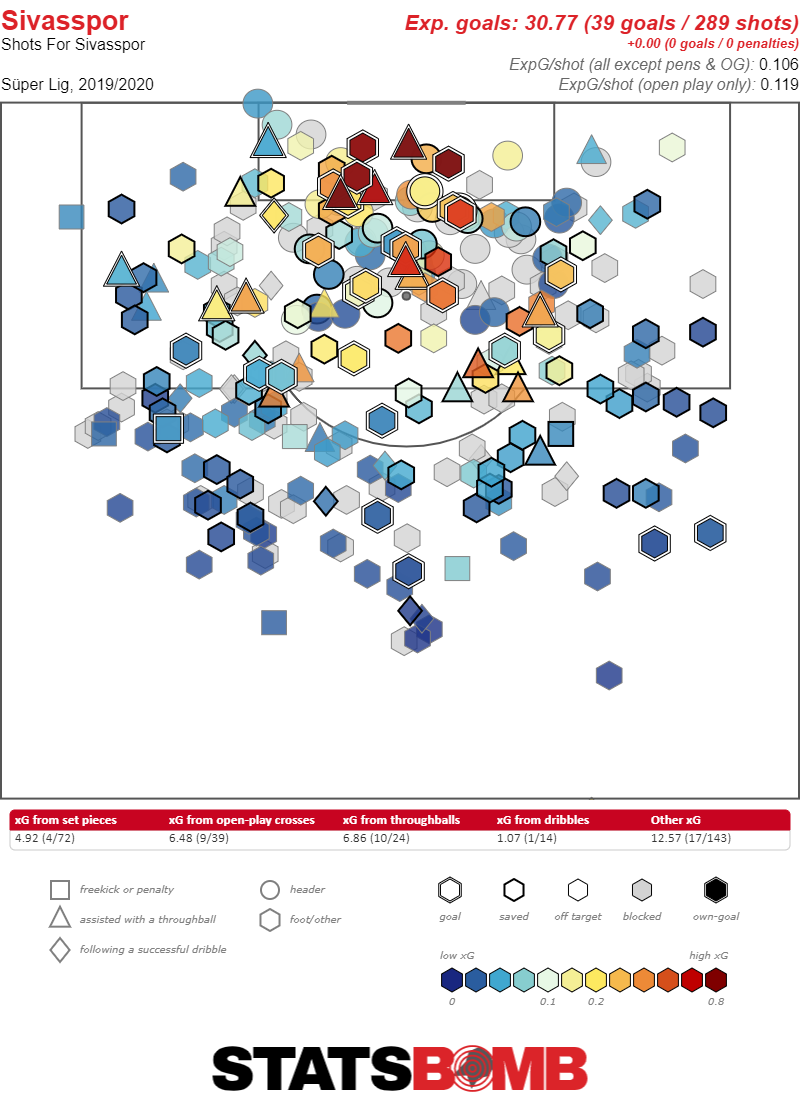 The gods of mean reversion are already meddling, as Gaziantep ran riot over the weekend, trouncing Sivasspor 5–1 with a handful of low xG shots while Sivasspor missed some sitters.
The gods of mean reversion are already meddling, as Gaziantep ran riot over the weekend, trouncing Sivasspor 5–1 with a handful of low xG shots while Sivasspor missed some sitters.  This is not to say they don’t deserve credit. Çalımbay is an above-average reactive coach for Turkey standards, capable of putting together disciplined, gritty sides that love to cause trouble for bigger teams. He masterminded two impressive victories of late against Fenerbahçe and Beşiktaş, fielding his left back Ziya Erdal as a left central midfielder in both, successfully disrupting opposition buildup play with intense pressure. However, Çalımbay deserves the most credit for summer signings Mamadou Samassa, Aaron Appindangoyé, Caner Osmanpaşa, Marcelo Goiano, Fernando Andrade (loan) and Mustapha Yatabaré, all impressively joining on a free transfer and becoming first-team regulars (and yes, that is the Süper Lig understanding of "team building"). Add previously underrated legacy players Mert Hakan Yandaş, Emre Kılınç and Hakan Arslan to that mix and Sivasspor have themselves a proper team with impressive physicality and firepower. Let’s start with the goalkeeper. Overperforming non-penalty xG can mean good fortune or bad finishing from opponents, but more often than not it also means a spectacular goalkeeping performance. Those performances, however, can be fickle. Signed from Ligue 2 side Troyes, Mamadou Samassa had the 3rd best shot-stopping performance in the league, conceding 5 goals less than the post-shot xG total of the shots he faced — until the Gaziantep match, where he suddenly and painfully returned to earth. Combine that match with the howler Samassa conceded last week against Rizespor as Sivasspor barely saved a point at the last minute, and what you’re left with is a barely above-average keeper. Stats have a bad habit of catching up with you.
This is not to say they don’t deserve credit. Çalımbay is an above-average reactive coach for Turkey standards, capable of putting together disciplined, gritty sides that love to cause trouble for bigger teams. He masterminded two impressive victories of late against Fenerbahçe and Beşiktaş, fielding his left back Ziya Erdal as a left central midfielder in both, successfully disrupting opposition buildup play with intense pressure. However, Çalımbay deserves the most credit for summer signings Mamadou Samassa, Aaron Appindangoyé, Caner Osmanpaşa, Marcelo Goiano, Fernando Andrade (loan) and Mustapha Yatabaré, all impressively joining on a free transfer and becoming first-team regulars (and yes, that is the Süper Lig understanding of "team building"). Add previously underrated legacy players Mert Hakan Yandaş, Emre Kılınç and Hakan Arslan to that mix and Sivasspor have themselves a proper team with impressive physicality and firepower. Let’s start with the goalkeeper. Overperforming non-penalty xG can mean good fortune or bad finishing from opponents, but more often than not it also means a spectacular goalkeeping performance. Those performances, however, can be fickle. Signed from Ligue 2 side Troyes, Mamadou Samassa had the 3rd best shot-stopping performance in the league, conceding 5 goals less than the post-shot xG total of the shots he faced — until the Gaziantep match, where he suddenly and painfully returned to earth. Combine that match with the howler Samassa conceded last week against Rizespor as Sivasspor barely saved a point at the last minute, and what you’re left with is a barely above-average keeper. Stats have a bad habit of catching up with you. 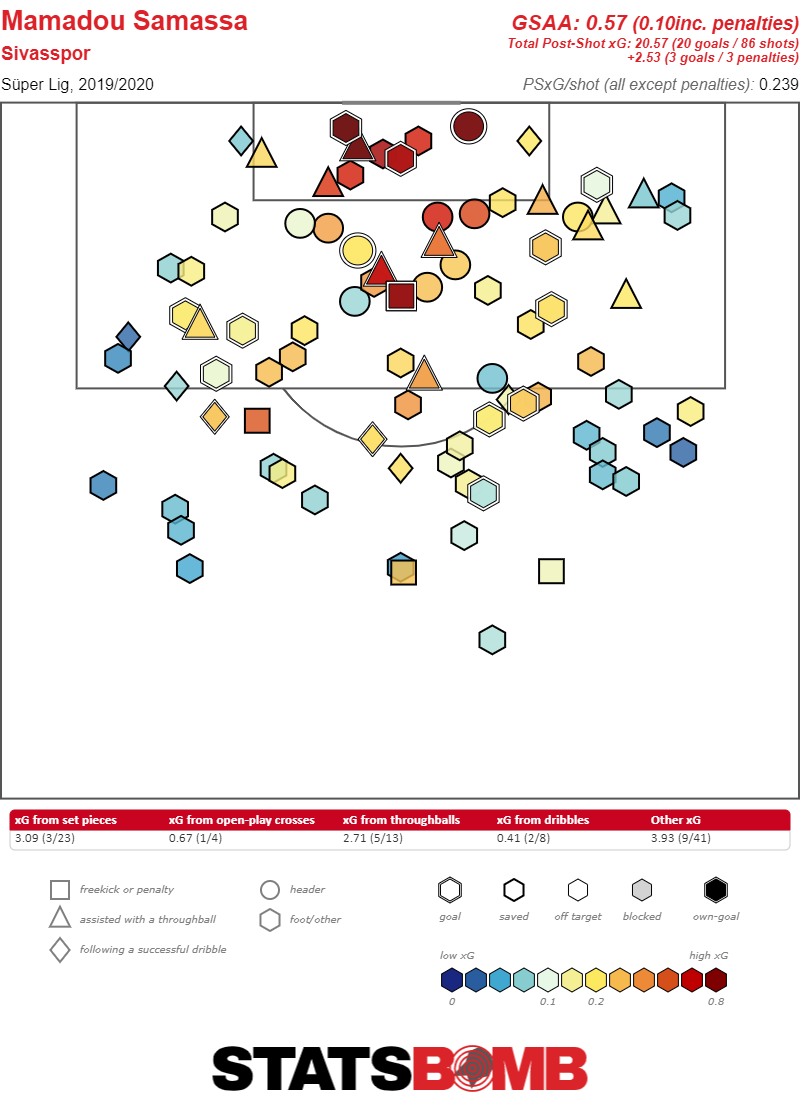 From their attacking radar, Sivasspor looks like one of the better attacking teams in the division. Their traditional, direct style is evident in their league-average GK pass length and high ratio of crosses versus passes into the box. They create many chances as a result of pressure regains, which is one of the key differentiators that helped them reach the top. The defensive radar, on the other hand, is one of a mid-table side — Sivasspor should really pray that Samassa keeps it up.
From their attacking radar, Sivasspor looks like one of the better attacking teams in the division. Their traditional, direct style is evident in their league-average GK pass length and high ratio of crosses versus passes into the box. They create many chances as a result of pressure regains, which is one of the key differentiators that helped them reach the top. The defensive radar, on the other hand, is one of a mid-table side — Sivasspor should really pray that Samassa keeps it up. 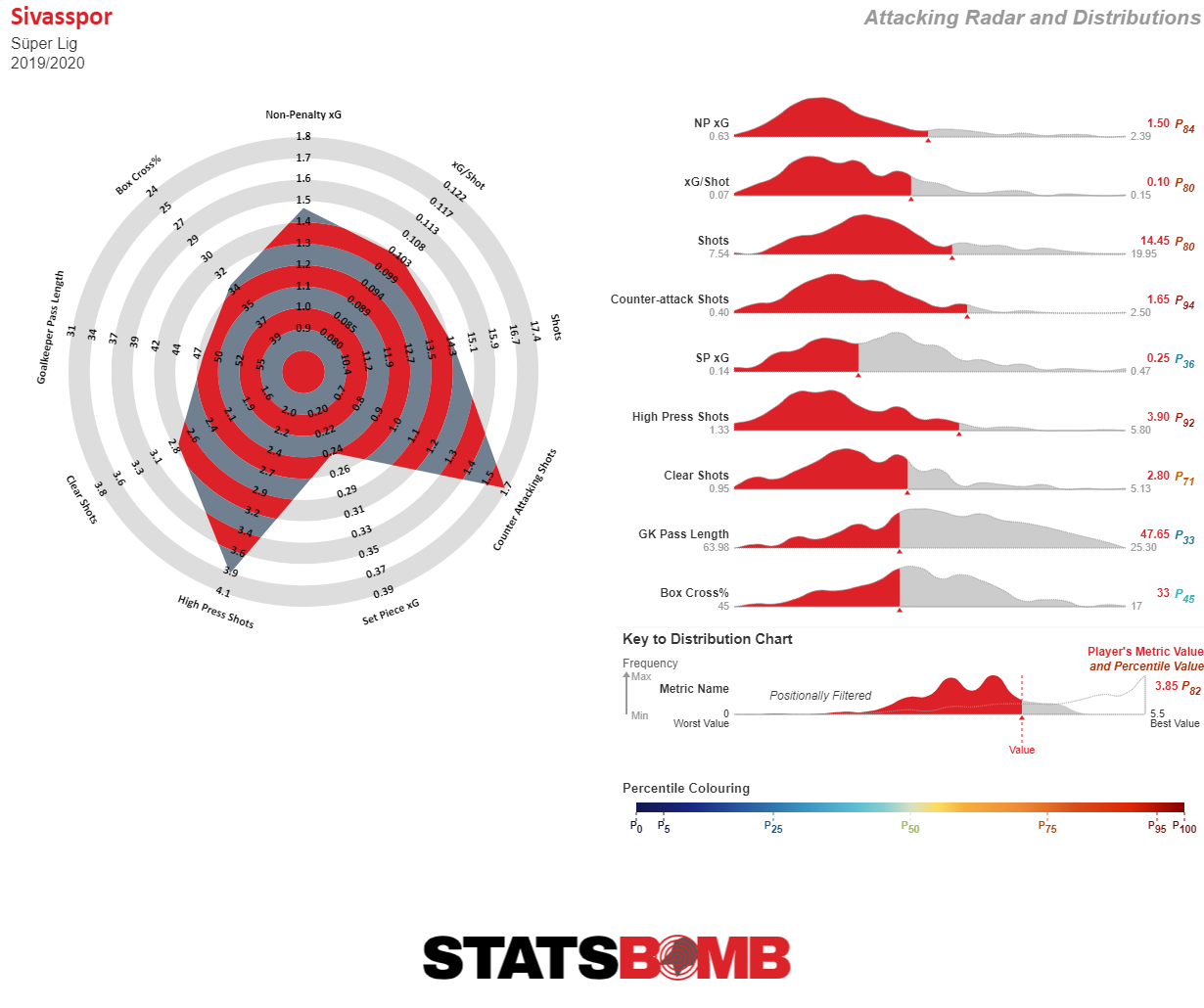 Sivasspor’s attackers are overperforming heavily with 8 goals more than their expected goals, but at least their goals are distributed nicely — Yatabaré has 8, Kılınç has 6, Fernando and Arslan have 5, and three others have 4 each. We don’t have Süper Lig data before this season, but this is Yatabaré’s fifth in Turkey and the 34-year-old striker never scored more than 6 goals in a season. That source might dry up soon for Sivasspor. Mert Hakan Yandaş is the one grabbing most of the headlines lately with a place in Turkey’s EURO 2020 squad becoming a real possibility — he’s an all-round, hard-working offensive midfielder who does a bit of everything and is slightly above average at it all, as seen in his radar. He pretty much enjoys a free role as the main creative outlet of the side. His starting position varies between a #8 and a #10. From there, he often ends up where the ball is and dictates play in the offensive areas. He should be regarded as an offensive midfielder, but his deep progressions also look impressive at 7 per game (79th percentile among midfielders), considering his starting position is often higher up the pitch. Perhaps a little early to jump on the hype train, but the potential is there to flourish in a better team.
Sivasspor’s attackers are overperforming heavily with 8 goals more than their expected goals, but at least their goals are distributed nicely — Yatabaré has 8, Kılınç has 6, Fernando and Arslan have 5, and three others have 4 each. We don’t have Süper Lig data before this season, but this is Yatabaré’s fifth in Turkey and the 34-year-old striker never scored more than 6 goals in a season. That source might dry up soon for Sivasspor. Mert Hakan Yandaş is the one grabbing most of the headlines lately with a place in Turkey’s EURO 2020 squad becoming a real possibility — he’s an all-round, hard-working offensive midfielder who does a bit of everything and is slightly above average at it all, as seen in his radar. He pretty much enjoys a free role as the main creative outlet of the side. His starting position varies between a #8 and a #10. From there, he often ends up where the ball is and dictates play in the offensive areas. He should be regarded as an offensive midfielder, but his deep progressions also look impressive at 7 per game (79th percentile among midfielders), considering his starting position is often higher up the pitch. Perhaps a little early to jump on the hype train, but the potential is there to flourish in a better team.  All in all, a total xG overperformance of 11.5 goals is way too much, even after the weekend’s match, and Sivasspor fans should enjoy the top while it lasts, as they most likely won’t win the league. As is the issue with many reactive overachieving underdogs, more and more teams are sitting deeper and playing cautious against Sivasspor, and the side looks short of ideas when they have possession that, in essence, they don’t want. Who’ll win it then? Let’s take a look at the underlying numbers of the league.
All in all, a total xG overperformance of 11.5 goals is way too much, even after the weekend’s match, and Sivasspor fans should enjoy the top while it lasts, as they most likely won’t win the league. As is the issue with many reactive overachieving underdogs, more and more teams are sitting deeper and playing cautious against Sivasspor, and the side looks short of ideas when they have possession that, in essence, they don’t want. Who’ll win it then? Let’s take a look at the underlying numbers of the league. 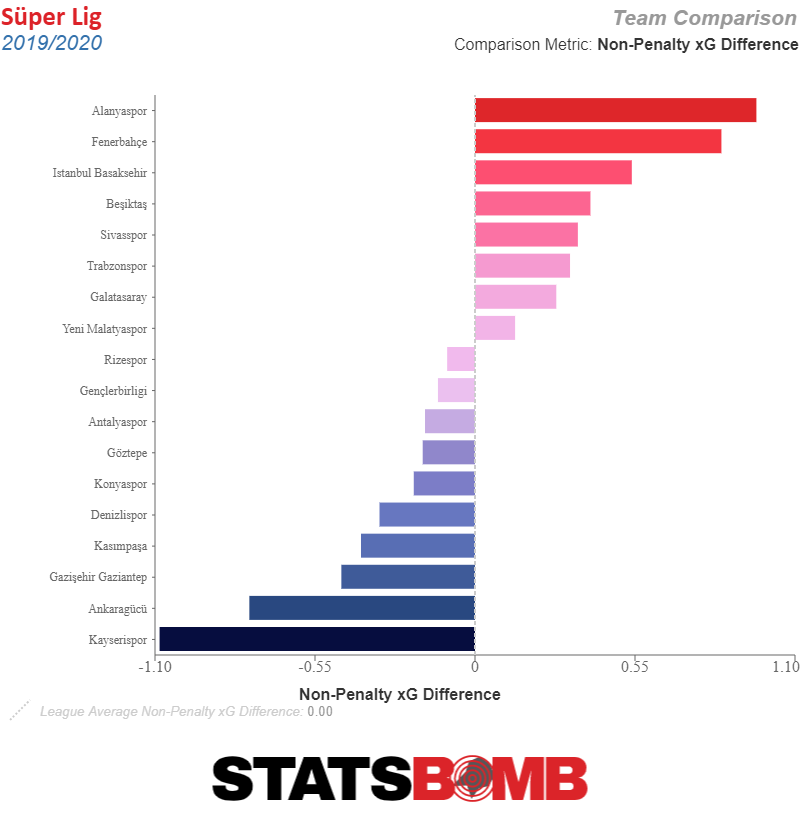 Well, if any underdog is going to win Süper Lig this year, that is more likely to be the Papiss Cissé-led Alanyaspor. Coached by 44-year-old Germany born Erol Bulut who grabbed attention in his previous spell at Yeni Malatyaspor as well, Alanyaspor has excellent underlying numbers and look a viable dark horse trailing just three points behind the Sivasspor hype. And Newcastle fans — Papiss Cissé is still quite good.
Well, if any underdog is going to win Süper Lig this year, that is more likely to be the Papiss Cissé-led Alanyaspor. Coached by 44-year-old Germany born Erol Bulut who grabbed attention in his previous spell at Yeni Malatyaspor as well, Alanyaspor has excellent underlying numbers and look a viable dark horse trailing just three points behind the Sivasspor hype. And Newcastle fans — Papiss Cissé is still quite good.  Then we have Fenerbahçe, who have the best underlying numbers after Alanyaspor and looked the favorites after beating Başakşehir 2-0 last week, but an unlucky loss this weekend at Trabzonspor sent them back to 5th. Still, they should be regarded as one of the main candidates to win the title. Fenerbahçe is the most dominant side in the league, suffocating opponents in their own half with a lot of possession and counter pressure, but often suffer from poor execution in the final third. Except Vedat Muriqi, of course. The gigantesque figure of the Kosovan striker has been a nightmare to deal with for Süper Lig defenders all season. Muriqi’s all-round game has been excellent — he barely loses an aerial duel, links up play very well, moves intelligently and finishes chances. Contrary to what Galatasaray fans initially thought, losing the Muriqi bidding war really did move the needle towards Fenerbahçe this season, despite their club signing Falcao.
Then we have Fenerbahçe, who have the best underlying numbers after Alanyaspor and looked the favorites after beating Başakşehir 2-0 last week, but an unlucky loss this weekend at Trabzonspor sent them back to 5th. Still, they should be regarded as one of the main candidates to win the title. Fenerbahçe is the most dominant side in the league, suffocating opponents in their own half with a lot of possession and counter pressure, but often suffer from poor execution in the final third. Except Vedat Muriqi, of course. The gigantesque figure of the Kosovan striker has been a nightmare to deal with for Süper Lig defenders all season. Muriqi’s all-round game has been excellent — he barely loses an aerial duel, links up play very well, moves intelligently and finishes chances. Contrary to what Galatasaray fans initially thought, losing the Muriqi bidding war really did move the needle towards Fenerbahçe this season, despite their club signing Falcao. 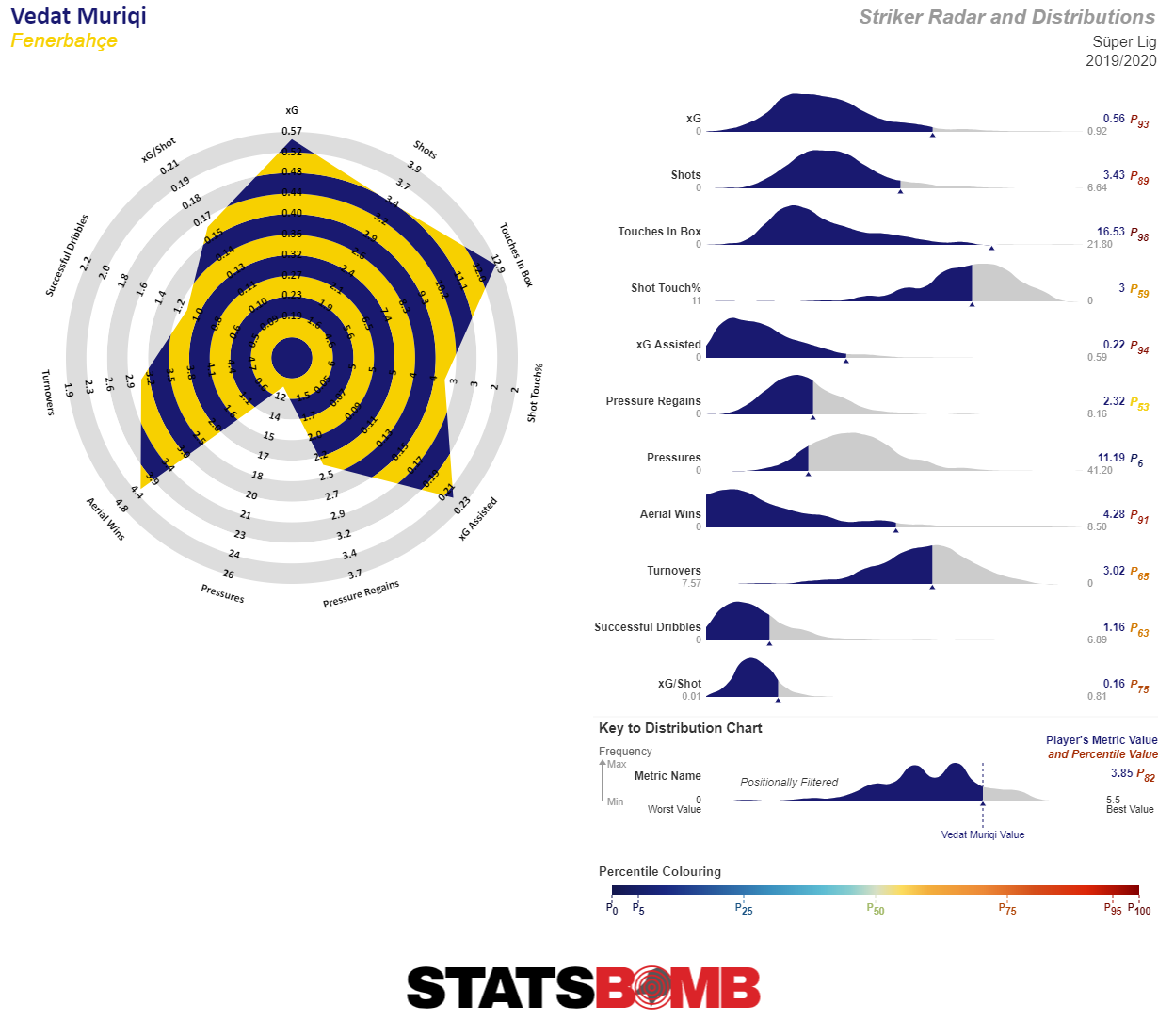 It's not quite correct to say there's nothing tactically interesting going on in this league, it’s just that Turkish media haven't really figured it out yet. Fatih Terim is on course to launch yet another Galatasaray comeback following a dreadful first half of the season with a significant tactical shift not often seen at Süper Lig level. Nicknamed “the Emperor,” Terim is by far the highest-profile coach in Turkey, having won the UEFA Cup with Galatasaray in 2000, followed by brief stints at Milan and Fiorentina. He’s responsible for 8 out of Galatasaray's 22 league titles, which is pretty crazy if you think about it. After a dismal first half of the season plagued by injuries, late returns from the Africa Cup of Nations and last-minute loan signings who spent their entire summers on holiday, Terim has been reshuffling his cards since the impressive 5–0 home win against Antalyaspor — by far the best game of the season for the Red and Yellows. Terim came up with a hybrid system, 4-2-3-1 on paper and a 3-5-1-1 in possession, with Mario Lemina strictly positioning himself next to the center backs to form a back three and Jean-Michael Seri acting as a regista in front of the trio. Fullbacks pushed high, wide players Ömer Bayram and Sofiane Feghouli tucked in and all of a sudden Galatasaray ended up with a setup looking dangerously good on a late December night, demolishing Antalyaspor by the largest xG margin recorded in the league in any game this season.
It's not quite correct to say there's nothing tactically interesting going on in this league, it’s just that Turkish media haven't really figured it out yet. Fatih Terim is on course to launch yet another Galatasaray comeback following a dreadful first half of the season with a significant tactical shift not often seen at Süper Lig level. Nicknamed “the Emperor,” Terim is by far the highest-profile coach in Turkey, having won the UEFA Cup with Galatasaray in 2000, followed by brief stints at Milan and Fiorentina. He’s responsible for 8 out of Galatasaray's 22 league titles, which is pretty crazy if you think about it. After a dismal first half of the season plagued by injuries, late returns from the Africa Cup of Nations and last-minute loan signings who spent their entire summers on holiday, Terim has been reshuffling his cards since the impressive 5–0 home win against Antalyaspor — by far the best game of the season for the Red and Yellows. Terim came up with a hybrid system, 4-2-3-1 on paper and a 3-5-1-1 in possession, with Mario Lemina strictly positioning himself next to the center backs to form a back three and Jean-Michael Seri acting as a regista in front of the trio. Fullbacks pushed high, wide players Ömer Bayram and Sofiane Feghouli tucked in and all of a sudden Galatasaray ended up with a setup looking dangerously good on a late December night, demolishing Antalyaspor by the largest xG margin recorded in the league in any game this season. 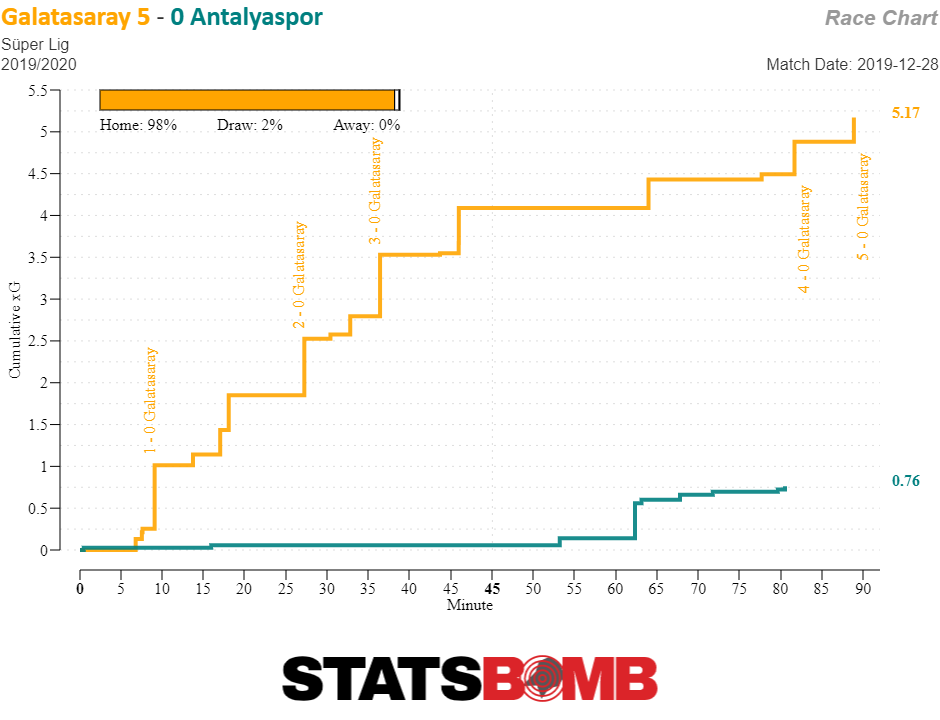 The 4-2-3-1 out of possession allows Terim to impose his desired high pressure, while the 3-1 compared to the previous 2-1 structure allows his team to build up much more effectively and contain counter-attacks better. This formation was particularly clear in the side's 2-1 victory of Denizlispor.
The 4-2-3-1 out of possession allows Terim to impose his desired high pressure, while the 3-1 compared to the previous 2-1 structure allows his team to build up much more effectively and contain counter-attacks better. This formation was particularly clear in the side's 2-1 victory of Denizlispor. 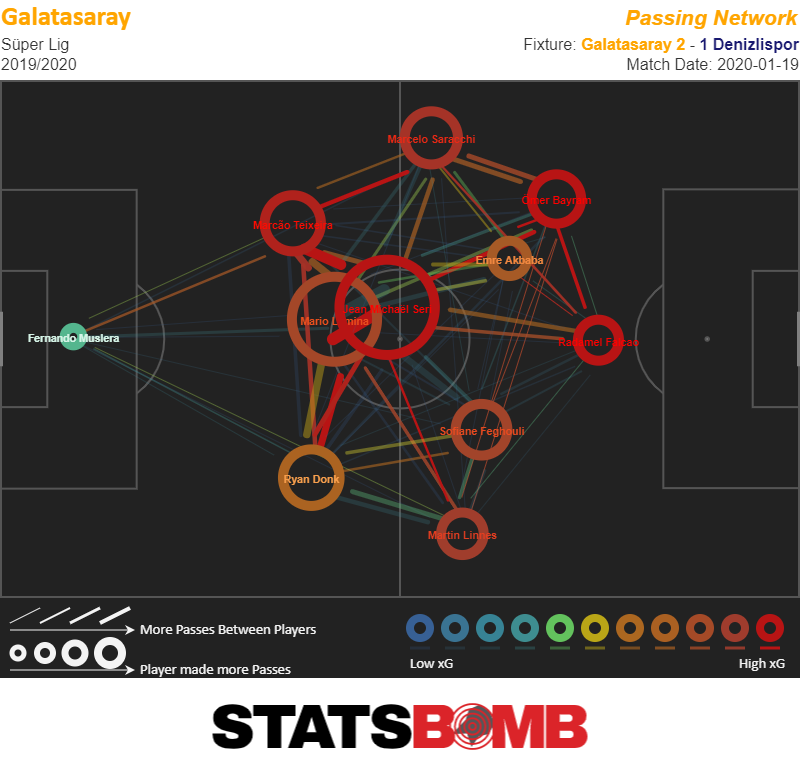 With this formation, Galatasaray have notched three wins on the bounce since, although they played slightly differently against Kayserispor in Lemina’s absence. Whether that will be enough for a comeback remains to be seen, but if any coach in Turkey can pull off a double-digit point comeback two seasons in a row, it’s Fatih Terim. What about Trabzonspor and Beşiktaş? Trabzonspor is carried on the shoulders of Alexander Sørloth, who has a strong shout for Player of the Season in Süper Lig, much to the frustration for the fans of offensively troubled Crystal Palace. Trabzonspor’s firing of Ünal Karaman baffled many in Turkey since they looked like title contenders, but their defensive underlying numbers wouldn’t prove strong enough over the course of an entire season anyway. It would be wishful thinking to think the inexperienced former player Hüseyin Çimşir could pull a rabbit out of this hat, despite beating Fenerbahçe and moving only 3 points behind Sivasspor with a game in hand.
With this formation, Galatasaray have notched three wins on the bounce since, although they played slightly differently against Kayserispor in Lemina’s absence. Whether that will be enough for a comeback remains to be seen, but if any coach in Turkey can pull off a double-digit point comeback two seasons in a row, it’s Fatih Terim. What about Trabzonspor and Beşiktaş? Trabzonspor is carried on the shoulders of Alexander Sørloth, who has a strong shout for Player of the Season in Süper Lig, much to the frustration for the fans of offensively troubled Crystal Palace. Trabzonspor’s firing of Ünal Karaman baffled many in Turkey since they looked like title contenders, but their defensive underlying numbers wouldn’t prove strong enough over the course of an entire season anyway. It would be wishful thinking to think the inexperienced former player Hüseyin Çimşir could pull a rabbit out of this hat, despite beating Fenerbahçe and moving only 3 points behind Sivasspor with a game in hand. 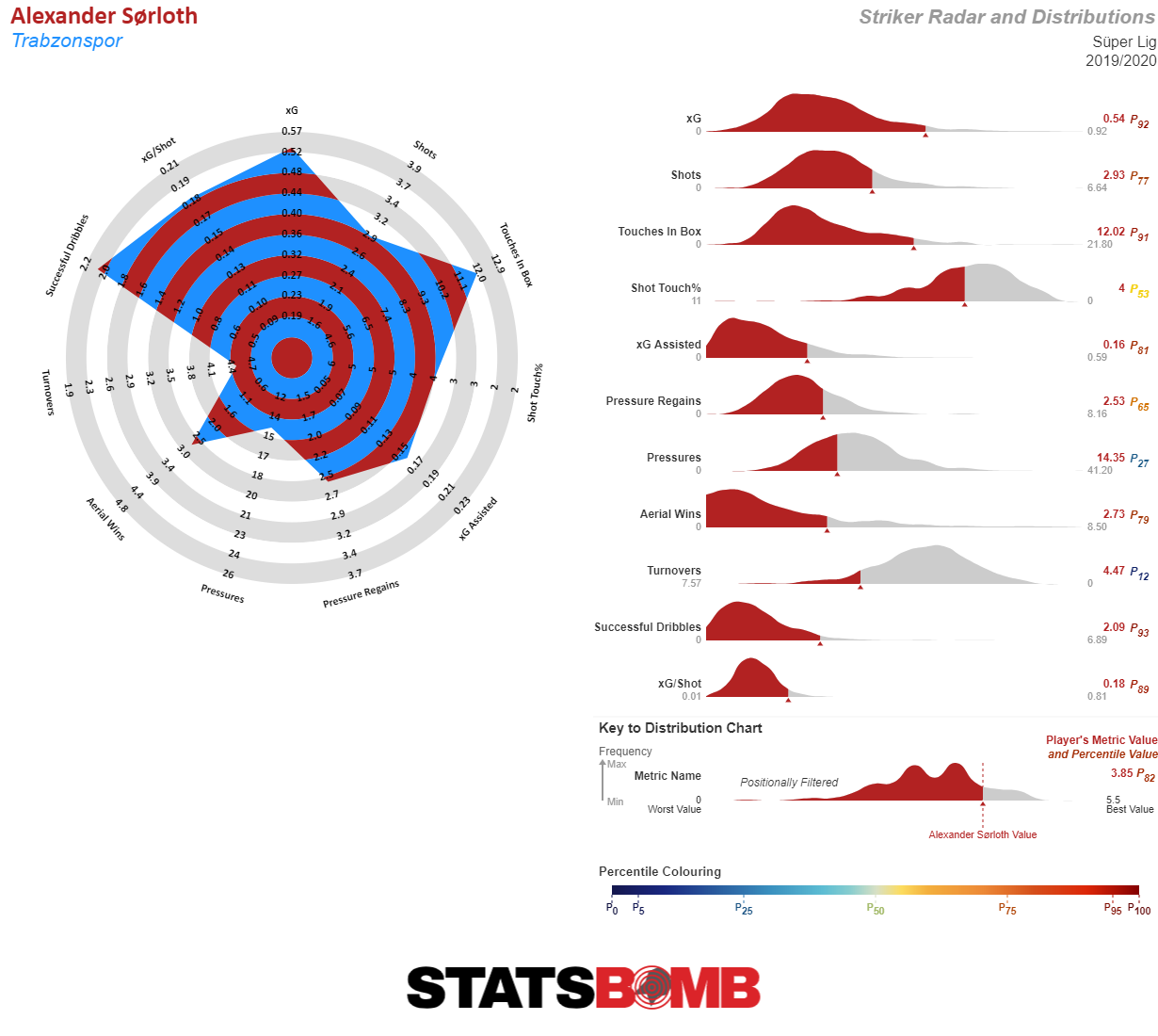 Beşiktaş also parted ways with their coach Abdullah Avcı just last week after a cup defeat to Erzurumspor. Avcı has been regarded as one of the best coaches in Turkey the past few years, transforming Başakşehir into serious title contenders from scratch. However, he found his Guardiola-inspired possession style largely impossible to impose on the Beşiktaş squad he was handed, and stayed barely alive with a series of unconvincing wins before the season collapsed on him. It would be unrealistic to expect anything from Beşiktaş, and their newly hired former player Sergen Yalçın, to pull off anything of substance. Yet Beşiktaş surprisingly boasts the second-best underlying defensive performance in the league. You know who didn’t help Avcı at all with all this? Yes — Loris Karius it is.
Beşiktaş also parted ways with their coach Abdullah Avcı just last week after a cup defeat to Erzurumspor. Avcı has been regarded as one of the best coaches in Turkey the past few years, transforming Başakşehir into serious title contenders from scratch. However, he found his Guardiola-inspired possession style largely impossible to impose on the Beşiktaş squad he was handed, and stayed barely alive with a series of unconvincing wins before the season collapsed on him. It would be unrealistic to expect anything from Beşiktaş, and their newly hired former player Sergen Yalçın, to pull off anything of substance. Yet Beşiktaş surprisingly boasts the second-best underlying defensive performance in the league. You know who didn’t help Avcı at all with all this? Yes — Loris Karius it is. 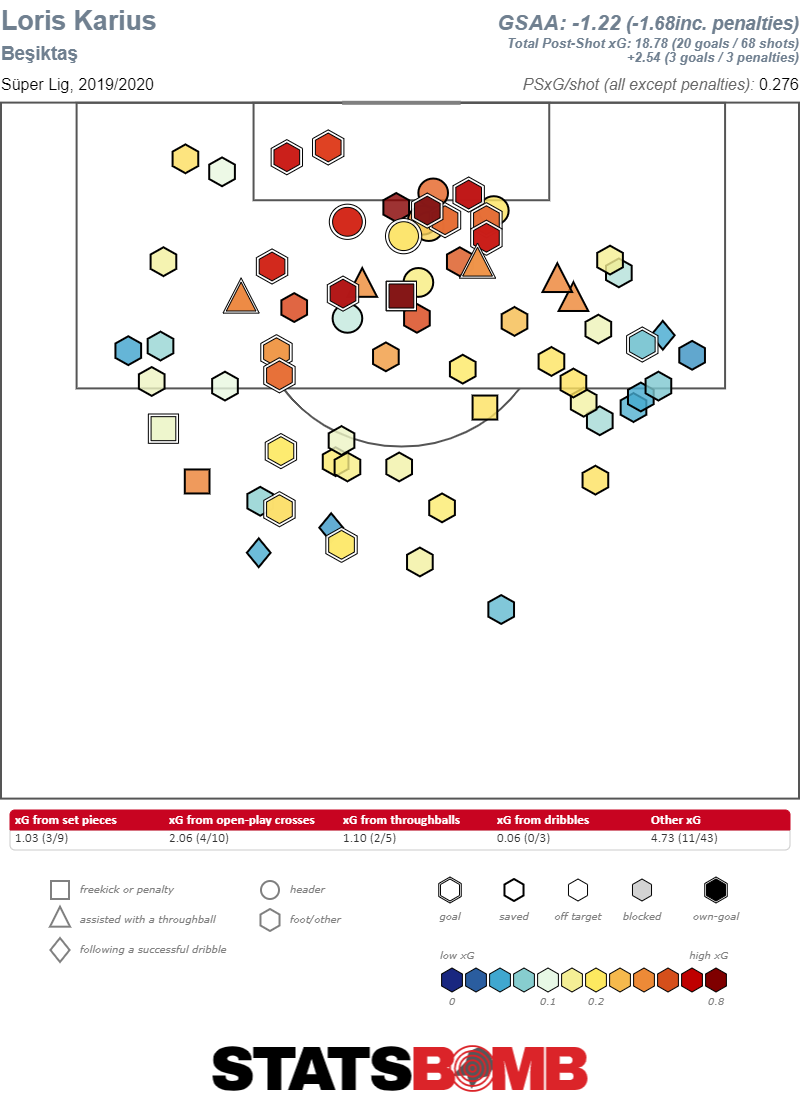 Finally, Başakşehir. The team are also looking like strong title contenders for the fourth year in a row. Former Inter player Okan Buruk has the luxury of having Robinho and Demba Ba as impact subs at Başakşehir, the “noisy neighbors” of the Istanbul giants — they had backing from government but also grew organically by trusting the process under Abdullah Avcı, transforming from an underdog playing transition football into a side that completely dominates games with 60% or more possession. Okan Buruk took them back into a side that’s largely threatening through transitions and particularly impressed by beating Gladbach away to progress from their Europa League group. Their brand of football isn’t anything special, but their right winger is. Edin Visca is tearing apart the Süper Lig yet again, and he’s probably one of the most consistent performers in all of Europe.
Finally, Başakşehir. The team are also looking like strong title contenders for the fourth year in a row. Former Inter player Okan Buruk has the luxury of having Robinho and Demba Ba as impact subs at Başakşehir, the “noisy neighbors” of the Istanbul giants — they had backing from government but also grew organically by trusting the process under Abdullah Avcı, transforming from an underdog playing transition football into a side that completely dominates games with 60% or more possession. Okan Buruk took them back into a side that’s largely threatening through transitions and particularly impressed by beating Gladbach away to progress from their Europa League group. Their brand of football isn’t anything special, but their right winger is. Edin Visca is tearing apart the Süper Lig yet again, and he’s probably one of the most consistent performers in all of Europe.  The Süper Lig is brewing up a title showdown with multiple contenders. Current leaders Sivasspor are very unlikely to win it. Instead, in the end the race looks likely to involve bitter rivals Galatasaray and Fenerbahçe, an exciting showdown that hasn't been seen often lately. Fenerbahçe – Galatasaray on February 23 could be a proper momentum decider. Fenerbahçe’s loss to Trabzonspor moved Galatasaray within a point, and they host Alanyaspor in the next matchday, while Galatasaray have relatively easy fixtures ahead before traveling to the Asian side of Istanbul for the Intercontinental Derby, an absolute much watch. For now, in terms of underlying performances, Fenerbahçe, Başakşehir and Alanyaspor look strong enough to fight for the top spot, but don’t rule out holders Galatasaray — Terim’s formation change might have a “Conte effect” on Süper Lig teams.
The Süper Lig is brewing up a title showdown with multiple contenders. Current leaders Sivasspor are very unlikely to win it. Instead, in the end the race looks likely to involve bitter rivals Galatasaray and Fenerbahçe, an exciting showdown that hasn't been seen often lately. Fenerbahçe – Galatasaray on February 23 could be a proper momentum decider. Fenerbahçe’s loss to Trabzonspor moved Galatasaray within a point, and they host Alanyaspor in the next matchday, while Galatasaray have relatively easy fixtures ahead before traveling to the Asian side of Istanbul for the Intercontinental Derby, an absolute much watch. For now, in terms of underlying performances, Fenerbahçe, Başakşehir and Alanyaspor look strong enough to fight for the top spot, but don’t rule out holders Galatasaray — Terim’s formation change might have a “Conte effect” on Süper Lig teams.
The first half of the Bundesliga season was characterized by a crowd atop the league table. Now, a couple weeks into the second go-round of the league we — inevitably — are seeing a few teams come back down to earth, with Schalke 04 and SC Freiburg as prime examples of ‘over-performers’ who simply cannot maintain their hot finishing streak any longer. But here at StatsBomb, we choose to value fun stuff above a grim come-down story. So, in that light, we examine the two Bundesliga teams that seem primed to turn things around in 2020.
Allow me to go full-on football hipster on you, and tip a squad that has picked up a paltry four points in the last seven weeks. If we look at Wolfsburg's shot chart, it clearly shows they could put forth viable complaints in the luck department. They're running six goals behind their expected goals total. 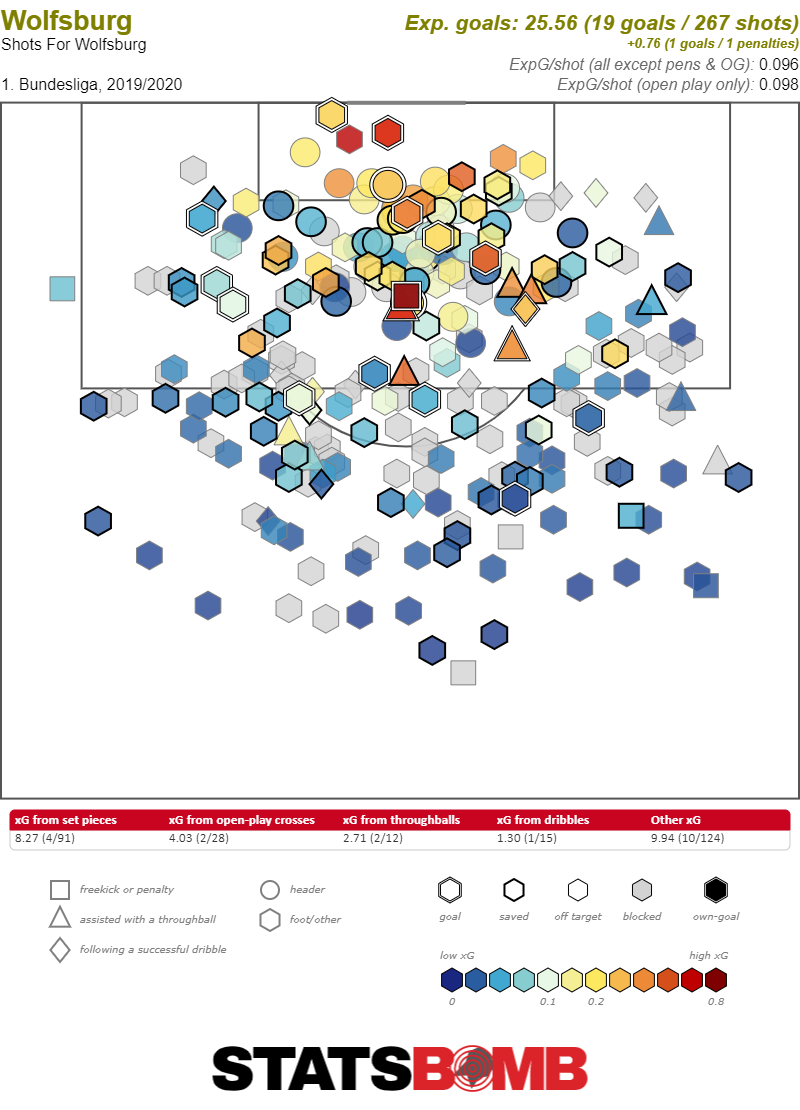 Since former LASK Linz manager Oliver Glasner took over this summer, Die Wölfe boast one of the league’s best defences.
Since former LASK Linz manager Oliver Glasner took over this summer, Die Wölfe boast one of the league’s best defences. 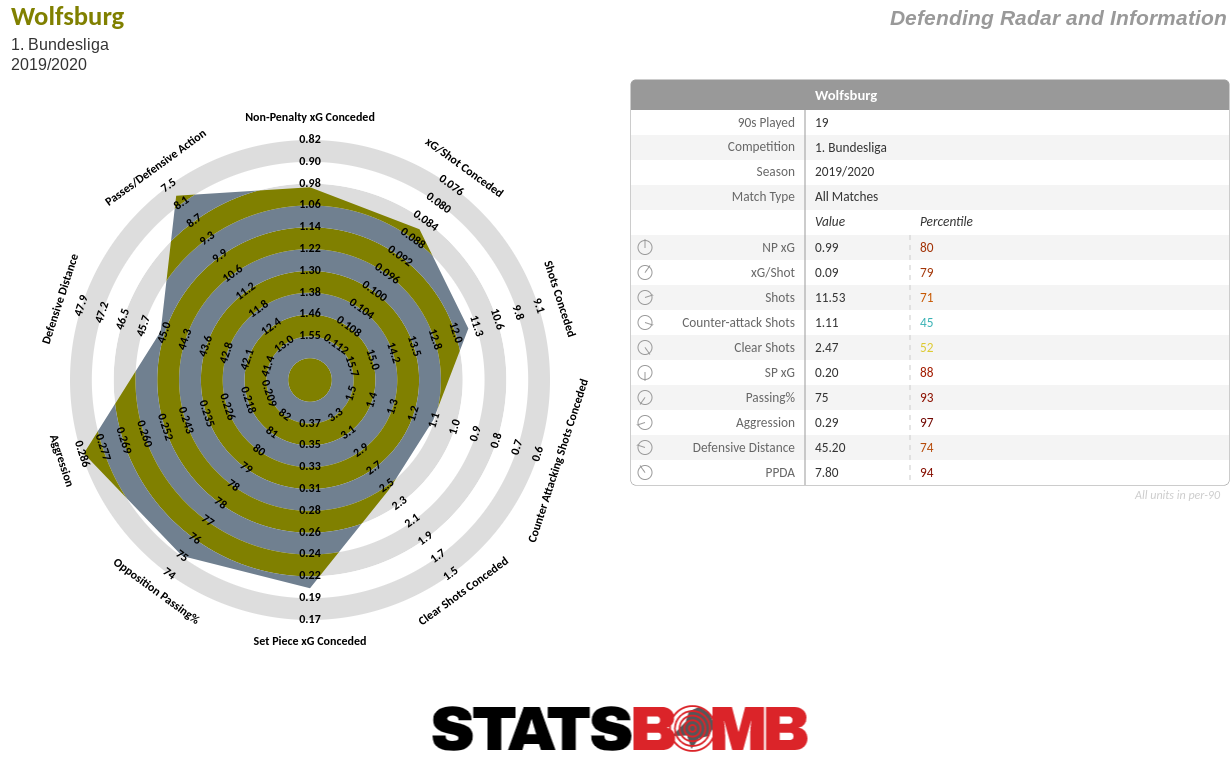 Glasner built a sturdy defensive side by implementing a rigid but beautiful pressing style, the same style that allowed his lowly LASK side to put up really impressive performances in the Austrian Bundesliga in recent seasons. But Glasner’s squad also has the personnel to drop back deeper at times, with physically strong, tall players like John-Anthony Brooks (6'4"), Josuha Guillavogui (6'3") and Marcel Tisserand (6'3") playing in the axis. Glasner has three decent wing-backs at his disposal on the flanks: summer-signee Kevin Mbabu, anonymous-but-good Brazilian William and, most importantly, French leftie Jérôme Roussilon, who, given his extremely specific dribbling skillset. seems set for a big club move next summer.
Glasner built a sturdy defensive side by implementing a rigid but beautiful pressing style, the same style that allowed his lowly LASK side to put up really impressive performances in the Austrian Bundesliga in recent seasons. But Glasner’s squad also has the personnel to drop back deeper at times, with physically strong, tall players like John-Anthony Brooks (6'4"), Josuha Guillavogui (6'3") and Marcel Tisserand (6'3") playing in the axis. Glasner has three decent wing-backs at his disposal on the flanks: summer-signee Kevin Mbabu, anonymous-but-good Brazilian William and, most importantly, French leftie Jérôme Roussilon, who, given his extremely specific dribbling skillset. seems set for a big club move next summer. 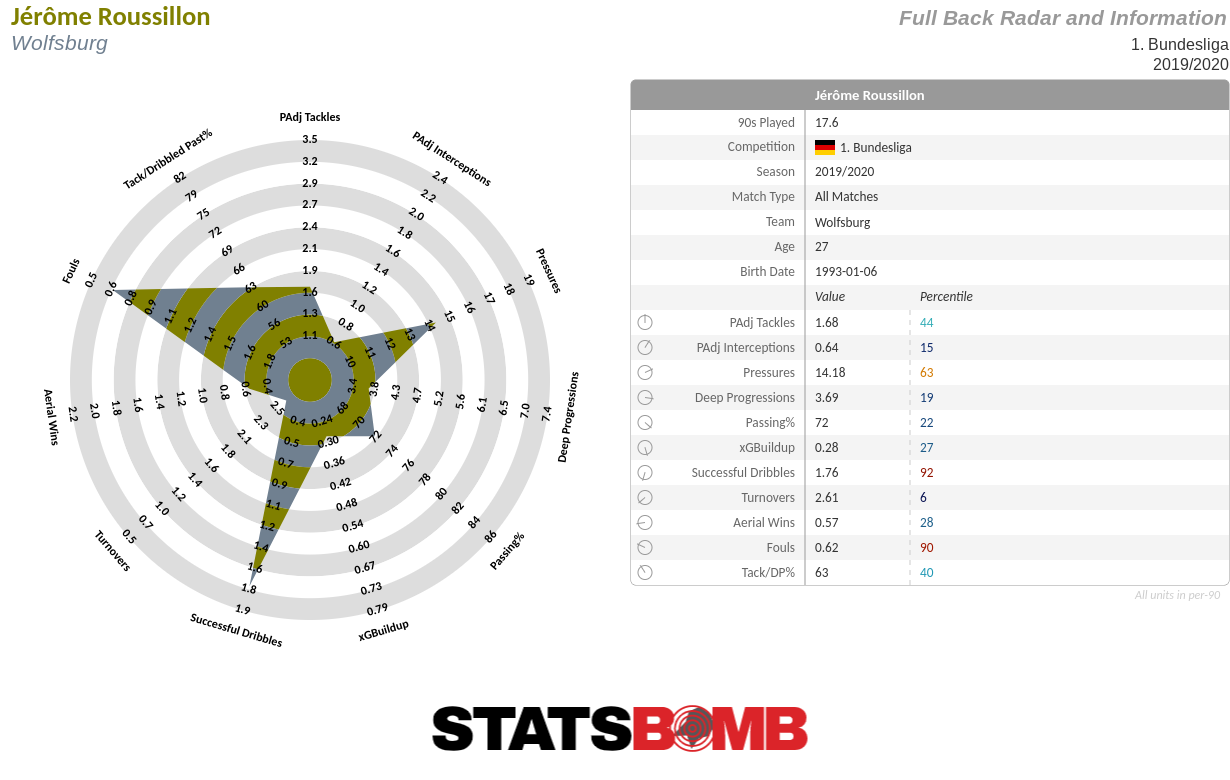 Judging by their January transfers — they replaced a mediocre centre back (Jeffrey Bruma, loaned to Mainz) with a much more promising one (Salzburg’s Marin Pongracic) — Wolfsburg won’t crash on defensively in the second half of the season. The question is whether their attacking numbers will turn around. Certain offensive woes are down to squad management, but Wout Weghorst is a truly excellent target man, whose intense running suits Glasner’s pressing style perfectly.
Judging by their January transfers — they replaced a mediocre centre back (Jeffrey Bruma, loaned to Mainz) with a much more promising one (Salzburg’s Marin Pongracic) — Wolfsburg won’t crash on defensively in the second half of the season. The question is whether their attacking numbers will turn around. Certain offensive woes are down to squad management, but Wout Weghorst is a truly excellent target man, whose intense running suits Glasner’s pressing style perfectly. 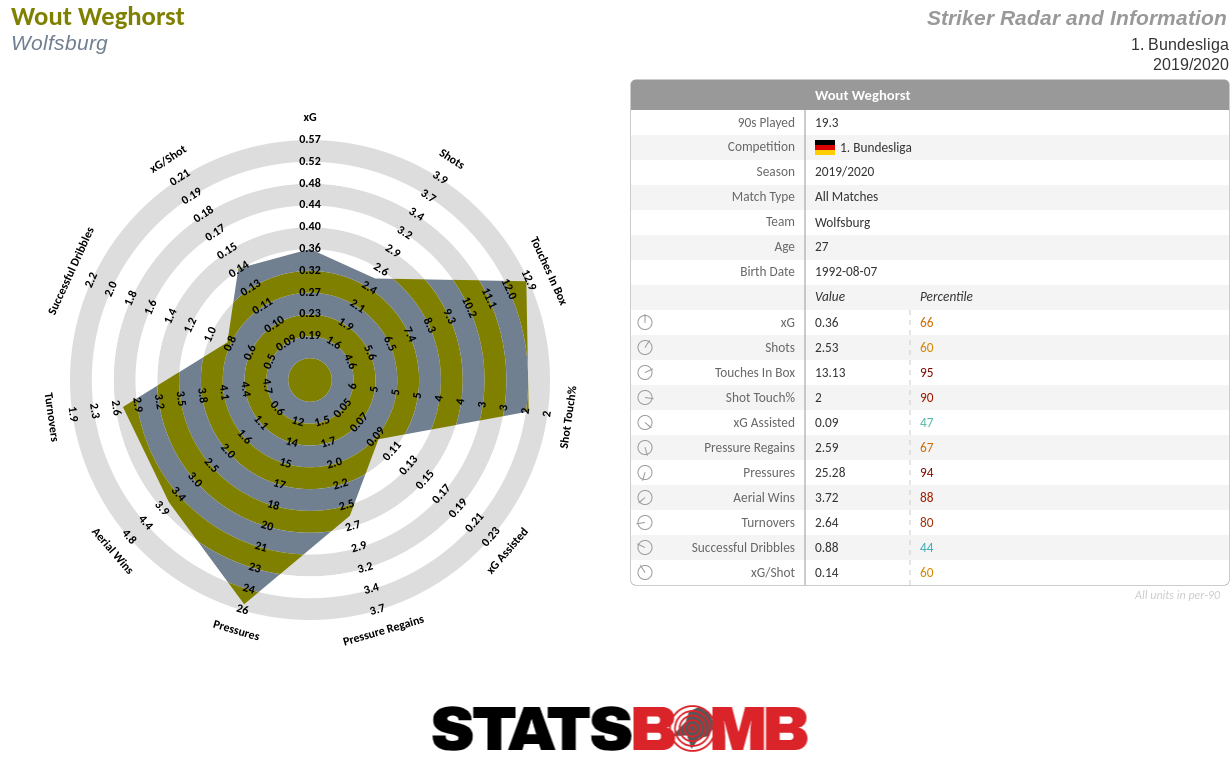 But Wolfsburg has had real trouble providing Weghorst with much-needed creative talent. Glasner rotates five players through the two positions supporting the Dutch forward: João Victor (ex-LASK), the talented but inconsistent Josip Brekalo, Swiss players Admir Mehmedi and Renato Steffen, and utility man Felix Klaus, This fivesome currently boast a disappointing cumulative goal total of six strikes in nineteen Bundesliga matches played. Not good. Finding non-Weghorst goals will be key for a successful second half of the season for Wolfsburg. Hopefully Victor in particular, who is playing well behind his xG numbers, can come good
But Wolfsburg has had real trouble providing Weghorst with much-needed creative talent. Glasner rotates five players through the two positions supporting the Dutch forward: João Victor (ex-LASK), the talented but inconsistent Josip Brekalo, Swiss players Admir Mehmedi and Renato Steffen, and utility man Felix Klaus, This fivesome currently boast a disappointing cumulative goal total of six strikes in nineteen Bundesliga matches played. Not good. Finding non-Weghorst goals will be key for a successful second half of the season for Wolfsburg. Hopefully Victor in particular, who is playing well behind his xG numbers, can come good 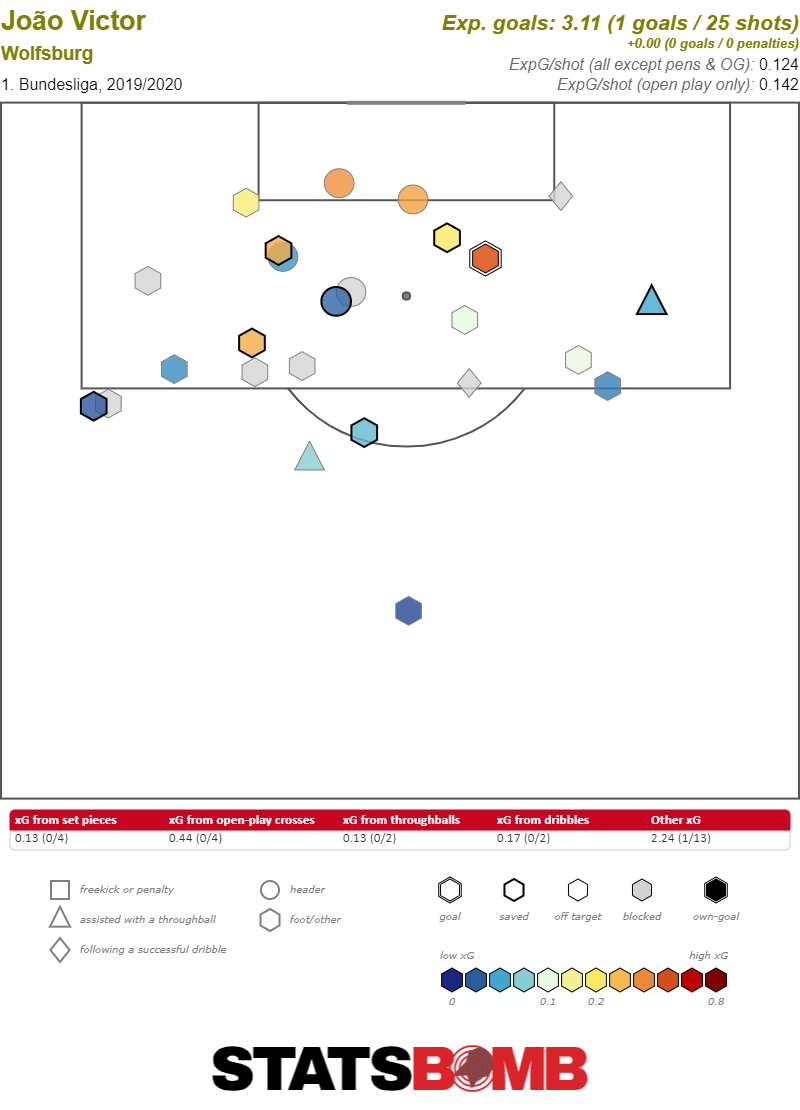
Football can be so weird, y’all. Remember the 5–1 shellacking Eintracht Frankfurt dealt to Bayern München? Well, that happened on November 2nd. 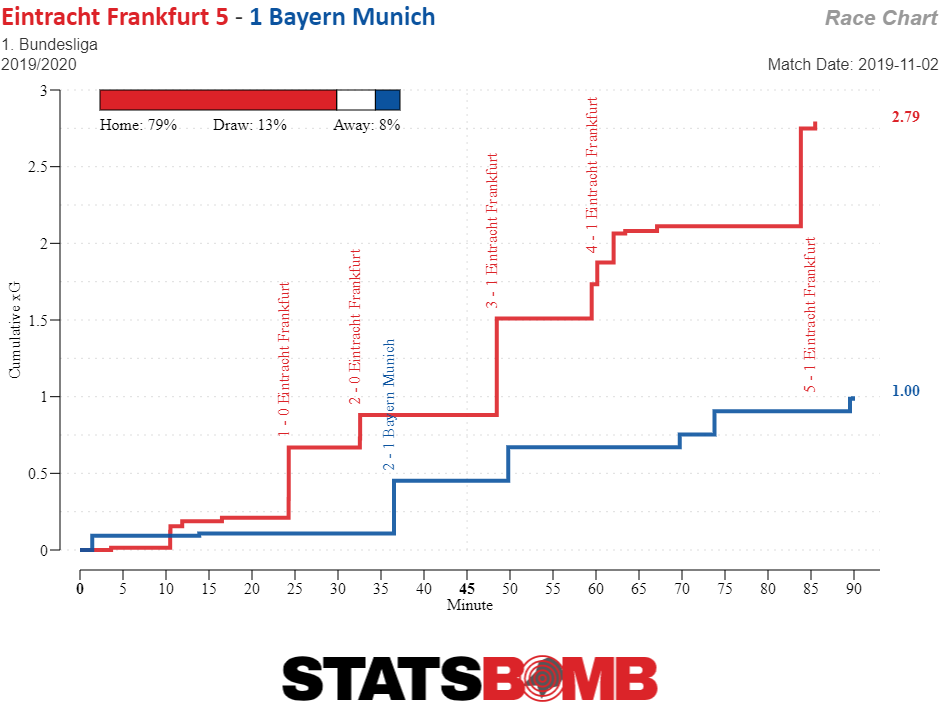 Frankfurt grabbed only one point in the remaining seven league games of 2019. The side's only hope during this horrid run of games was that their level of play — although not good, of course — never dropped to super worrisome depths.
Frankfurt grabbed only one point in the remaining seven league games of 2019. The side's only hope during this horrid run of games was that their level of play — although not good, of course — never dropped to super worrisome depths. 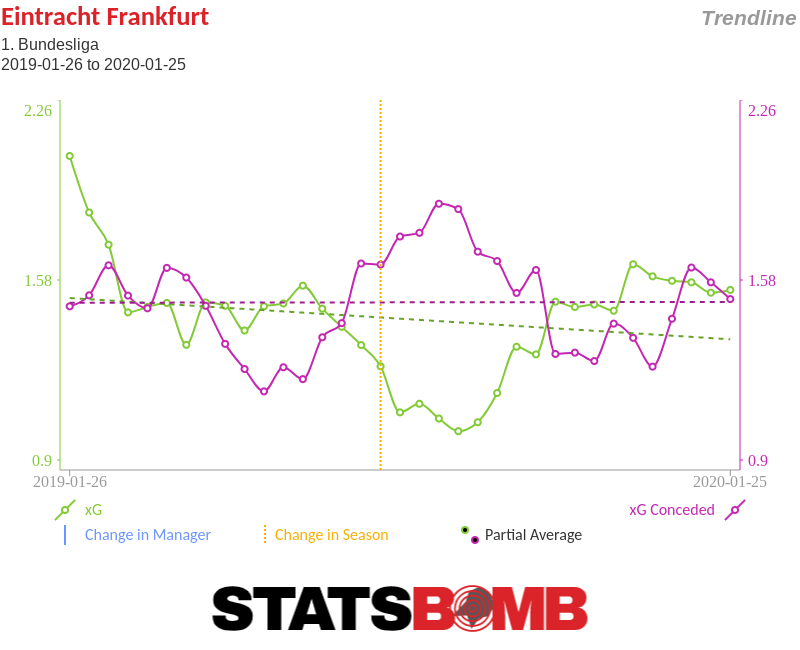 And lo and behold! Frankfurt have stormed out of the gate in 2020. They re-opened their league campaign by beating Hoffenheim 2–1 on their turf, and followed that up with a 2–0 victory against league leaders RB Leipzig. On paper, Eintracht manager Adi Hütter has opted for a much more defensive style than the one at which his team excelled last season. Since the winter break, Hütter has traded in the 3-4-1-2 system for a 4-4-1-1 setup, with Timothy Chandler and Filip Kostić — both wing-backs in the old system — as wingers, and the intense running of Mijat Gaćinović as the only support of central striker Bas Dost.
And lo and behold! Frankfurt have stormed out of the gate in 2020. They re-opened their league campaign by beating Hoffenheim 2–1 on their turf, and followed that up with a 2–0 victory against league leaders RB Leipzig. On paper, Eintracht manager Adi Hütter has opted for a much more defensive style than the one at which his team excelled last season. Since the winter break, Hütter has traded in the 3-4-1-2 system for a 4-4-1-1 setup, with Timothy Chandler and Filip Kostić — both wing-backs in the old system — as wingers, and the intense running of Mijat Gaćinović as the only support of central striker Bas Dost. 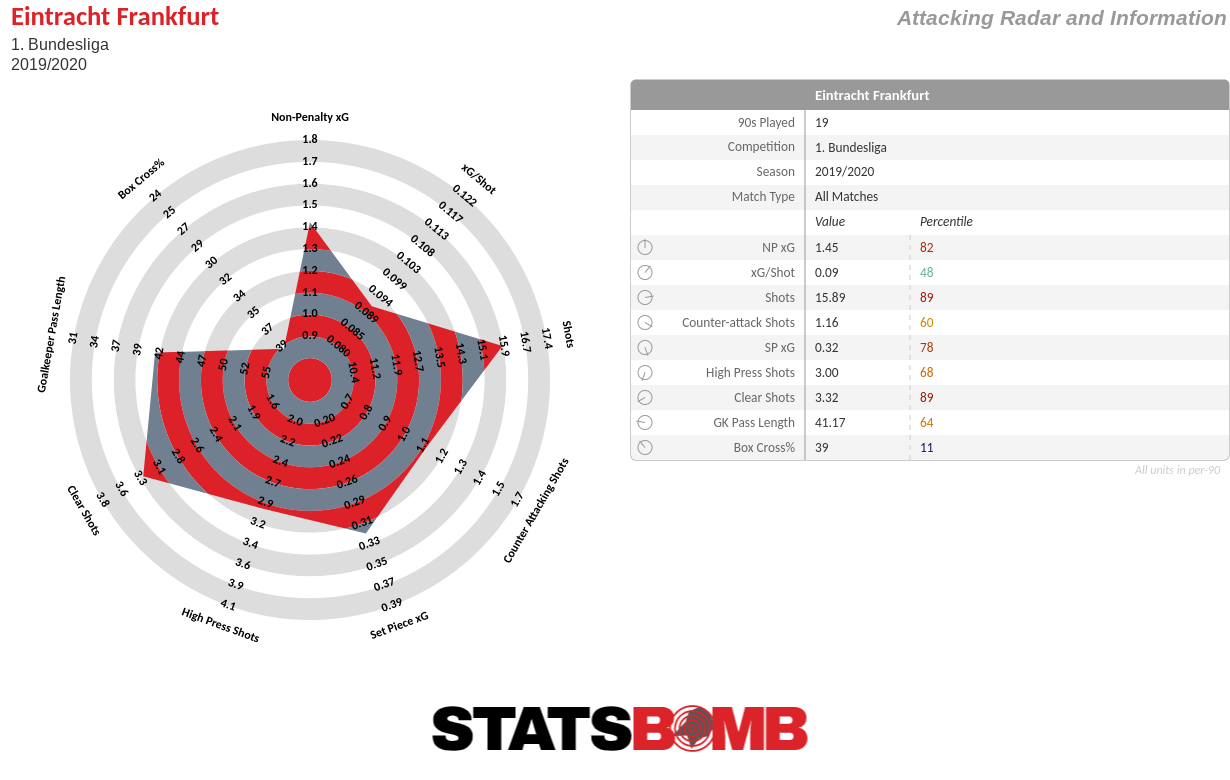 As is often the case, a team’s reality can differ wildly than what's on paper. Powerhouses Bayern and Leipzig, alongside fifth-placed Leverkusen, are the only teams to put up more shots on a per-game basis than Hütter’s heavy-pressing squad (a solid 15.89 per game average). Super impressive, if you take into account that Frankfurt sold their shiniest players — Sébastien Haller (West Ham), Luka Jović (Real Madrid) and Ante Rebić (AC Milan) — this summer, a three-headed offensive monster who accounted for a whopping 41 league goals in 2018–19. The only star player on offense who stayed with Die Adler last summer, Serbian winger Kostić, has been sensational this season. After 19 match weeks, Frankfurt’s leftie is second in the league in key passes (46) and in successful dribbles (53), whilst only Robert Lewandowski and Timo Werner have put up more shots than Kostić (55) so far.
As is often the case, a team’s reality can differ wildly than what's on paper. Powerhouses Bayern and Leipzig, alongside fifth-placed Leverkusen, are the only teams to put up more shots on a per-game basis than Hütter’s heavy-pressing squad (a solid 15.89 per game average). Super impressive, if you take into account that Frankfurt sold their shiniest players — Sébastien Haller (West Ham), Luka Jović (Real Madrid) and Ante Rebić (AC Milan) — this summer, a three-headed offensive monster who accounted for a whopping 41 league goals in 2018–19. The only star player on offense who stayed with Die Adler last summer, Serbian winger Kostić, has been sensational this season. After 19 match weeks, Frankfurt’s leftie is second in the league in key passes (46) and in successful dribbles (53), whilst only Robert Lewandowski and Timo Werner have put up more shots than Kostić (55) so far.  With Hütter seemingly settled on his favourite starting eleven for the coming months, Eintracht’s main concern is improving their set-piece defence. Before the winter break, only Mainz conceded more goals than Frankfurt from corners and free-kicks (8 in 17 games). With Frankfurt playing a free-roving style in open play, a somewhat acceptable goal balance from dead-ball moments is pretty crucial to avoid arcade-like scoring lines. However, much more quietly than last season, Hütter has done well with Frankfurt this year, and their nine-point gap behind sixth-placed Schalke does not seem impossible to close in the remaining fifteen weeks.
With Hütter seemingly settled on his favourite starting eleven for the coming months, Eintracht’s main concern is improving their set-piece defence. Before the winter break, only Mainz conceded more goals than Frankfurt from corners and free-kicks (8 in 17 games). With Frankfurt playing a free-roving style in open play, a somewhat acceptable goal balance from dead-ball moments is pretty crucial to avoid arcade-like scoring lines. However, much more quietly than last season, Hütter has done well with Frankfurt this year, and their nine-point gap behind sixth-placed Schalke does not seem impossible to close in the remaining fifteen weeks.
From a set of poor performances from Atlético Madrid while Valencia move up the table, from Chimy Ávila's injury to Getafe's press, take a moment to make sure you didn't miss anything from this week in Spain.
It was a bad week for Atlético Madrid. Defeat away at Eibar on matchday 20 was followed by elimination from the Copa del Rey at the hands of Cultural Leonesa of Segunda B and then an insipid 0–0 draw at home to Leganés that saw them slip out of the top four. If that weren't enough, Real Madrid await this weekend. The narrative seems to be that Diego Simeone’s methods are wearing thin. But here’s the thing: Atlético’s underlying numbers look pretty damn good. They combine La Liga’s best defensive numbers with its fourth-best attack for the third-best expected goal difference in the division.  Their underlying numbers have not only improved as the campaign has gone on, but are actually stronger than those that led them to second place last season.
Their underlying numbers have not only improved as the campaign has gone on, but are actually stronger than those that led them to second place last season.  The problem is their significant underperformance in attack. Atlético generate an above-average number of good quality shots, but for one reason or another fail to finish at an acceptable rate. They are over seven goals worse off than their xG and have converted just one of their three penalties.
The problem is their significant underperformance in attack. Atlético generate an above-average number of good quality shots, but for one reason or another fail to finish at an acceptable rate. They are over seven goals worse off than their xG and have converted just one of their three penalties.  Ángel Correa, Álvaro Morata, Diego Costa, João Félix: all have underperformed their xG this season. It’s as if some malign force has swept in and made off with all their shooting boots. It would be reasonable to assume this kind of finishing run won’t hold through the remainder of the campaign. Even just matching their underlying numbers would help Atlético turn some of their draws into victories and in turn gain them the points they need to secure their eighth consecutive season of Champions League football. If it does hold, they’ll be reliant on the failure of others around them to take advantage.
Ángel Correa, Álvaro Morata, Diego Costa, João Félix: all have underperformed their xG this season. It’s as if some malign force has swept in and made off with all their shooting boots. It would be reasonable to assume this kind of finishing run won’t hold through the remainder of the campaign. Even just matching their underlying numbers would help Atlético turn some of their draws into victories and in turn gain them the points they need to secure their eighth consecutive season of Champions League football. If it does hold, they’ll be reliant on the failure of others around them to take advantage.
In short: probably not. At least that’s what the underlying numbers suggest. Valencia moved to within two points of the top four with a 2-0 win over an uninspired Barcelona side at the Mestalla on Saturday, raising hopes of a push for a European finish. But here is that xG difference graphic again. Scan for Valencia. You won’t find them amongst the top six. Nor the top 10. Not even the top 15. Nope, Valencia currently have the fifth-worst xG difference in La Liga.  Their numbers stabilised a bit after their initial drop off following the sacking of Marcelino and appointment of Albert Celades, but are still not those of a side that can be expected to maintain a top-four challenge. Over the last 10 matches, they’ve still only posted the 13th best xG difference in La Liga.
Their numbers stabilised a bit after their initial drop off following the sacking of Marcelino and appointment of Albert Celades, but are still not those of a side that can be expected to maintain a top-four challenge. Over the last 10 matches, they’ve still only posted the 13th best xG difference in La Liga. 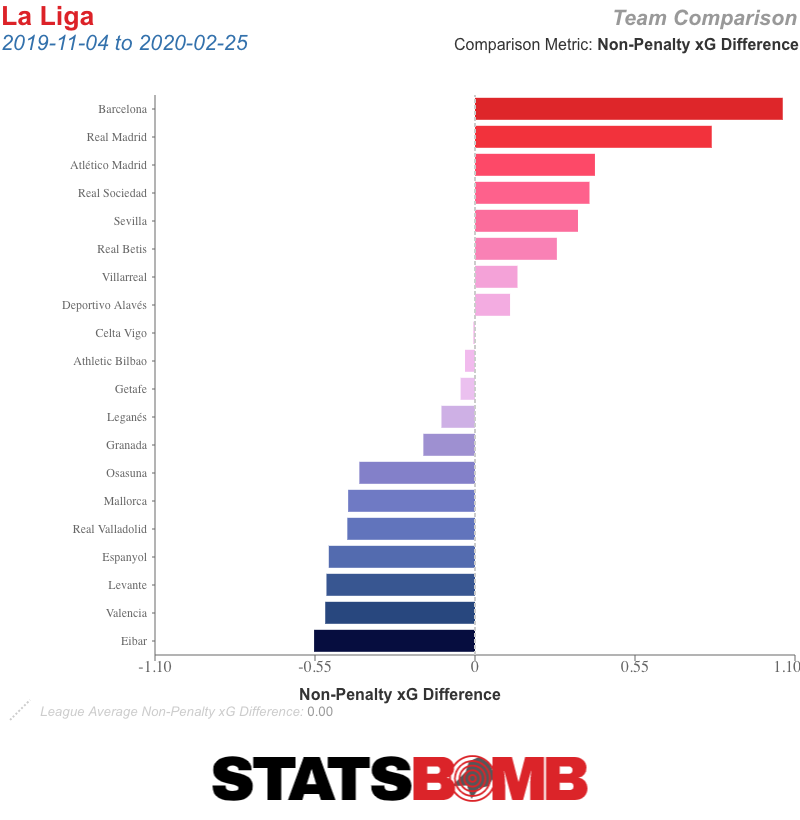 With Getafe, Atlético Madrid and Real Sociedad to come in three of their next four matches, their position is unlikely to look quite so healthy in a month’s time.
With Getafe, Atlético Madrid and Real Sociedad to come in three of their next four matches, their position is unlikely to look quite so healthy in a month’s time.
He couldn’t have got injured any other way. Early into the second half of Osasuna’s home win over Levante, scurrying after a defender, Chimy Ávila hopped up to block a clearance. As he landed, his left knee rotated inwards, leaving him writhing on the turf. Tests later revealed he had torn his anterior cruciate ligament — a season-ending injury. Osasuna will now have to do without one of the league’s hardest-working forwards and the player around whom much of their shot production is built. When coach Jagoba Arrasate described Ávila as a franchise player in his post-match press conference, he wasn’t lying. The 25-year-old comfortably leads his team in goals, xG and shots. Add good creative numbers and defensive graft to his impressive shooting output and you have a forward who had rightfully been attracting interest from bigger clubs.  How will Osasuna replace him? At least they have a very solid combined shot volume from their two wide players, Roberto Torres and Rubén García.
How will Osasuna replace him? At least they have a very solid combined shot volume from their two wide players, Roberto Torres and Rubén García. 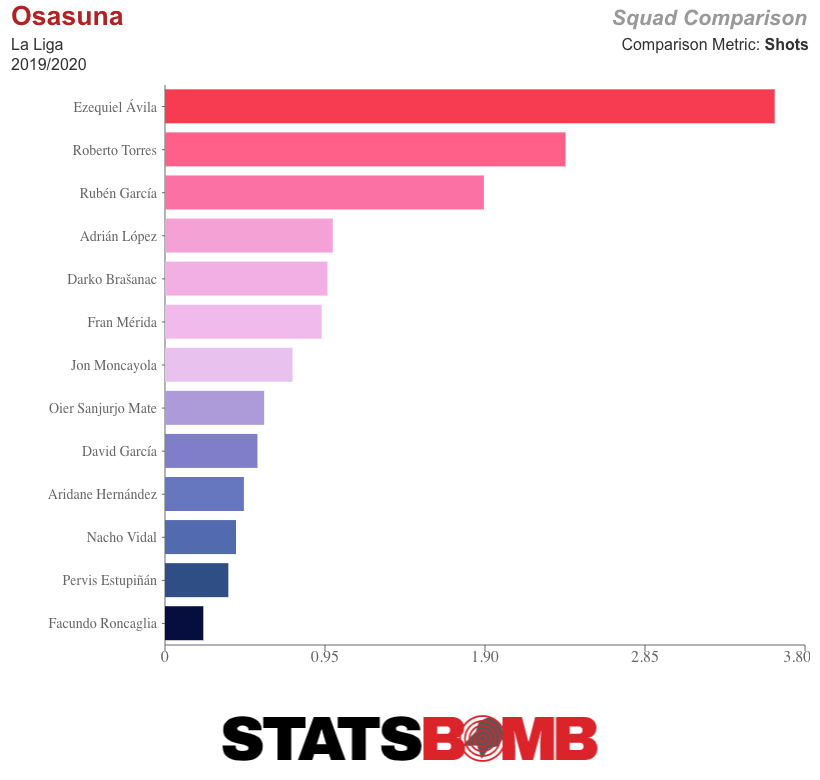 But they don’t have another forward with the bullish determination to create shots that makes Ávila such an asset. That certainly isn’t the natural game of Adrián López or Brandon. Marc Cardona has posted solid volume here and there but nothing concrete. On Tuesday, Osasuna announced the initial loan signing (and, in great detail, the subsequent purchase clauses) of Enric Gallego. He’s barely had a look in at Getafe this season, but his output at Huesca last season, where he shared a dressing room with Ávila, doesn't really suggest he's an ideal replacement.
But they don’t have another forward with the bullish determination to create shots that makes Ávila such an asset. That certainly isn’t the natural game of Adrián López or Brandon. Marc Cardona has posted solid volume here and there but nothing concrete. On Tuesday, Osasuna announced the initial loan signing (and, in great detail, the subsequent purchase clauses) of Enric Gallego. He’s barely had a look in at Getafe this season, but his output at Huesca last season, where he shared a dressing room with Ávila, doesn't really suggest he's an ideal replacement.  Thankfully for Osasuna their good first half of the season has given them plenty of margin for error.
Thankfully for Osasuna their good first half of the season has given them plenty of margin for error.
Getafe made a slow start to the season, but they are now in the centre of the battle for European places. Their 1–0 win over Real Betis on Sunday owed much to the vagaries of what is and isn’t reviewed by VAR, but it was nevertheless their seventh victory in their last eleven, and a result that saw them leapfrog Atlético Madrid into fourth. Pepe Bordalás’ team have a functional attack capable of efficiently creating sufficient chances to win them matches and points. They are, though, significantly overperforming their xG. What is truly remarkable about Getafe is the manner in which they defend. The side were already one of La Liga’s most aggressive high-pressing teams last season. The graphic shows how each team’s proportion of defensive actions (including our pressure data) to completed opposition passes compares with the league average in each of six vertical zones. The red tones indicate that the team in question completed an above-average proportion of defensive actions in that zone. 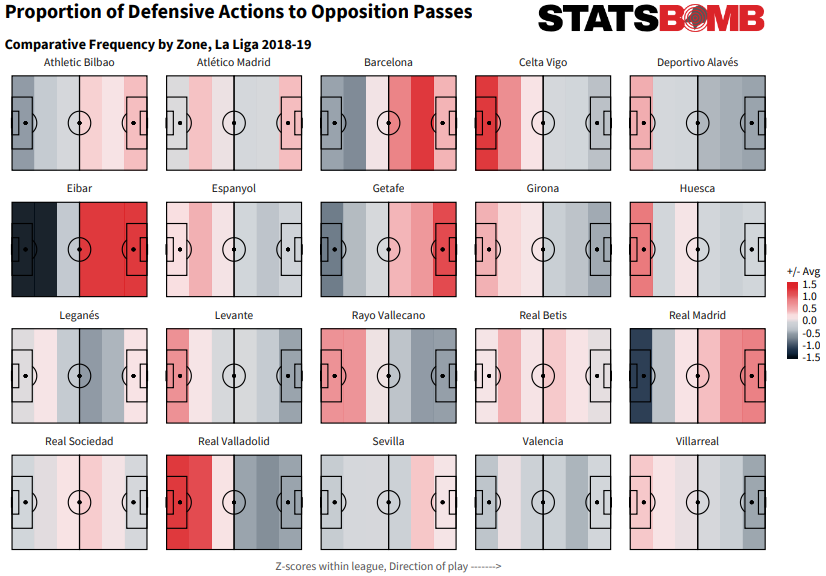 Getafe have ramped that up even further. The opposition half is an alizarin ocean.
Getafe have ramped that up even further. The opposition half is an alizarin ocean. 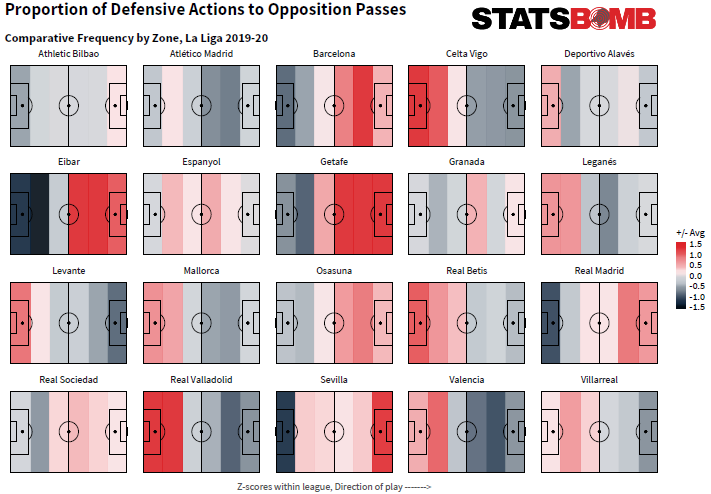 Getafe defend higher and more aggressively than any other side in La Liga, and concede over two shots less per match than they did last season. Bordalás has crafted a supreme shot-suppression machine.
Getafe defend higher and more aggressively than any other side in La Liga, and concede over two shots less per match than they did last season. Bordalás has crafted a supreme shot-suppression machine. 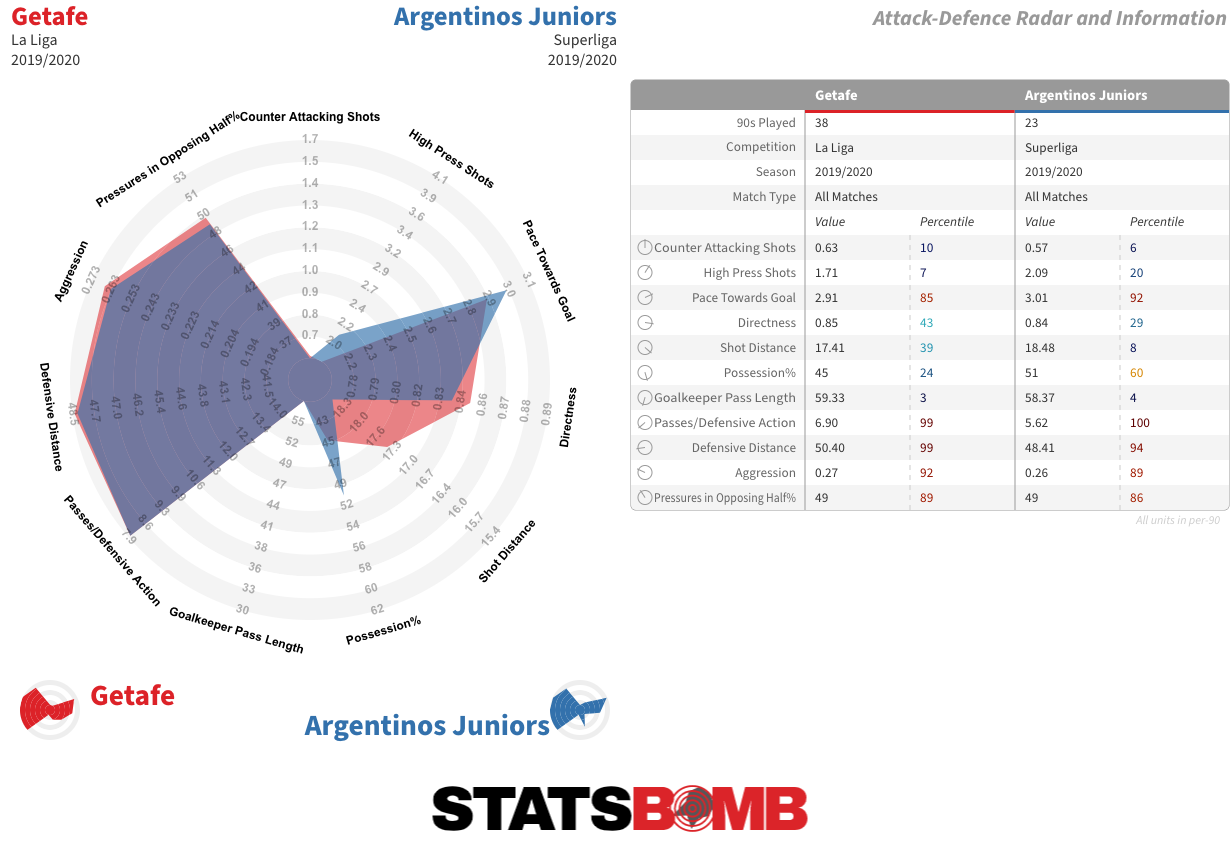 Our new distribution graphics make it clear just how extreme their approach is. Across the big-five European leagues over the last few seasons, they are in the 99th percentile for Defensive Distance, PPDA and Shots Conceded. And that isn’t overly conditioned by just how shot-shy La Liga has been this season (around 1.5 less shots per match than last season). Getafe have given up even fewer shots in European action.
Our new distribution graphics make it clear just how extreme their approach is. Across the big-five European leagues over the last few seasons, they are in the 99th percentile for Defensive Distance, PPDA and Shots Conceded. And that isn’t overly conditioned by just how shot-shy La Liga has been this season (around 1.5 less shots per match than last season). Getafe have given up even fewer shots in European action. 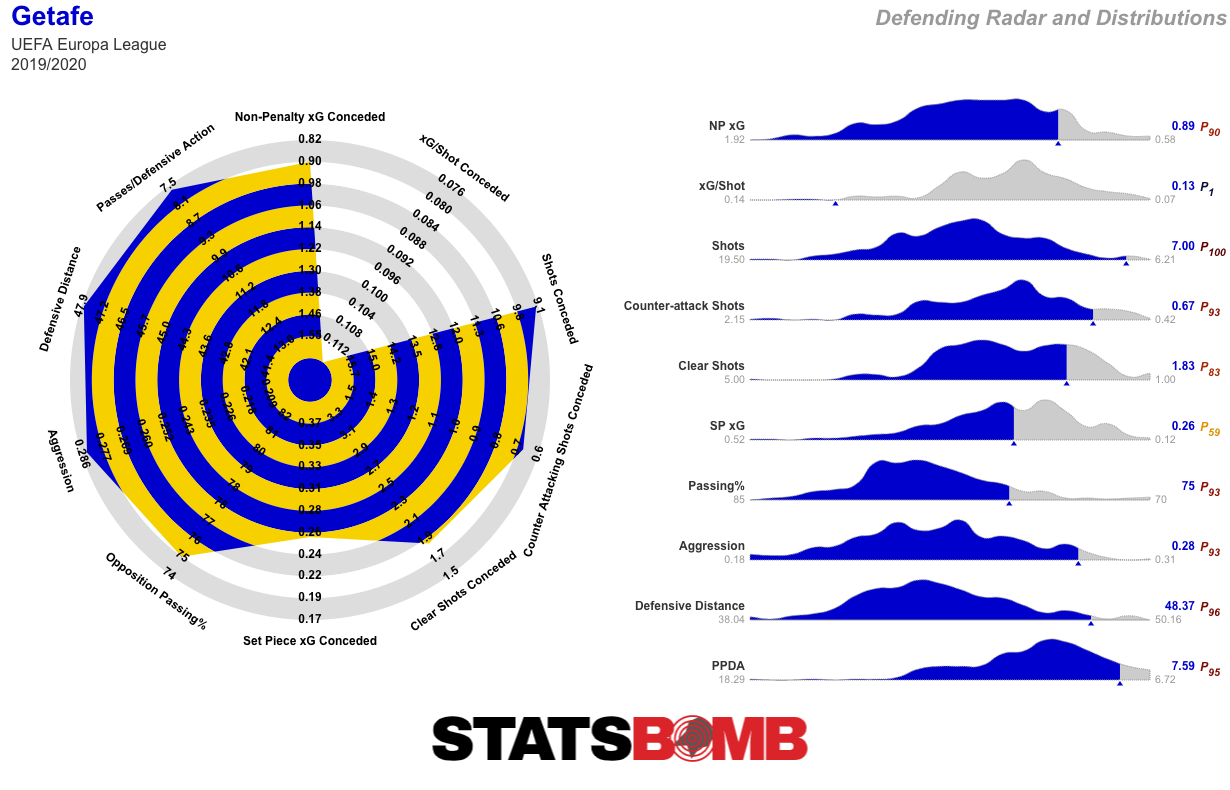 Header image courtesy of the press association
Header image courtesy of the press association
It started so well. All signs pointed to Frank Lampard’s Chelsea reboot being a big success. It wasn’t perfect, but Chelsea won eight of their first twelve Premier League games in a manner that suggested they were the real deal. Beyond the results, the metrics looked even better. Lampard’s side had a better than expected goal difference than Liverpool after twelve matches. 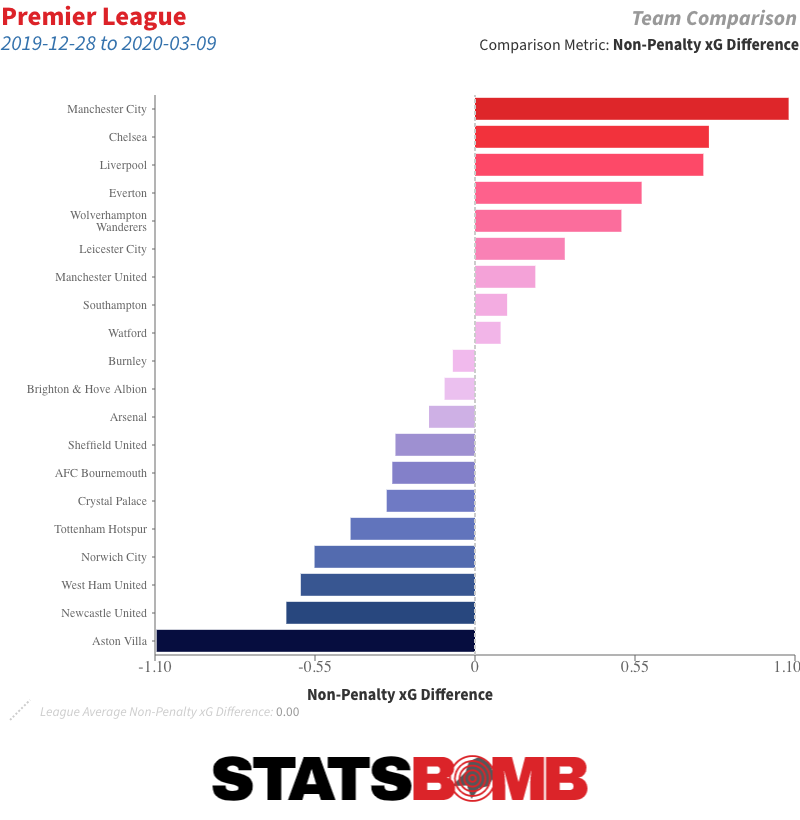 After selling the club’s signature player in Eden Hazard, buying no one due to a transfer ban, and putting an inexperienced beloved former player in charge, this was quite the surprise. The core of it seemed to stem from the excellent form of academy graduates, most prominently Tammy Abraham and Mason Mount, who were finally given opportunities in the first team. Lampard’s football is far less restrictive than Maurizio Sarri’s very precise possession-based system, thus allowing a player like Mateo Kovačić to perform in a manner closer to his natural game than be stuck in the uncomfortable role he occupied previously. Even Jorginho, the avatar of Sarriball, looked like he enjoyed the greater freedom afforded under the new man in charge. And then the results just stopped coming. Four wins versus six losses in the last twelve games. The fact that Manchester United and Tottenham have been underperforming is all that’s keeping Chelsea in a good position to finish in the top four. But how did this happen? Why did it suddenly go wrong? Purely in terms of expected goals, not much has changed. Chelsea had an xG difference per game of +0.83 in the first twelve fixtures and +0.72 in the second 12. On the defensive end, things look absolutely fine. Chelsea conceded 0.92 xG per game and now they concede 0.86. As seen on the radar below, they’re bringing their defensive work higher up the pitch than before, allowing the opposition fewer passes before attempting to win the ball, and further restricting opponents’ ability to keep possession. Chelsea look like they’re becoming a more complete pressing unit.
After selling the club’s signature player in Eden Hazard, buying no one due to a transfer ban, and putting an inexperienced beloved former player in charge, this was quite the surprise. The core of it seemed to stem from the excellent form of academy graduates, most prominently Tammy Abraham and Mason Mount, who were finally given opportunities in the first team. Lampard’s football is far less restrictive than Maurizio Sarri’s very precise possession-based system, thus allowing a player like Mateo Kovačić to perform in a manner closer to his natural game than be stuck in the uncomfortable role he occupied previously. Even Jorginho, the avatar of Sarriball, looked like he enjoyed the greater freedom afforded under the new man in charge. And then the results just stopped coming. Four wins versus six losses in the last twelve games. The fact that Manchester United and Tottenham have been underperforming is all that’s keeping Chelsea in a good position to finish in the top four. But how did this happen? Why did it suddenly go wrong? Purely in terms of expected goals, not much has changed. Chelsea had an xG difference per game of +0.83 in the first twelve fixtures and +0.72 in the second 12. On the defensive end, things look absolutely fine. Chelsea conceded 0.92 xG per game and now they concede 0.86. As seen on the radar below, they’re bringing their defensive work higher up the pitch than before, allowing the opposition fewer passes before attempting to win the ball, and further restricting opponents’ ability to keep possession. Chelsea look like they’re becoming a more complete pressing unit.  The Blues have been consistent in conceding moderately more goals than expected this season. It’s possible that much of this is the fault of Kepa Arrizabalaga, who has never looked impressive in the shot-stopping numbers. But even so, he doesn't account for the entire problem. Chelsea have conceded 21.54 xG on the conventional model, 24.17 xG on the post-shot model, and 28 non-penalty goals in reality. If Kepa is at fault, he cannot solely be to blame for opposing attackers hitting their shots particularly well; at least, according to the data.. Another possibility, albeit difficult to find evidence for in the data, is that Chelsea’s particularly open style leads to conceding shots that are better than the model thinks. But these are fairly out-there hypotheticals. The most likely scenario is that this is just a case of shit happens, and we shouldn’t expect the side to continue to let in goals like this if nothing else changes. It’s the attacking side, though, where the data looks a little more tangible. Eleven non-penalty goals from the last twelve games against twenty-six from the first twelve massively exaggerates the issue, but there has been a real decline.
The Blues have been consistent in conceding moderately more goals than expected this season. It’s possible that much of this is the fault of Kepa Arrizabalaga, who has never looked impressive in the shot-stopping numbers. But even so, he doesn't account for the entire problem. Chelsea have conceded 21.54 xG on the conventional model, 24.17 xG on the post-shot model, and 28 non-penalty goals in reality. If Kepa is at fault, he cannot solely be to blame for opposing attackers hitting their shots particularly well; at least, according to the data.. Another possibility, albeit difficult to find evidence for in the data, is that Chelsea’s particularly open style leads to conceding shots that are better than the model thinks. But these are fairly out-there hypotheticals. The most likely scenario is that this is just a case of shit happens, and we shouldn’t expect the side to continue to let in goals like this if nothing else changes. It’s the attacking side, though, where the data looks a little more tangible. Eleven non-penalty goals from the last twelve games against twenty-six from the first twelve massively exaggerates the issue, but there has been a real decline. 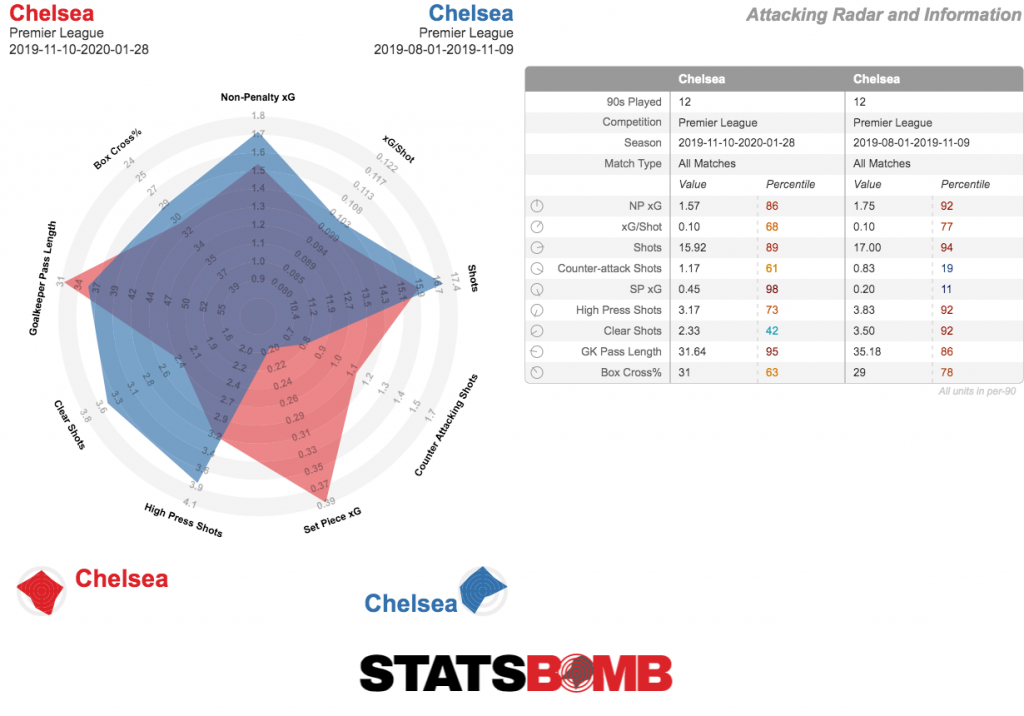 What’s obvious visually is that the one big positive recently are the set pieces. They’re running a touch cold here, scoring 4 goals from 5.57 xG, but set pieces can be utilised effectively in any club’s attack and it’s good to see Chelsea making progress . . . although, it could just be a couple of really good shots skewing the numbers in the sample. Either way, it’s covering for an even bigger problem in open play. Here, Chelsea have gone from generating 1.76 xG per game to just 1.13. Their finishing has been horrendous recently, but even so, this just isn’t what their fans want to see.
What’s obvious visually is that the one big positive recently are the set pieces. They’re running a touch cold here, scoring 4 goals from 5.57 xG, but set pieces can be utilised effectively in any club’s attack and it’s good to see Chelsea making progress . . . although, it could just be a couple of really good shots skewing the numbers in the sample. Either way, it’s covering for an even bigger problem in open play. Here, Chelsea have gone from generating 1.76 xG per game to just 1.13. Their finishing has been horrendous recently, but even so, this just isn’t what their fans want to see. 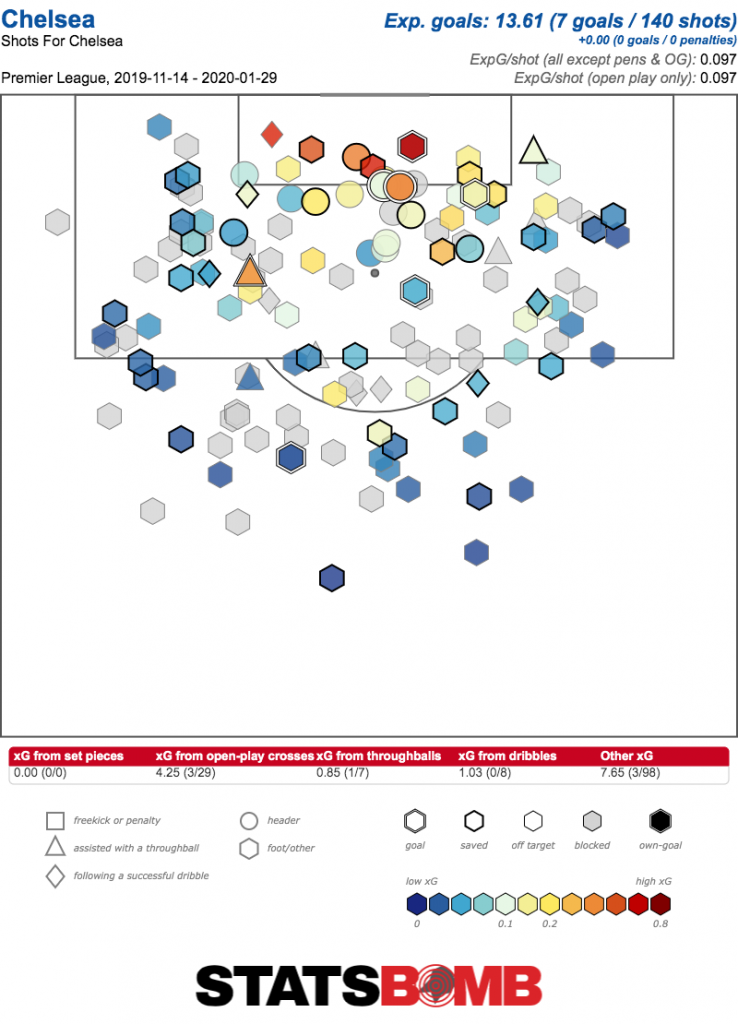 We can see this with Abraham. He hasn’t been bad, exactly, but his numbers have definitely taken a hit. He ran a little over xG in the fall and a little under it since, which once again exaggerates things, but it’s clear that he hasn’t been getting good chances quite as often.
We can see this with Abraham. He hasn’t been bad, exactly, but his numbers have definitely taken a hit. He ran a little over xG in the fall and a little under it since, which once again exaggerates things, but it’s clear that he hasn’t been getting good chances quite as often.  Overall, though, Chelsea appear the same as they were earlier in the year. The shift in results is down to chances not going in more than any other aspect of their performance. So what do we know about Chelsea overall at this stage? Well, the youth revolution has been a clear success. Fikayo Tomori has played more than half the available league minutes and looked absolutely capable as a Champions League side’s centre back at age 22. Though he was obviously bought for an obscene amount of money, Christian Pulisic should be included in this bracket, and he leads the Premier League in xG and xG assisted per 90 for players 21 or younger. It’s hard to ask a 21-year-old arriving in a new country to do much more than he has so far.
Overall, though, Chelsea appear the same as they were earlier in the year. The shift in results is down to chances not going in more than any other aspect of their performance. So what do we know about Chelsea overall at this stage? Well, the youth revolution has been a clear success. Fikayo Tomori has played more than half the available league minutes and looked absolutely capable as a Champions League side’s centre back at age 22. Though he was obviously bought for an obscene amount of money, Christian Pulisic should be included in this bracket, and he leads the Premier League in xG and xG assisted per 90 for players 21 or younger. It’s hard to ask a 21-year-old arriving in a new country to do much more than he has so far.  But what if I told you the second-best young player in this metric is also at Chelsea? And what if I told you he’s more than two years younger than Pulisic? You’d be pretty interested in that player, right?
But what if I told you the second-best young player in this metric is also at Chelsea? And what if I told you he’s more than two years younger than Pulisic? You’d be pretty interested in that player, right?  Seeing as Chelsea are supposedly interested in spending a lot of money on Jadon Sancho, and given the Borussia Dortmund man is a terrific talent who could bring a lot to any side, they already have an exciting long-term front three with Pulisic and Callum Hudson-Odoi either side of Abraham. Mason Mount, another attacking player, has received a lot of hype this season, and it’s not unwarranted. English football is good at producing young players who press well and get shots, which is a mould Mount fits right into. But he does need to develop his game beyond that. All Chelsea outfield players to have featured for at least 600 minutes (bar Abraham) average more passes per 90, and even players like César Azpilicueta and N'Golo Kanté complete more passes in the final third than Mount. The comparisons to his manager are clear and not unfair, but while he’s got the basics down, he should remember that Lampard also developed an excellent passing game over time.
Seeing as Chelsea are supposedly interested in spending a lot of money on Jadon Sancho, and given the Borussia Dortmund man is a terrific talent who could bring a lot to any side, they already have an exciting long-term front three with Pulisic and Callum Hudson-Odoi either side of Abraham. Mason Mount, another attacking player, has received a lot of hype this season, and it’s not unwarranted. English football is good at producing young players who press well and get shots, which is a mould Mount fits right into. But he does need to develop his game beyond that. All Chelsea outfield players to have featured for at least 600 minutes (bar Abraham) average more passes per 90, and even players like César Azpilicueta and N'Golo Kanté complete more passes in the final third than Mount. The comparisons to his manager are clear and not unfair, but while he’s got the basics down, he should remember that Lampard also developed an excellent passing game over time.  What Chelsea have is a somewhat messy, swashbuckling style of football played by a young group of players direced by a young manager. There's no doubt that this group of players will continue to mature, and with the set of individuals around there’s a very good chance of at least one going supernova. And the talent from the academy doesn’t seem to be drying up any time soon. Figuring out a pathway for these players to the senior side was crucial, and Chelsea should reap the rewards for many years to come. Lampard’s ability as a manager does remain something of an open question, though. What he’s done right at Chelsea so far is to listen to the players' thoughts on their own strengths and give them enough slack to do what they’re comfortable with. He’s also looked to install a high pressing game. In the long term, Chelsea will surely need to develop a clear plan in possession more structured than they have right now. There's really no way to know if Lampard is capable of doing that. But for now, the club are on the right track, and no fans should worry too much about recent results.
What Chelsea have is a somewhat messy, swashbuckling style of football played by a young group of players direced by a young manager. There's no doubt that this group of players will continue to mature, and with the set of individuals around there’s a very good chance of at least one going supernova. And the talent from the academy doesn’t seem to be drying up any time soon. Figuring out a pathway for these players to the senior side was crucial, and Chelsea should reap the rewards for many years to come. Lampard’s ability as a manager does remain something of an open question, though. What he’s done right at Chelsea so far is to listen to the players' thoughts on their own strengths and give them enough slack to do what they’re comfortable with. He’s also looked to install a high pressing game. In the long term, Chelsea will surely need to develop a clear plan in possession more structured than they have right now. There's really no way to know if Lampard is capable of doing that. But for now, the club are on the right track, and no fans should worry too much about recent results.
Ask any traditionalist what a newly promoted team needs to get right in order to stay in the Premier League, and chances are that “defending set pieces” will be a key point. Which should be a real cause of concern for Aston Villa. The Midlands side are the worst team in the Premier League when it comes to xG conceded from set plays. Realistically Villa are currently a toss up for relegation, but things would look a lot more secure if they could fix this. 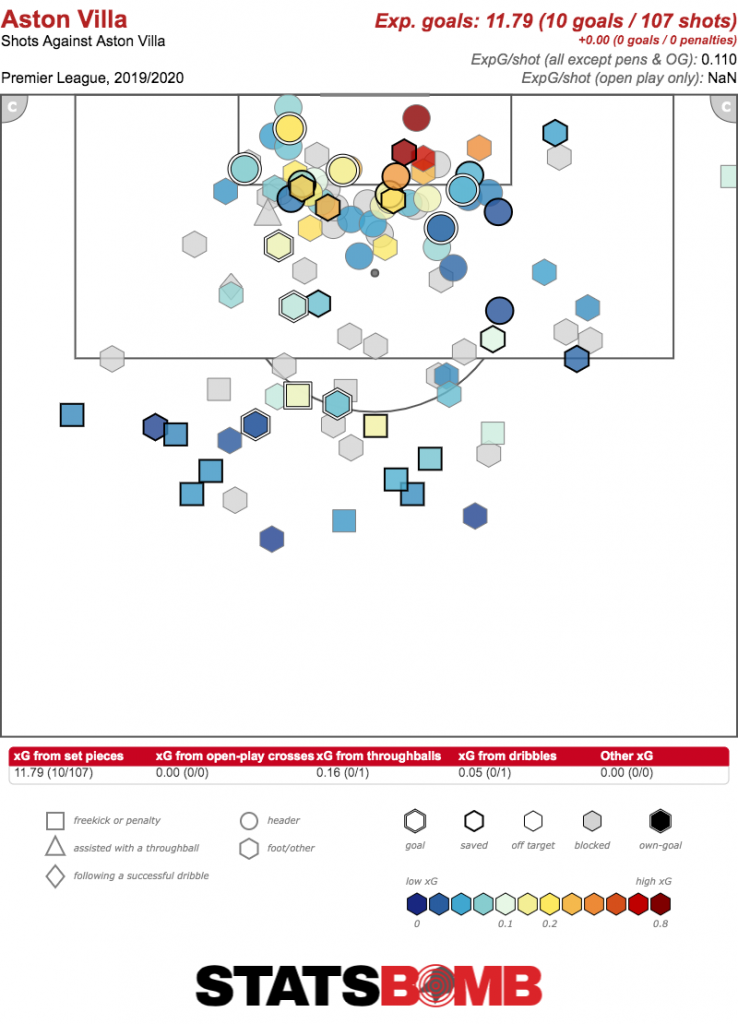 If you want an example of a promoted side who defend from set pieces properly, look no further than Sheffield United.
If you want an example of a promoted side who defend from set pieces properly, look no further than Sheffield United.  In a very quiet January transfer window, some talk has emerged of Olivier Giroud making the move to Tottenham. Of course, players can fall off a cliff in their 30s at any point, but if Spurs can get the same production out of him as he’s delivered over the last 18 months, he would be a decent short term solution. Just as long as they don’t tie him to a ludicrous contract.
In a very quiet January transfer window, some talk has emerged of Olivier Giroud making the move to Tottenham. Of course, players can fall off a cliff in their 30s at any point, but if Spurs can get the same production out of him as he’s delivered over the last 18 months, he would be a decent short term solution. Just as long as they don’t tie him to a ludicrous contract. 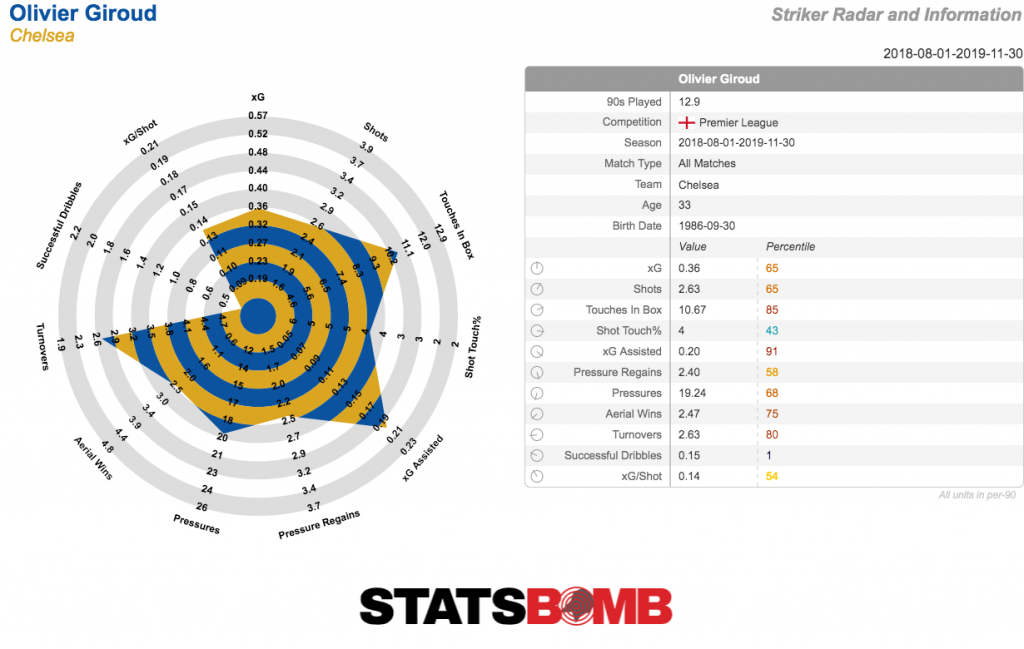
On Friday we looked at the first half of the top ten attacking players in Serie A. Today we reveal the second half of the list, with the caveat being they are in no particular order.
I thought long and hard about whether to include Paulo Dybala and Gonzalo Higuaín among the top 10 players in Serie A. I was convinced that one of them deserved a place, but I couldn't make up my mind which because each brings a different contribution to the game, and objectively both have raised the level of their performance compared to last season. So I'm cheating. The two Argentineans would be first-team players for any other club, and although they've been playing together with Cristiano Ronaldo in a three-man attack lately, previously Maurizio Sarri alternated them alongside the Portuguese. 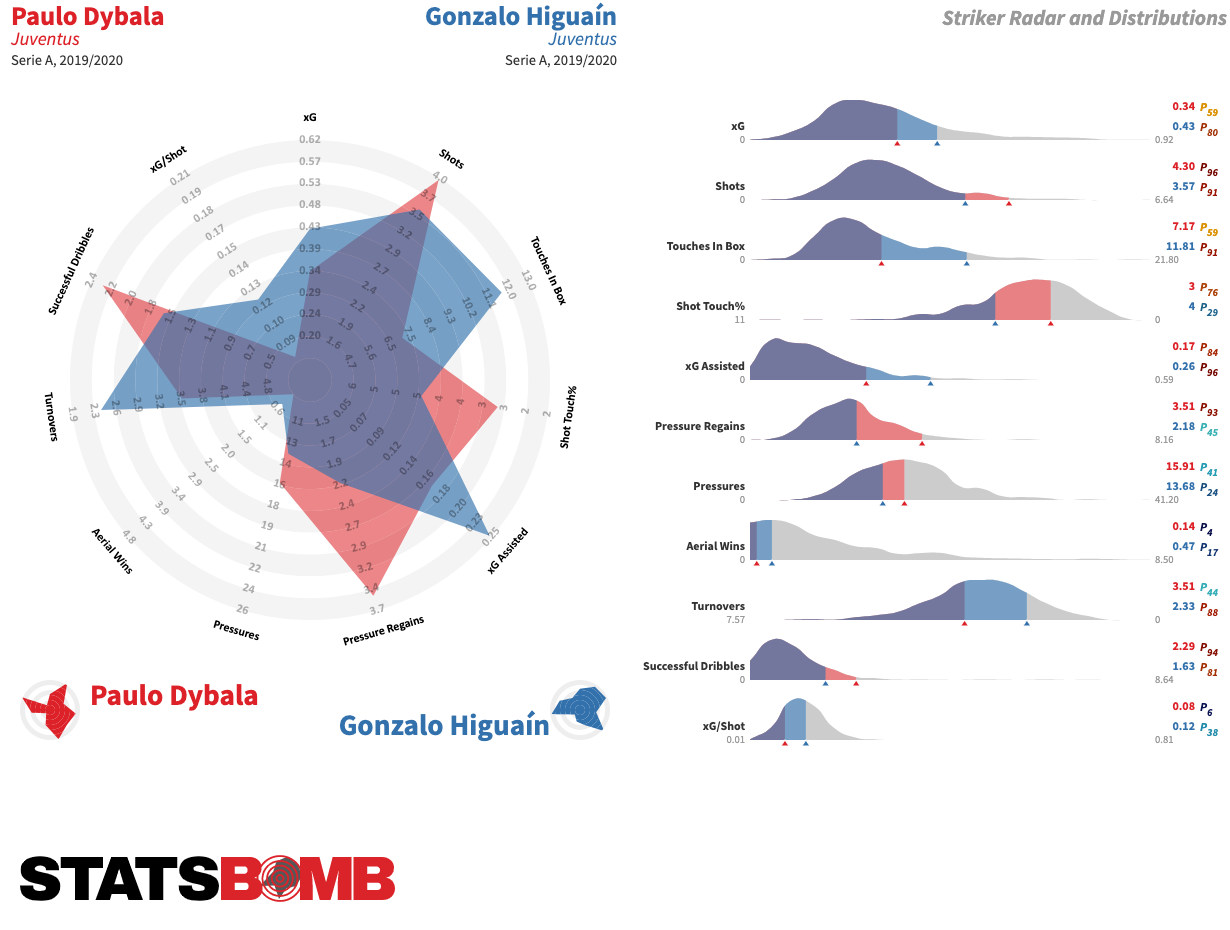 What distinguishes them is the way they influence games. Dybala needs to touch and shoot the ball a lot and challenge his opponent with his elite dribbling skills to create numerical superiority, while Higuaín can influence matches with his movements and his extraordinary ability to be in the right place at the right time, which in recent seasons has turned him into a great assist man as well a scorer. Dybala is approaching the peak of his career, while Higuaín has already surpassed it, but both had to sacrifice game time and touches to play alongside Ronaldo. However, this allowed him to bring out other qualities of their game, equally important for the team. That's how Dybala became one of the most effective strikers in pressing, and Higuaín one of the best creators in the league.
What distinguishes them is the way they influence games. Dybala needs to touch and shoot the ball a lot and challenge his opponent with his elite dribbling skills to create numerical superiority, while Higuaín can influence matches with his movements and his extraordinary ability to be in the right place at the right time, which in recent seasons has turned him into a great assist man as well a scorer. Dybala is approaching the peak of his career, while Higuaín has already surpassed it, but both had to sacrifice game time and touches to play alongside Ronaldo. However, this allowed him to bring out other qualities of their game, equally important for the team. That's how Dybala became one of the most effective strikers in pressing, and Higuaín one of the best creators in the league.
If there was an award for the most improved player in the league, Lautaro Martínez would likely take that trophy. The Argentinean forward made fans forget Mauro Icardi and the unfortunate vicissitudes of last season. Together with Lukaku, he forms one of the most powerful striker partnerships in Europe. 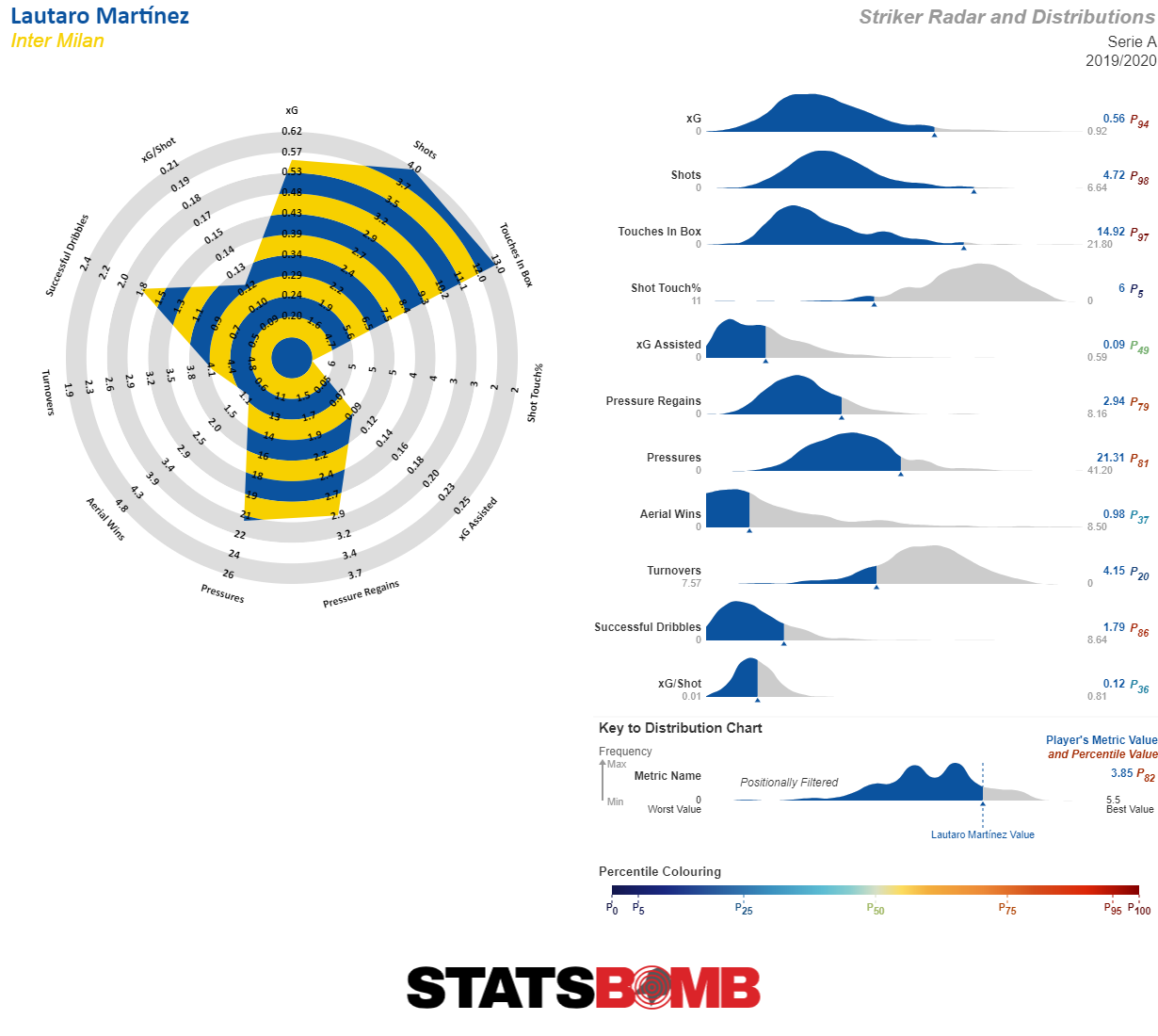 His shooting volume, as well as his involvement in the penalty area, are impressive for such a young forward. This is his first full season as a starter in a top 5 league, but he already has 10 goals (8 non-penalty goals + 2 penalties) and scores over the 90th percentile in shots, xG and touches inside the box per 90 minutes. What's also significant is how much he contributes to Inter's press, considering how little Lukaku offers in this respect. At the age of 22, Lautaro is one of the biggest prospects in world football and is likely to be highly coveted in the market next summer. Currently, he has a release clause of over €100 million, but Inter want to either drop or increase that clause in order to either retain the player or get the most they can squeeze out of another club for this young talent. Alejandro Gómez You'd think that Josip Iličić, with his 13 goals (including a hat-trick in the 7–0 victory over Torino this round, would symbolize Atalanta's success. However, he's been with the club only since 2017, and has never before had such a successful season, so that honor belongs to Alejandro Gómez. El Papu is more than the captain of Atalanta, he the cornerstone, the talisman, of La Dea, having signed with the Goddesses in 2014, two years before Gian Piero Gasperini took his place at the helm. Catania, who had their best-ever season in Serie A with Gómez as playmaker let him go to chase both more money and Champions League football with Metalist Kharkiv, a decision the player soon regretted. But it ended well for Atalanta fans, as under Gasperini's wing he helped the team qualify for Europa League in the manager's first season in charge, and clinch their first Champions League berth last season.
His shooting volume, as well as his involvement in the penalty area, are impressive for such a young forward. This is his first full season as a starter in a top 5 league, but he already has 10 goals (8 non-penalty goals + 2 penalties) and scores over the 90th percentile in shots, xG and touches inside the box per 90 minutes. What's also significant is how much he contributes to Inter's press, considering how little Lukaku offers in this respect. At the age of 22, Lautaro is one of the biggest prospects in world football and is likely to be highly coveted in the market next summer. Currently, he has a release clause of over €100 million, but Inter want to either drop or increase that clause in order to either retain the player or get the most they can squeeze out of another club for this young talent. Alejandro Gómez You'd think that Josip Iličić, with his 13 goals (including a hat-trick in the 7–0 victory over Torino this round, would symbolize Atalanta's success. However, he's been with the club only since 2017, and has never before had such a successful season, so that honor belongs to Alejandro Gómez. El Papu is more than the captain of Atalanta, he the cornerstone, the talisman, of La Dea, having signed with the Goddesses in 2014, two years before Gian Piero Gasperini took his place at the helm. Catania, who had their best-ever season in Serie A with Gómez as playmaker let him go to chase both more money and Champions League football with Metalist Kharkiv, a decision the player soon regretted. But it ended well for Atalanta fans, as under Gasperini's wing he helped the team qualify for Europa League in the manager's first season in charge, and clinch their first Champions League berth last season. 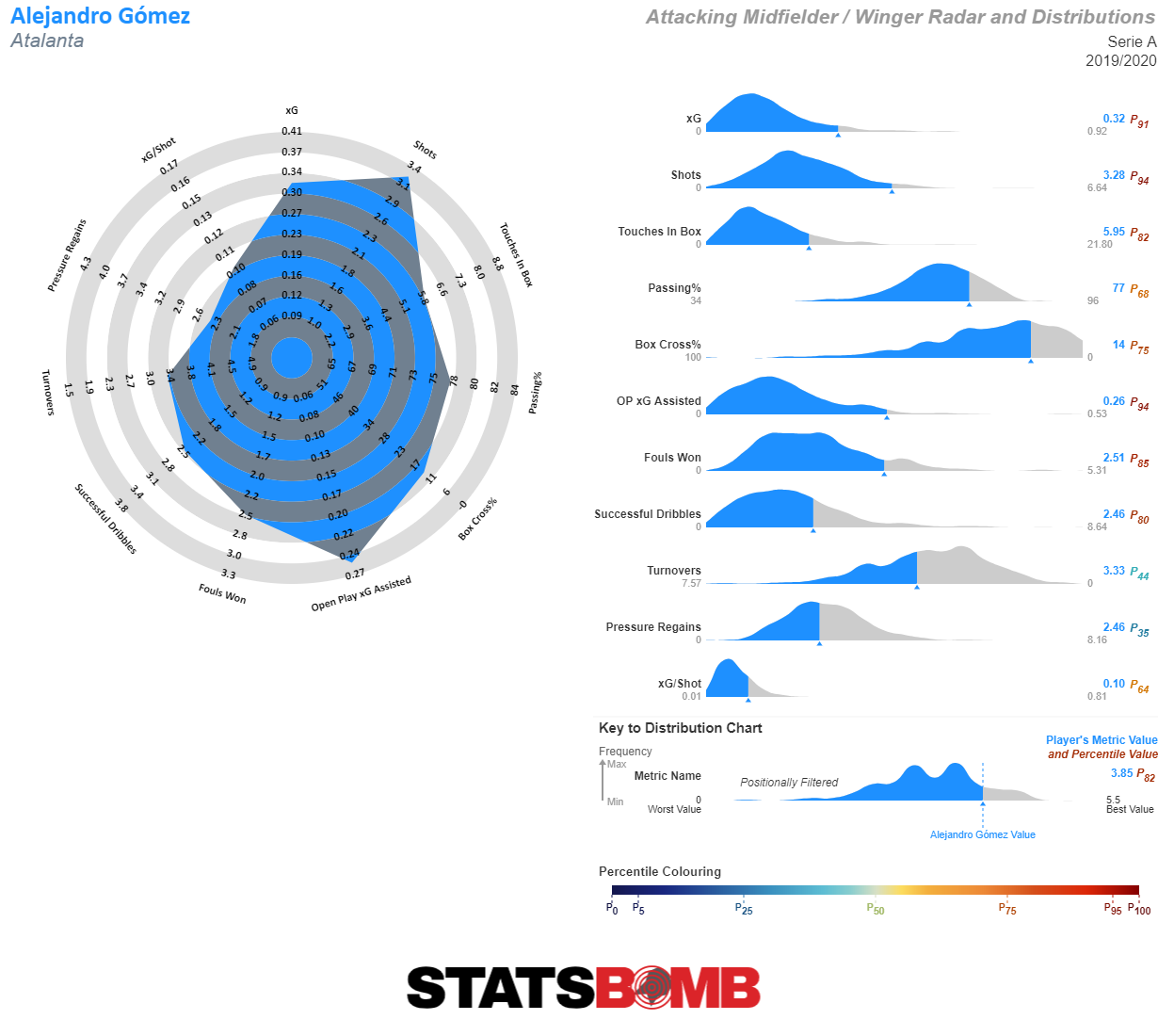 Gomez is a decisive player in a team fighting for a top-four finish; he's already leaving his mark this season with 6 goals and 7 assists (2nd in the league). Only Iličić creates more chances in Serie A, when considering both open play and set pieces, while Papu is 4th overall in xG assisted per 90. This season Gasperini is playing him deeper, so much so that he sometimes he switches positions with one of the central midfielders to encourage ball progression and relieve pressure on his teammates. In fact, he's fourth in Serie A in deep progressions per 90 (10.17). Papu belongs on this list as the technical and charismatic leader of the newest top 5 Italian team.
Gomez is a decisive player in a team fighting for a top-four finish; he's already leaving his mark this season with 6 goals and 7 assists (2nd in the league). Only Iličić creates more chances in Serie A, when considering both open play and set pieces, while Papu is 4th overall in xG assisted per 90. This season Gasperini is playing him deeper, so much so that he sometimes he switches positions with one of the central midfielders to encourage ball progression and relieve pressure on his teammates. In fact, he's fourth in Serie A in deep progressions per 90 (10.17). Papu belongs on this list as the technical and charismatic leader of the newest top 5 Italian team.
I felt compelled to include a Roma player as they're currently in the top four, but choosing between Edin Džeko and Lorenzo Pellegrini was quite difficult. In the end, I chose the Bosnian striker because Džeko is still the most solid certainty on Paulo Fonseca’s team. Not only is he Roma's top scorer with 8 non-penalty goals, but he is also the main point of reference for the team when there is a lack of short passing lanes; that's when his teammates lean on him to collect a long ball. And you can surely trust a striker in the 90th percentile in aerial duels. 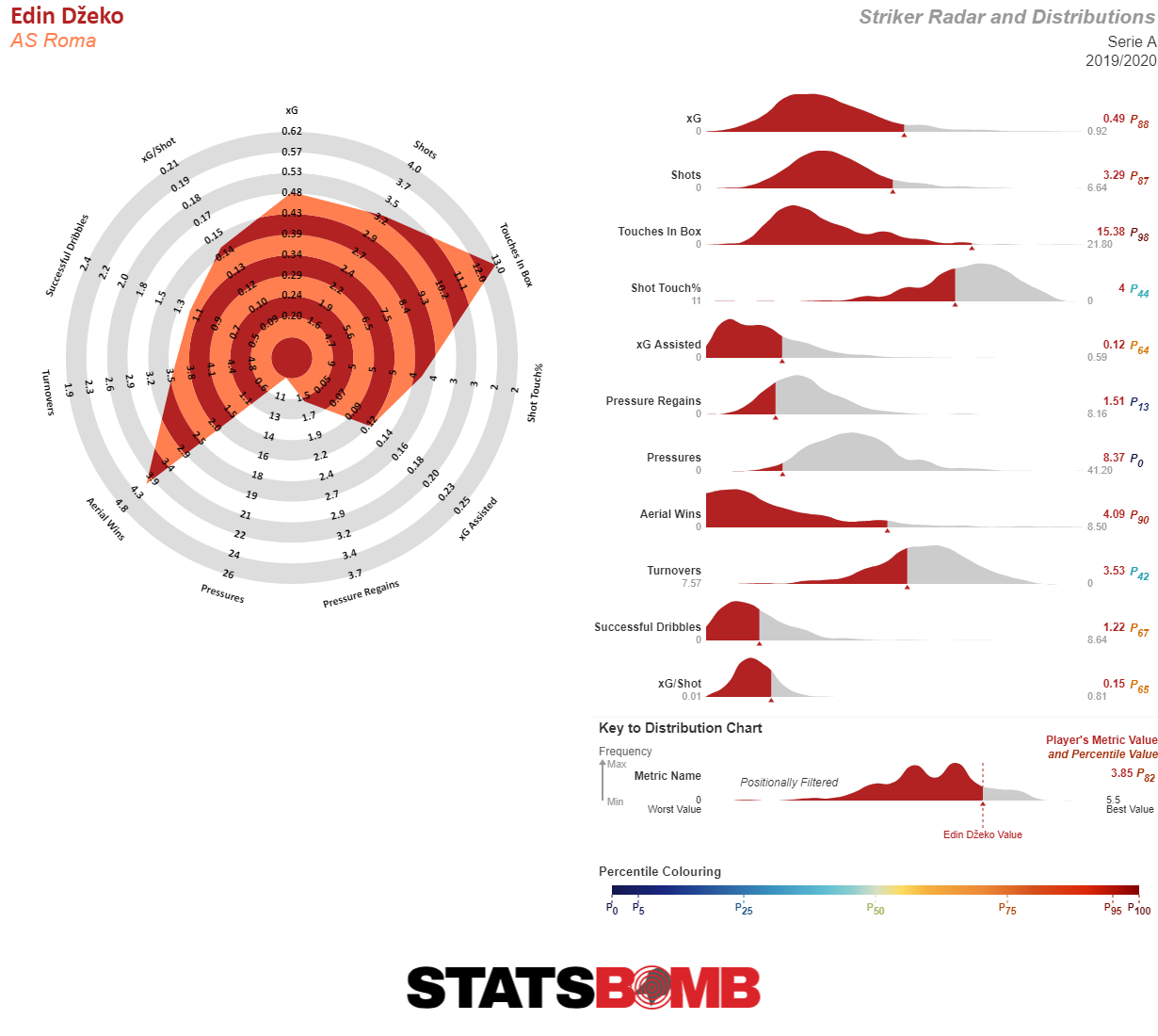 Džeko combines the rare ability to execute touches in zones away from the opponent's penalty area, and at the same time to record an elite number of touches in the box, depending on the game plan. He is also relatively wise in his shooting choices and often functions as bait to attract defenders to free his teammates. It's unlikely he'll put up the same goalscoring numbers that earned him the title of capocannoniere in 2016–17, but with the way he's playing, he's got no need to earn another top-scorer title. It's a team effort, and Džeko has always recognized that.
Džeko combines the rare ability to execute touches in zones away from the opponent's penalty area, and at the same time to record an elite number of touches in the box, depending on the game plan. He is also relatively wise in his shooting choices and often functions as bait to attract defenders to free his teammates. It's unlikely he'll put up the same goalscoring numbers that earned him the title of capocannoniere in 2016–17, but with the way he's playing, he's got no need to earn another top-scorer title. It's a team effort, and Džeko has always recognized that.
Sassuolo is, at the time of writing, eight points clear of the relegation zone; last season, they finished just five points clear. Yet, given certain neroverdi are having excellent seasons, it seems the side as a whole is not living up to expectations. The player finally having a breakout season—one many expected him to have a couple years ago, is Domenico Berardi, who at 25 has finally grown enough to no longer be considered a prospect in Italian football, but instead a player who has reached a higher level in his game (which, even if it means little to Sassuolo's prospects, should make Azzurri fans happy at least). 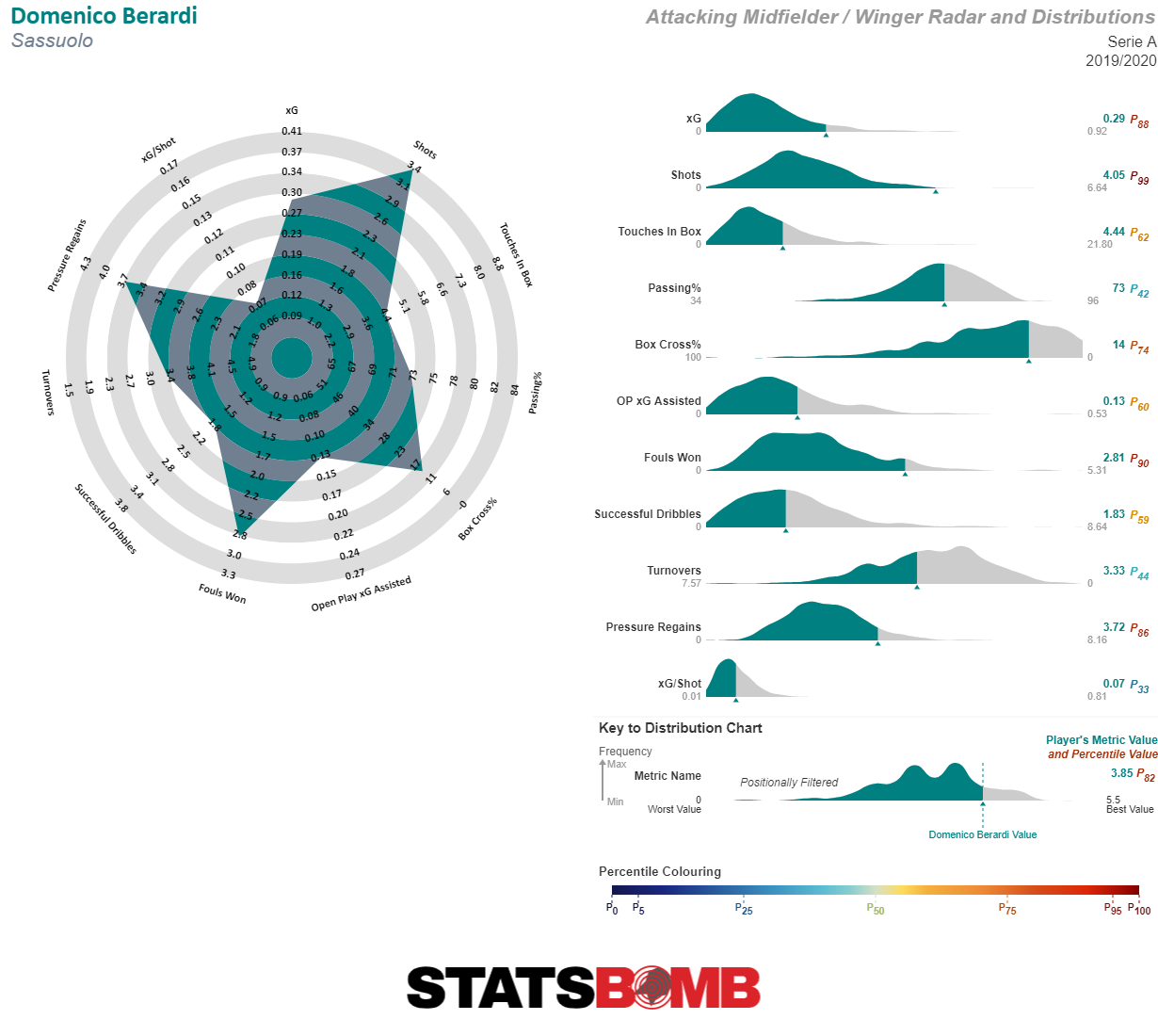 Choosing him as one of the top players in Italy may seem absurd, but the numbers back up this choice. He averages 0.66 non-penalty goals per 90, his best in seven Serie A seasons and the third-best individual output in the league. He also adds 0.14 assists per 90, for the third-league best scoring contribution. His shot selection may be dubious, but his finishing is been superb, so much so that only Immobile and his teammate Francesco Caputo have a higher-level over/under performance. Berardi scored 9 non-penalty goals from just 4.51 xG. In other words, he’s scored way more goals than his .31 xG predicted, Normally that would make us skeptical of his performances persisting going forward but even if he scores only at his xG total for the rest of the season he's still likely be considered one of Italy's top performers. 0.31 xG for 90 is a good average for a wide player, and no other winger who qualified for this list is doing better. Moreover, even if he is not a great dribbler, Berardi still manages to attract a decent number of fouls, as well as offering an important defensive contribution. Berardi's behavior has let Italian fans down several times in the past and his recent ban may keep him from another Italian call-up. Yet it is difficult to ignore a season like this, particularly as Italy are heading into Euro 2020 this summer, and want to put the embarrassment of not even qualifying for the 2018 World Cup behind them. Another brilliantly played half season may help him don the Azzurri jersey to help his country in the European Championships.
Choosing him as one of the top players in Italy may seem absurd, but the numbers back up this choice. He averages 0.66 non-penalty goals per 90, his best in seven Serie A seasons and the third-best individual output in the league. He also adds 0.14 assists per 90, for the third-league best scoring contribution. His shot selection may be dubious, but his finishing is been superb, so much so that only Immobile and his teammate Francesco Caputo have a higher-level over/under performance. Berardi scored 9 non-penalty goals from just 4.51 xG. In other words, he’s scored way more goals than his .31 xG predicted, Normally that would make us skeptical of his performances persisting going forward but even if he scores only at his xG total for the rest of the season he's still likely be considered one of Italy's top performers. 0.31 xG for 90 is a good average for a wide player, and no other winger who qualified for this list is doing better. Moreover, even if he is not a great dribbler, Berardi still manages to attract a decent number of fouls, as well as offering an important defensive contribution. Berardi's behavior has let Italian fans down several times in the past and his recent ban may keep him from another Italian call-up. Yet it is difficult to ignore a season like this, particularly as Italy are heading into Euro 2020 this summer, and want to put the embarrassment of not even qualifying for the 2018 World Cup behind them. Another brilliantly played half season may help him don the Azzurri jersey to help his country in the European Championships.
What I really like about NBA analytics is that you can use statistics to try to rank, in a more or less unbiased manner, the 5 to 10 best players in the league. Most reasonable people would likely agree with those rankings. It's a personal concern of mine that we can't do the same with football, where defensive and offensive roles are split because of the different nature of the game roles as well as the varying reliability of offensive and defensive statistics. Nevertheless, I often find myself wondering who the best players in Serie A are. Selecting the best offensive players is an easier bet, as individual attacking numbers can provide the analytics to support the top 10. Obviously, like any ranking of this kind, this is a subjective selection, but I hope you can agree with me in principle. I've been wanting to do this for some time, and since we're heading into the decisive part of the season the time seemed right. Before presenting my choices, I'd like to share the simple criteria and assumptions I considered:
With these factors in mind, I'll present five players today and five on Monday. Enjoy!
I wrote about Iličić in my last column, and I can confirm it now: Josip Iličić is perhaps the best player in Serie A and so he must be the first player to be featured in this list.  The Slovenian leads one of the most productive offensive units in league history and, together with current top goal scorer Ciro Immobile, is the only player in the league with a scoring contribution above 1.00. He tops, or is at least in the top five, of nearly all Serie A individual offensive leaderboards. I'm still amazed that he’s over the 95th percentile in xG (97th), shots (99th), touches in the box (99th), open play xG assisted (97th), fouls won (96th) and in the 90th percentile in dribbles in the attacking midfielder template. Although Atalanta have only collected one point in the last two games, he scored another fantastic backheel goal, even if it didn't help his team get the better of SPAL. Messi is the undisputed god of football, but Iličić is the lazy and unconscious demigod of Serie A.
The Slovenian leads one of the most productive offensive units in league history and, together with current top goal scorer Ciro Immobile, is the only player in the league with a scoring contribution above 1.00. He tops, or is at least in the top five, of nearly all Serie A individual offensive leaderboards. I'm still amazed that he’s over the 95th percentile in xG (97th), shots (99th), touches in the box (99th), open play xG assisted (97th), fouls won (96th) and in the 90th percentile in dribbles in the attacking midfielder template. Although Atalanta have only collected one point in the last two games, he scored another fantastic backheel goal, even if it didn't help his team get the better of SPAL. Messi is the undisputed god of football, but Iličić is the lazy and unconscious demigod of Serie A.
I still have Higuaín's hat-trick against Frosinone stuck in my head, particularly that incredible overhead goal that was the then-Napoli striker's 36th goal in 35 games, breaking a 66-year-old record. It was May 2016 and I honestly didn't expect to see another Serie A striker capable of breaking that record. Or at least I didn't expect to see one so soon. 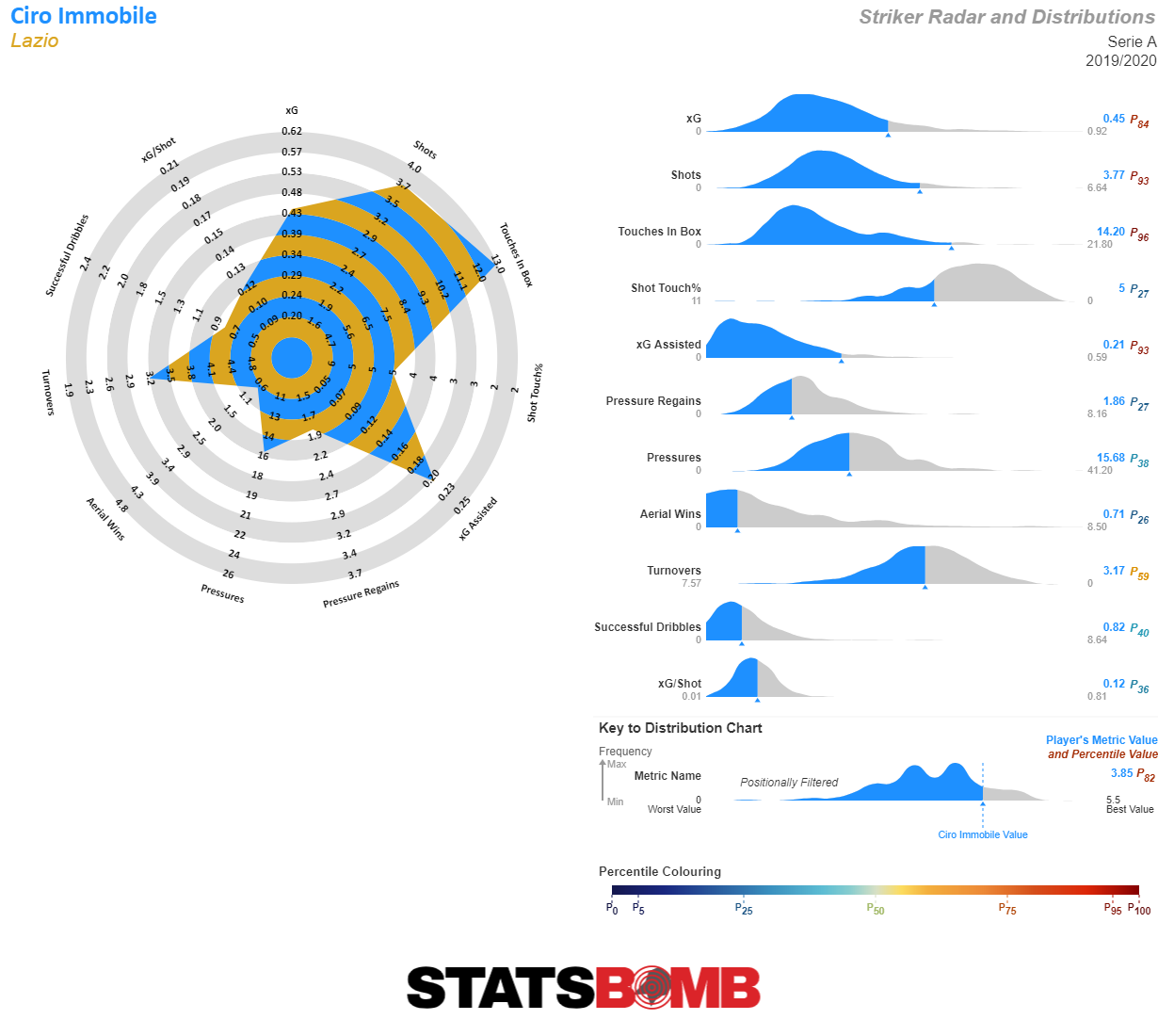 Ciro Immobile is making me reconsider. After featuring in 19 of Lazio's 20 games, the striker has scored 23 goals. Making a fairly simple calculation to forecast his scoring average in the remaining matches, Immobile could close his -season with as many as 44 goals. He is, therefore, another no-brainer for this list. Obviously, the fact that he scored 9 out of 10 penalties attempted inflates his scoring average and raises concrete doubts as to his real chances of breaking the record, yet Iličić (0.81) is the only player to have a higher non-penalty goals average (0.76) than Immobile. So far Immobile has been a relentless finisher, so much so that he has a non-penalty goals/xG ratio of 1.71, an extraordinary number that will be difficult to keep throughout the season. Yet one neglected aspect of his game this season has been his creative contribution. Immobile served 5 assists to his teammates; among Serie A strikers only Higuaín (0.26) averages more open play xG assisted per 90 (0.21). Immobile is having a career season and could easily beat his record of goals in one season (28). Italy fans will want to see him maintain those numbers going into 2020, as Italy will play all its Euro group stage games in his home stadium, the Olimpico.
Ciro Immobile is making me reconsider. After featuring in 19 of Lazio's 20 games, the striker has scored 23 goals. Making a fairly simple calculation to forecast his scoring average in the remaining matches, Immobile could close his -season with as many as 44 goals. He is, therefore, another no-brainer for this list. Obviously, the fact that he scored 9 out of 10 penalties attempted inflates his scoring average and raises concrete doubts as to his real chances of breaking the record, yet Iličić (0.81) is the only player to have a higher non-penalty goals average (0.76) than Immobile. So far Immobile has been a relentless finisher, so much so that he has a non-penalty goals/xG ratio of 1.71, an extraordinary number that will be difficult to keep throughout the season. Yet one neglected aspect of his game this season has been his creative contribution. Immobile served 5 assists to his teammates; among Serie A strikers only Higuaín (0.26) averages more open play xG assisted per 90 (0.21). Immobile is having a career season and could easily beat his record of goals in one season (28). Italy fans will want to see him maintain those numbers going into 2020, as Italy will play all its Euro group stage games in his home stadium, the Olimpico.
When in early December I provocatively asked on Twitter whether Cristiano Ronaldo was one of the top 10 players in Serie A, I had more than a few doubts about his status. He had just scored his sixth goal of the season, a penalty against Sassuolo, but he didn't seem to be as sharp as he was in his younger days, or even his younger older days. CR7 had scored less than his expected goals would have made you think until then and above all, he appeared to be limited by some physical issuess, which is exactly the problem you'd expect with a player who will turn 35 in less than two weeks. 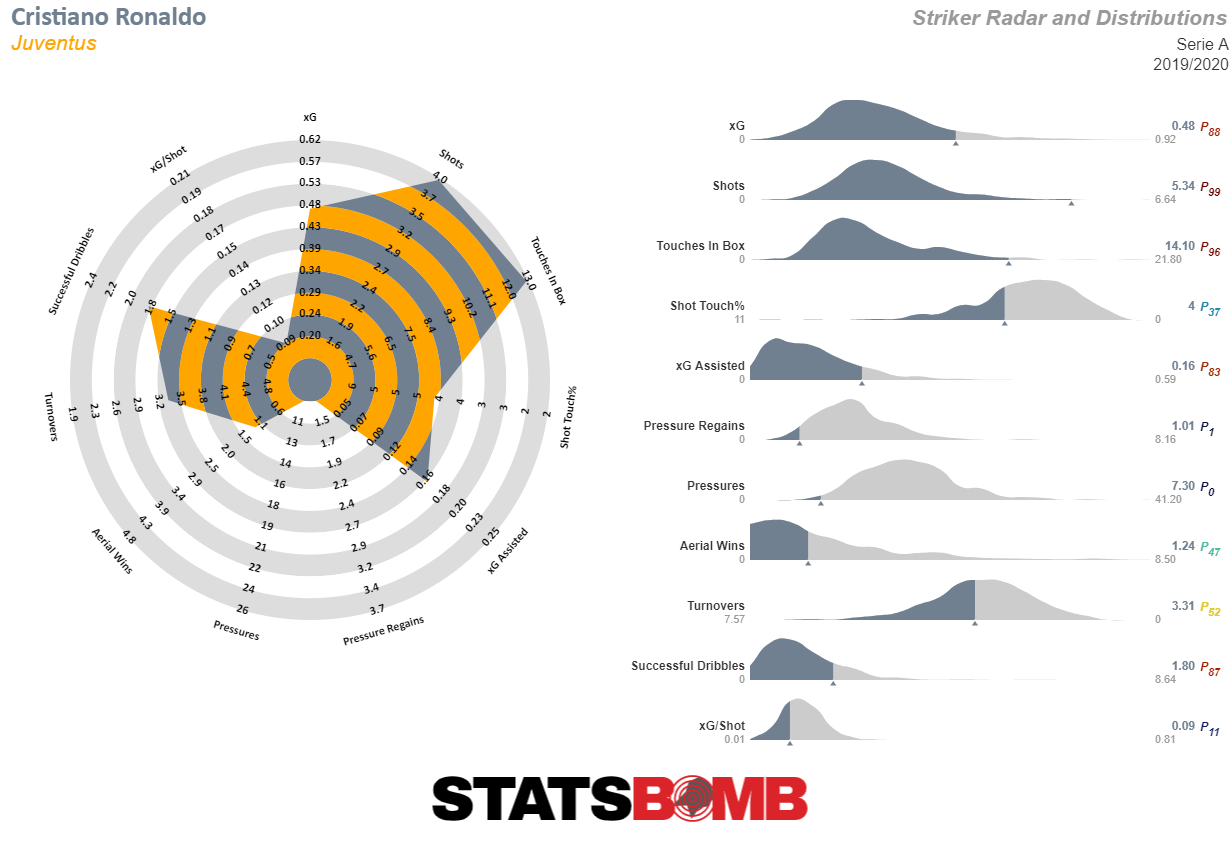 Any doubts were swept away by his performance in the next 6 league games, in which he scored 10 goals in total and confirmed once again that he is part of that small group of athletes able to remain at the very top even when their ID card seems to recommend thinking about retirement. Actually right now he seems to be in the better shape he has ever been since he arrived at Juventus in the summer of 2018. With the Champions League just around the corner, he hit his peak of fitness at just the right time. Maurizio Sarri had said he wanted to help Cristiano break new records and so he completely freed him from any defensive responsibility. Ronaldo is 5th in the league in non-penalty goals (0.62 per 90) yet he is practically non-existent when Juventus doesn't have the ball, to the point of being in the 1st percentile in pressure regains and eventually in the 0th percentile in pressures. In actual fact, the Juventus no. 7 is a luxury that few teams in the world can afford in modern football, but this is the tax to pay to enable him to still be one of the deadliest strikers in Europe today.
Any doubts were swept away by his performance in the next 6 league games, in which he scored 10 goals in total and confirmed once again that he is part of that small group of athletes able to remain at the very top even when their ID card seems to recommend thinking about retirement. Actually right now he seems to be in the better shape he has ever been since he arrived at Juventus in the summer of 2018. With the Champions League just around the corner, he hit his peak of fitness at just the right time. Maurizio Sarri had said he wanted to help Cristiano break new records and so he completely freed him from any defensive responsibility. Ronaldo is 5th in the league in non-penalty goals (0.62 per 90) yet he is practically non-existent when Juventus doesn't have the ball, to the point of being in the 1st percentile in pressure regains and eventually in the 0th percentile in pressures. In actual fact, the Juventus no. 7 is a luxury that few teams in the world can afford in modern football, but this is the tax to pay to enable him to still be one of the deadliest strikers in Europe today.
Antonio Conte wanted Lukaku at all costs, and the Belgian couldn't wait to make himself available. It took over €65 million, the highest amount ever paid by Inter, to snatch him from Manchester United, but the forward immediately established himself as one of the best strikers in Serie A, silencing those who had criticized his purchase and probably causing more than a few regrets to Ole Gunnar Solskjær, whose attack is shorthanded and underwhelming in his absence.  After playing every match so far —19 out of 20 from the first minute — Lukaku has scored as much as Ronaldo if we exclude penalties (11 non-penalty goals). He also shares with Ronaldo the number of touches in the penalty area and the very poor contribution to team pressing. Nevertheless, he has been integral to Inter's success so far, and it will likely be he that deserves the credit should his team keep Juventus away from the scudetto. Luis Alberto, Lazio Lazio and Inter are the only teams capable of threatening Juventus' dominance, and Lazio are still the only team in Europe to have beaten the Bianconeri this season, and to have done so twice, in the league and in the Italian Super Cup. If Immobile dominates the top-scorer rankings, Luis Alberto is the best in Serie A at providing assists (9) and has accumulated the most xG assisted (5.49). Together they are the two most important players on Simone Inzaghi's team.
After playing every match so far —19 out of 20 from the first minute — Lukaku has scored as much as Ronaldo if we exclude penalties (11 non-penalty goals). He also shares with Ronaldo the number of touches in the penalty area and the very poor contribution to team pressing. Nevertheless, he has been integral to Inter's success so far, and it will likely be he that deserves the credit should his team keep Juventus away from the scudetto. Luis Alberto, Lazio Lazio and Inter are the only teams capable of threatening Juventus' dominance, and Lazio are still the only team in Europe to have beaten the Bianconeri this season, and to have done so twice, in the league and in the Italian Super Cup. If Immobile dominates the top-scorer rankings, Luis Alberto is the best in Serie A at providing assists (9) and has accumulated the most xG assisted (5.49). Together they are the two most important players on Simone Inzaghi's team. 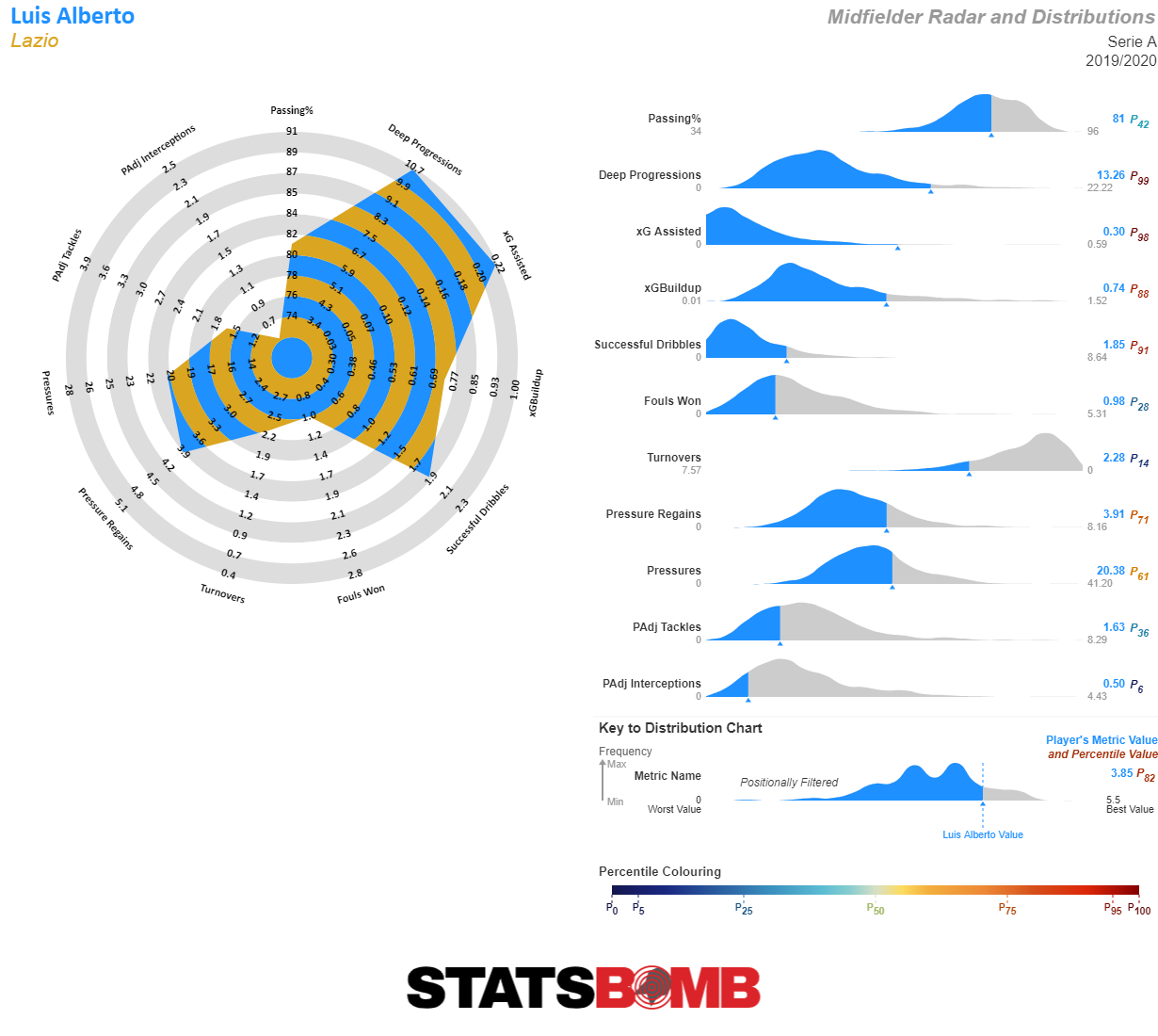 Since he arrived at Lazio from Liverpool, the growth of the Spaniard has been exponential. Inzaghi tailored the no. 8 role for him, from which he manages much of the ball progression and the chance creations for his team. There are few players in Europe who have his Zidanesque touch and who can pass like him, finding openings even where there are none. His through-balls are a sight to behold, and I'd go so far as to say that if tomorrow the alien race in Space Jam returned to Earth to challenge the Looney Tunes to footgolf instead of basketball, Bugs Bunny would probably knock on Luis Alberto's door. We'll be back on Monday with the final five players on the list.
Since he arrived at Lazio from Liverpool, the growth of the Spaniard has been exponential. Inzaghi tailored the no. 8 role for him, from which he manages much of the ball progression and the chance creations for his team. There are few players in Europe who have his Zidanesque touch and who can pass like him, finding openings even where there are none. His through-balls are a sight to behold, and I'd go so far as to say that if tomorrow the alien race in Space Jam returned to Earth to challenge the Looney Tunes to footgolf instead of basketball, Bugs Bunny would probably knock on Luis Alberto's door. We'll be back on Monday with the final five players on the list.
And we are back! Let’s get all things Bundesliga going again here at Statsbomb with a winter transfer roundup. How will the new signings of Bayern München and Borussia Dortmund impact the title race? What’s up with Herbstmeister RB Leipzig’s transfer decisions? And which other winter signings should peak our attention in the remainder of this Bundesliga season? Let’s take a look.
So, let’s start off with a pretty weird one. Weird, from a Real Madrid perspective, that is. Because the Spanish powerhouse is willing to loan Álvaro Odriozola to defensively decimated Bayern München - a Champions League rival - for the remainder of the season, whilst not having a proper back-up in-house for starting right-back Dani Carvajal.  Although Odriozola could not produce the same form and production in Madrid as he did in his fine 2017/18 season for Real Sociedad, Bayern seem to be getting a fine addition for the right-back position. With Niklas Süle out for the season, Lucas Hernández out injured for the first six months of his Bayern tenure, Jérôme Boateng falling off a cliff form-wise, Benjamin Pavard’s ups and downs and Javi Martínez picking up his once-a-season-knock, the defence has been patchwork almost every week. But the addition of loanee Odriozola will not only help out the backline. With another right-footed defender to choose from, Hansi Flick can now use Joshua Kimmich as a full-time midfielder. In the shadow of Robert Lewandowski monster production, Kimmich has been excellent as the sole defensive midfielder in Flick’s high-pressing 4-1-4-1.
Although Odriozola could not produce the same form and production in Madrid as he did in his fine 2017/18 season for Real Sociedad, Bayern seem to be getting a fine addition for the right-back position. With Niklas Süle out for the season, Lucas Hernández out injured for the first six months of his Bayern tenure, Jérôme Boateng falling off a cliff form-wise, Benjamin Pavard’s ups and downs and Javi Martínez picking up his once-a-season-knock, the defence has been patchwork almost every week. But the addition of loanee Odriozola will not only help out the backline. With another right-footed defender to choose from, Hansi Flick can now use Joshua Kimmich as a full-time midfielder. In the shadow of Robert Lewandowski monster production, Kimmich has been excellent as the sole defensive midfielder in Flick’s high-pressing 4-1-4-1.
We’ll keep this one short, because I have a strong suspicion (wink-wink) that you’ll be able to find plenty of Erling Haaland-related content on this here website in the coming months - y’know, with the Norwegian teenager being a prodigious striking talent and all that. But, yeah. Borussia Dortmund have added some serious fire-power with this winter signing. 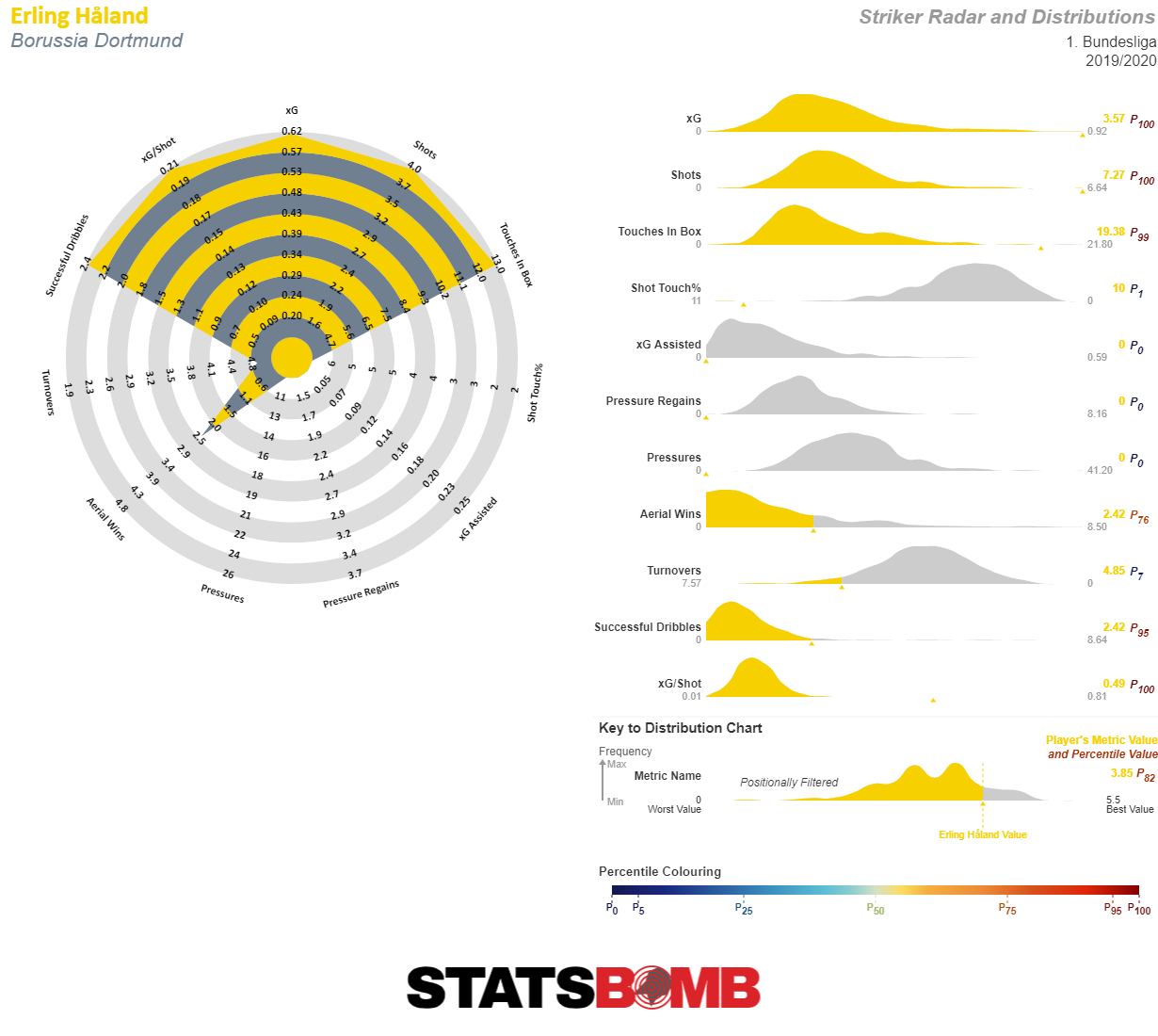
Three weird things occurred with Leipzig and winter signings this month. First, Haaland did not travel the well known route between Red Bull Salzburg and the East German ‘mother club’, even opting for a move to a rival of Leipzig. The same can be said for Salzburg central defender Marin Pongragic’ (see below) move to VfL Wolfsburg - although Leipzig already have an amazing amount of talented centre back. But maybe the most surprising bit of transfer news concerning the current Bundesliga leaders was the winter move of Diego Demme. 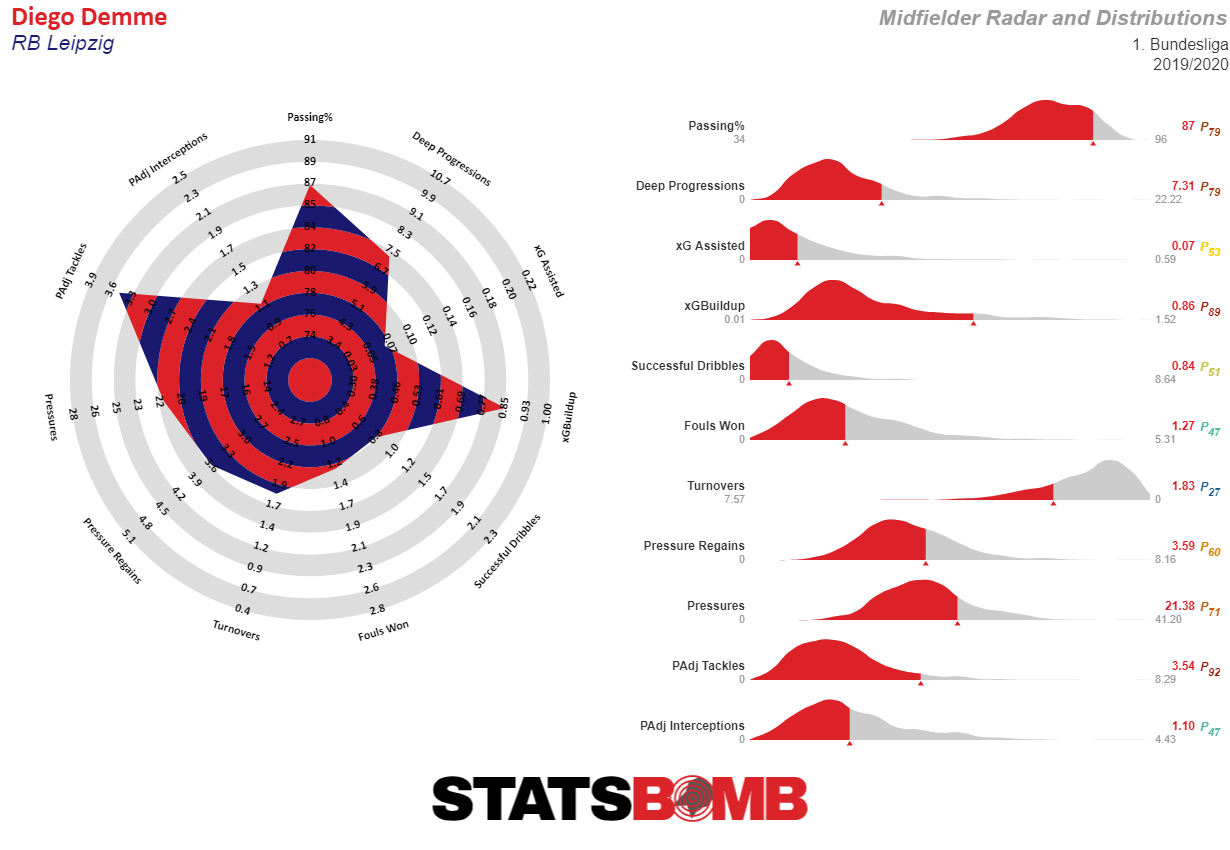 Of all outfield players in the squad, only Timo Werner, Lukas Klostermann and Marcel Sabitzer played more minutes for Leipzig before the winter break than the diminutive midfield motor Demme. But Julian Nagelsmann has stated time and time again that he is primarily a players-first-manager, and that he will not stand in the way if one of his players can make a dream move. With Demme’s Napoli move (Demme is half-Italian), those words hold true. That Leipzig hasn’t searched for a direct replacement of the defensive midfielder, tells a lot about the club’s expectations surrounding Tyler Adams. The 20 year-old American played in Demme’s spot in midfield in the first league game of 2020, and seems to be a starting lineup candidate for the remainder of this season.
Of all outfield players in the squad, only Timo Werner, Lukas Klostermann and Marcel Sabitzer played more minutes for Leipzig before the winter break than the diminutive midfield motor Demme. But Julian Nagelsmann has stated time and time again that he is primarily a players-first-manager, and that he will not stand in the way if one of his players can make a dream move. With Demme’s Napoli move (Demme is half-Italian), those words hold true. That Leipzig hasn’t searched for a direct replacement of the defensive midfielder, tells a lot about the club’s expectations surrounding Tyler Adams. The 20 year-old American played in Demme’s spot in midfield in the first league game of 2020, and seems to be a starting lineup candidate for the remainder of this season. 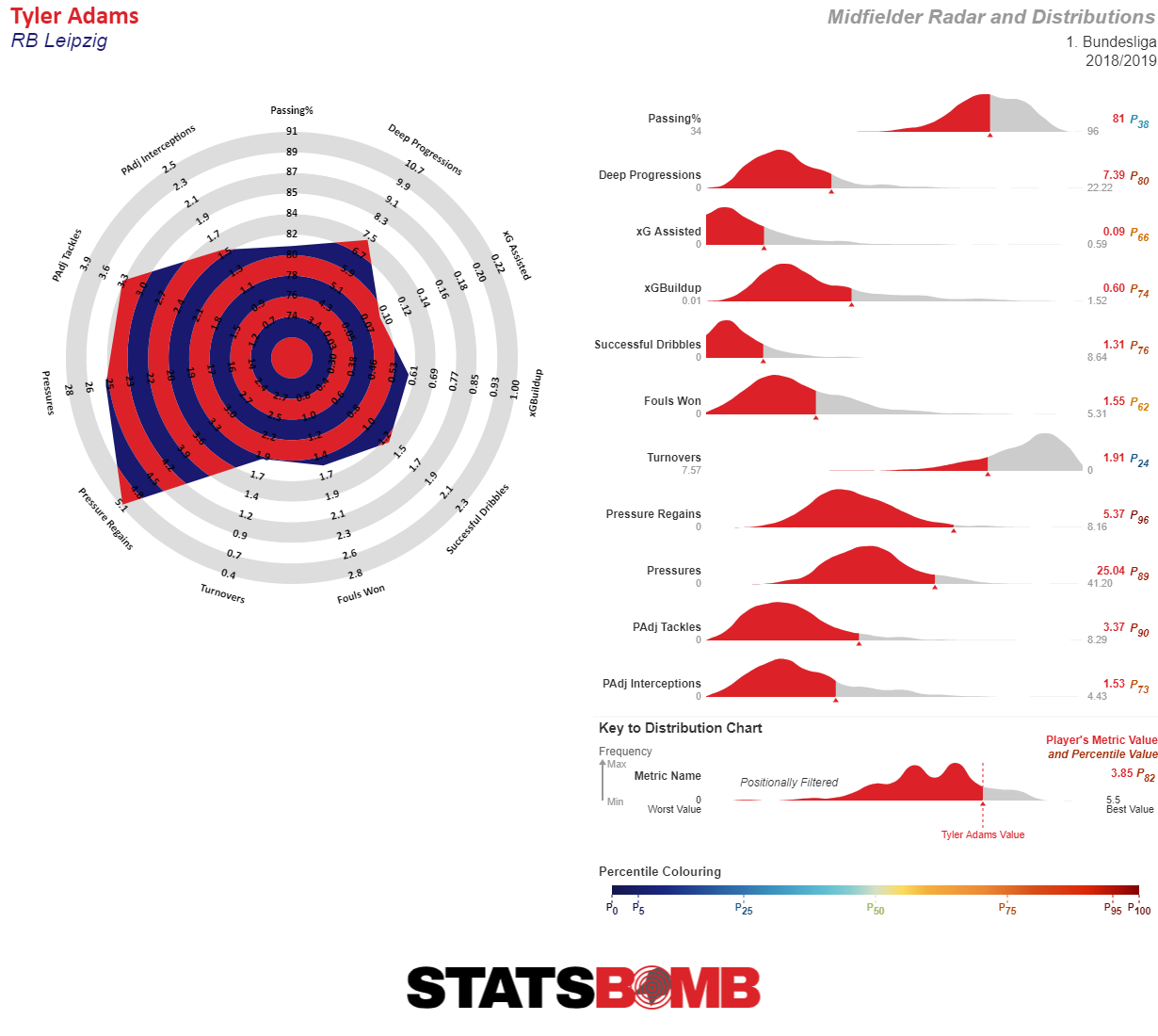
The good news for Bayer Leverkusen: Die Werkself are only five points out of second placed Bayern München in mid-January. The bad news: Peter Bosz’ squad has been extremely inconsistent thus far, trading excellent performances with very shaky outings on a week-to-week basis. To combat this inconsistency, Leverkusen have made a splash signing this month. For a fee surrounding 17 million Euros, they’ve brought in River Plate wonder boy Exequiel Palacios. The 21-year old midfield dynamo can do a bit of everything on the pitch, and, very important for Bosz’ press-heavy playing style, can handle an extreme workload. Leverkusen have paid a lofty fee for the young Argentinian, but this signing has the potential to be a super move. 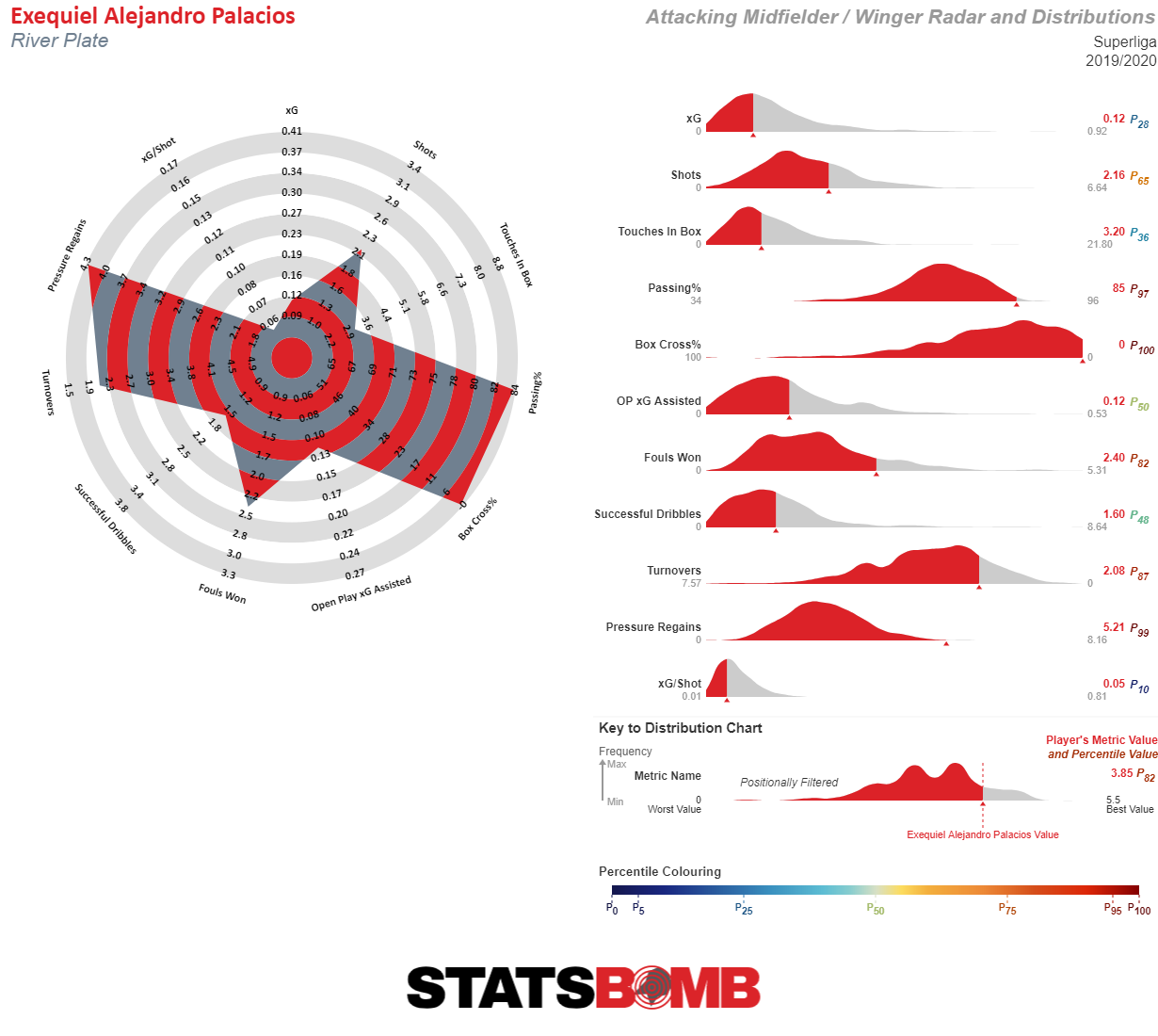
The same can be said for Wolfsburg’s signing of Salzburg centre-back Pongracic. With the 10 million Euro signing of the Croatian defenceman, Die Wölfe are adding to their strength. Under new manager Oliver Glasner, Wolfsburg haven’t wowed anyone this season - they lack the individual player talent to do so, to be fair - but they have sneakily been one of the best defensive teams in the Bundesliga thus far. 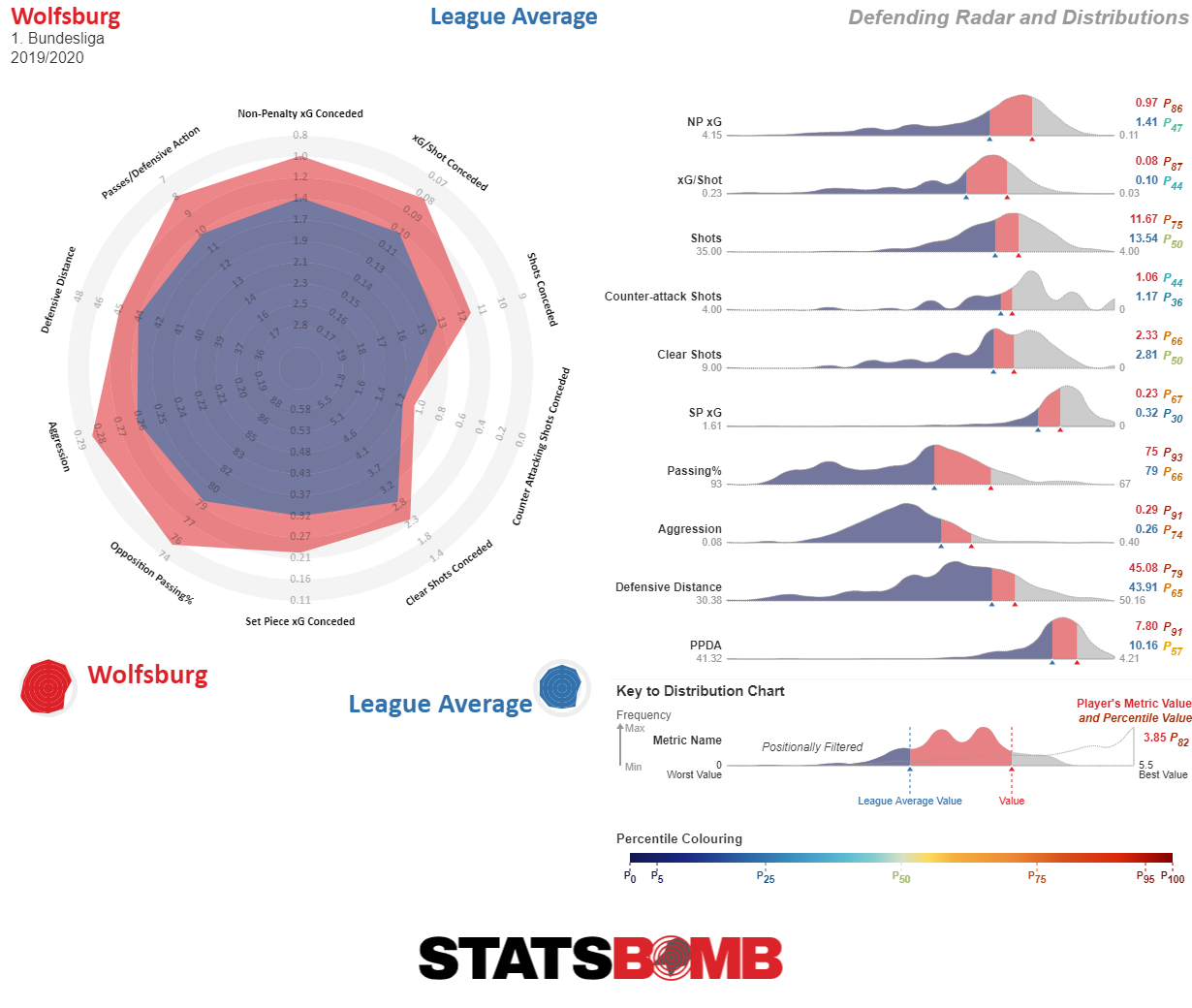 Pongracic, only made five league appearances this season but the 22 year-old was downright excellent for Salzburg, when he did play and Wolfsburg have added another serious defensive talent to their squad.
Pongracic, only made five league appearances this season but the 22 year-old was downright excellent for Salzburg, when he did play and Wolfsburg have added another serious defensive talent to their squad. 
Kevin Vogt was one of TSG Hoffenheim’s most important players, when Nagelsmann was still at the helm. The gigantic (6 foot 4, 190 pounds) former midfielder served as a crucial ‘backline playmaker’ as the most central man in Nagelsmann back three in the defensive heart. But with the arrival of new manager Alfred Schreuder, and the switch to a somewhat more expansive style of build-up play, Vogt’s star faded at Hoffenheim this season. 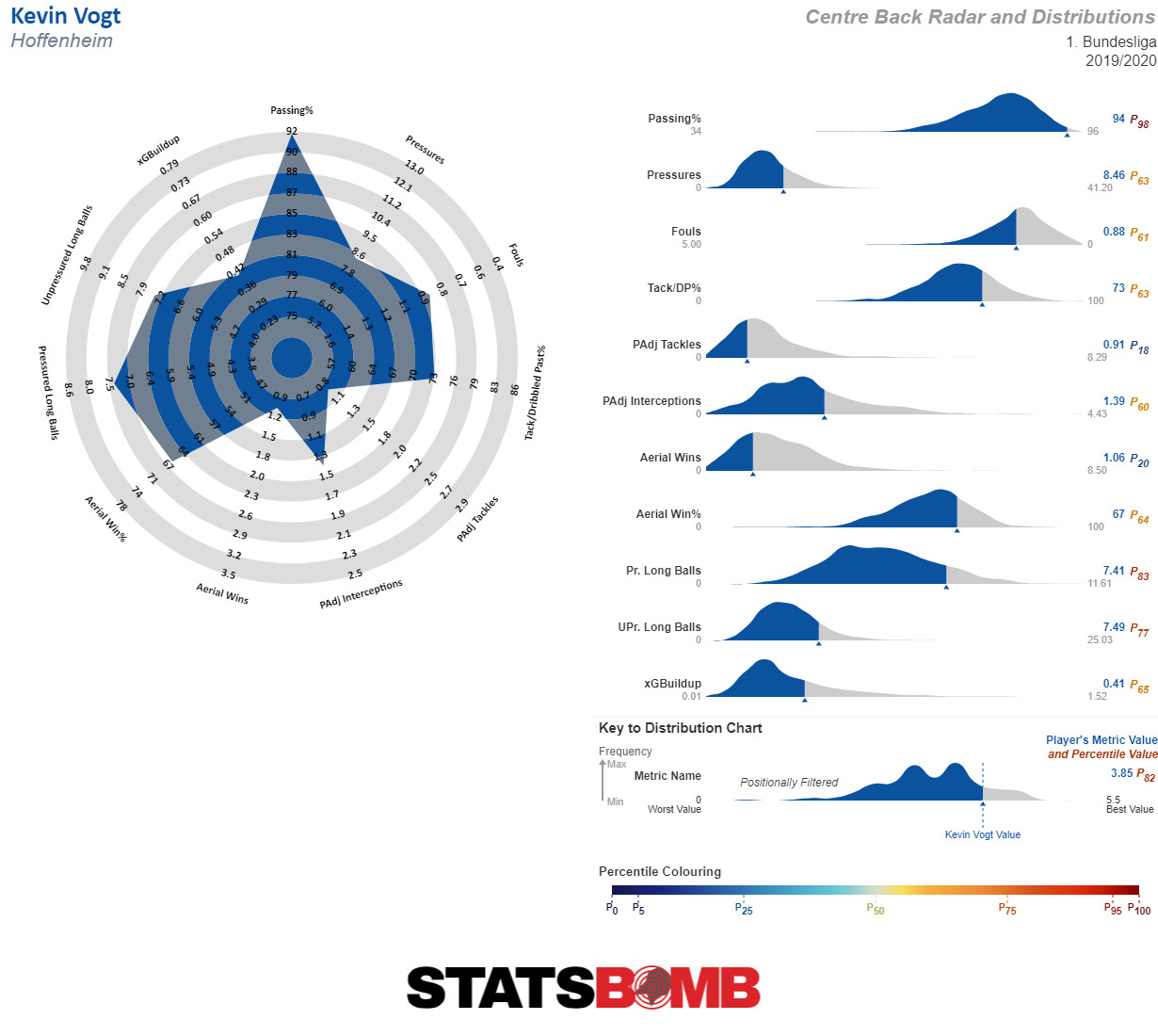 Enter Werder Bremen, who had a horrible first half of the season, and seem to have find an ideal band-aid in loanee Vogt. With Werder conceding a league-leading (trailing, if you will) 41 goals before the winter break, manager Florian Kohfeldt seems to have settled on a 5-3-2 setup as the new playing system, to shore up the defensive performances. Vogt adds strength, experience and plus-level passing ability as the central man in Werder’s revamped backline.
Enter Werder Bremen, who had a horrible first half of the season, and seem to have find an ideal band-aid in loanee Vogt. With Werder conceding a league-leading (trailing, if you will) 41 goals before the winter break, manager Florian Kohfeldt seems to have settled on a 5-3-2 setup as the new playing system, to shore up the defensive performances. Vogt adds strength, experience and plus-level passing ability as the central man in Werder’s revamped backline.
January 2020 can serve as a neat microcosm of Schalke’s transfer policy of recent years. Former Tottenham badboy Nabil Bentaleb (Newcastle United), 2. Bundesliga standout Steven Skrzybski (Fortuna Düsseldorf) and underrated Eredivisie attacker Mark Uth (FC Köln) were all deemed no longer necessary, and were loaned out. Out go three safe, but failed gambles. In come two new ones. To bolster the defence, Schalke 04 turn to ‘the next Raphaël Varane’, Jean-Clair Todibo, who did not, in fact, turn out to be ‘the next Raphaël Varane’ in his first months at Barcelona. (Related: maybe stop naming talented teenagers the next so-and-so.)  But if Todibo can regain the form from his first months in the first squad of Toulouse, Die Königsblauen have added a fine defensive talent to their ranks. In attack, Schalke took the opposite approach, as with Michael Gregoritsch (25), manager David Wagner has gotten an extra, Bundesliga-proven option for his frontline. The Austrian fizzled out at FC Augsburg, but scored on his Schalke debut on Friday.
But if Todibo can regain the form from his first months in the first squad of Toulouse, Die Königsblauen have added a fine defensive talent to their ranks. In attack, Schalke took the opposite approach, as with Michael Gregoritsch (25), manager David Wagner has gotten an extra, Bundesliga-proven option for his frontline. The Austrian fizzled out at FC Augsburg, but scored on his Schalke debut on Friday. 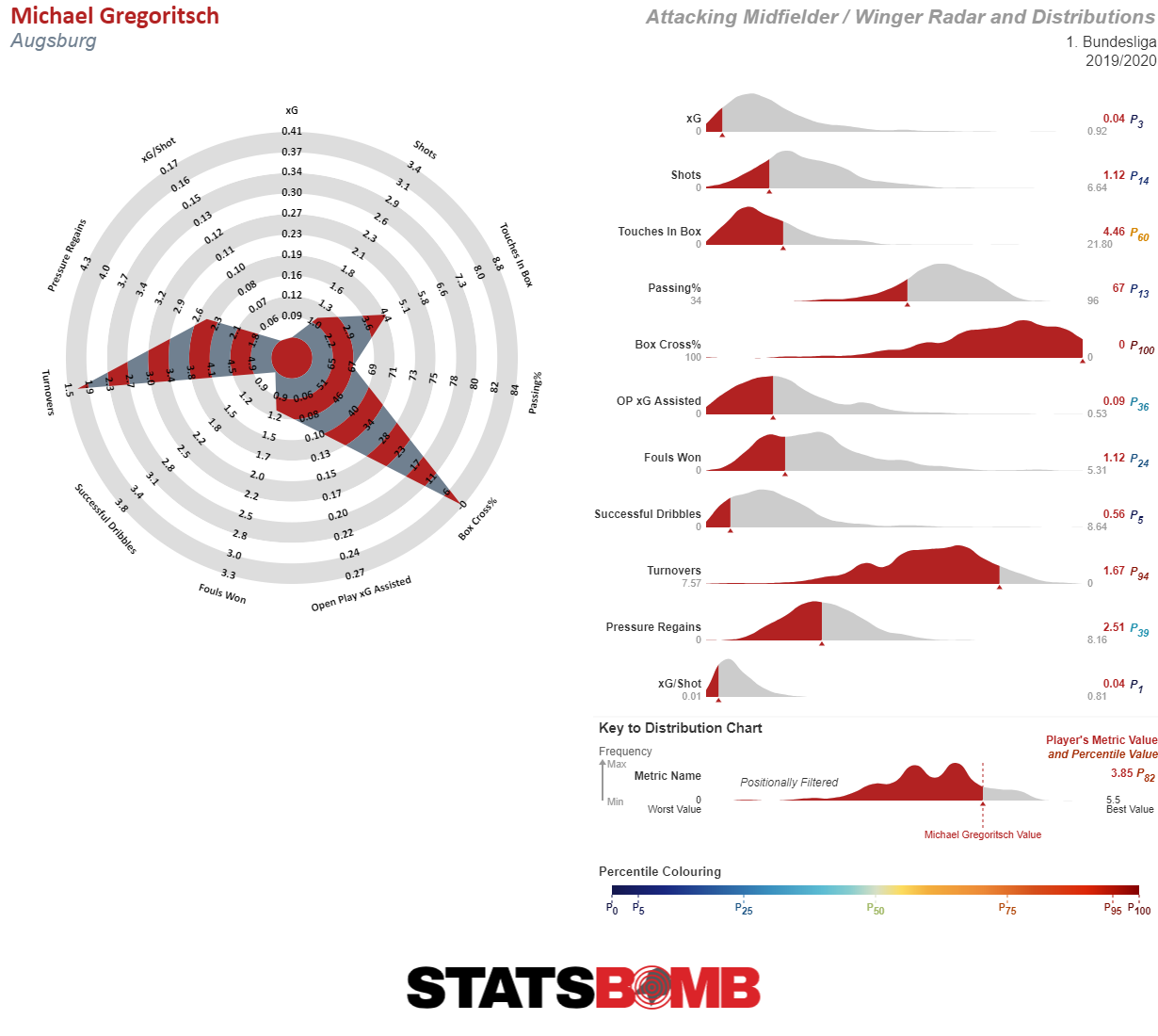
The most interesting bits and pieces from La Liga Matchday 20.
As statements of intent go, it was a pretty clear one. Surprisingly, the scoreline was not the main talking point from Barcelona’s 1–0 win over Granada in Quique Setíen’s debut on the Camp Nou bench. As you probably know by now, Barcelona passed and passed and passed, attempting over 1,000 and completing over 900 for the first time since . . . well, since their draw with Valencia last October, but let’s not derail the narrative too quickly. Snark aside, what was most noteworthy was Setién’s attempt to tackle the problem of the overlapping skillsets of Antoine Griezmann and Lionel Messi. Aided in that sense by the absence through injury of Luis Suárez, he brought Griezmann infield from the slightly awkward left-sided forward position he's occupied for much of the campaign, and placed him alongside Messi in a pairing of roving forwards up front. With Ansu Fati and Jordi Alba providing width on the right and left respectively in a formation probably most accurately described as a 3-3-4, both Griezmann and Messi had the freedom to drop off the front to receive, combine and advance. Messi drifted with his usual impunity, as this map of his pass receipts shows. 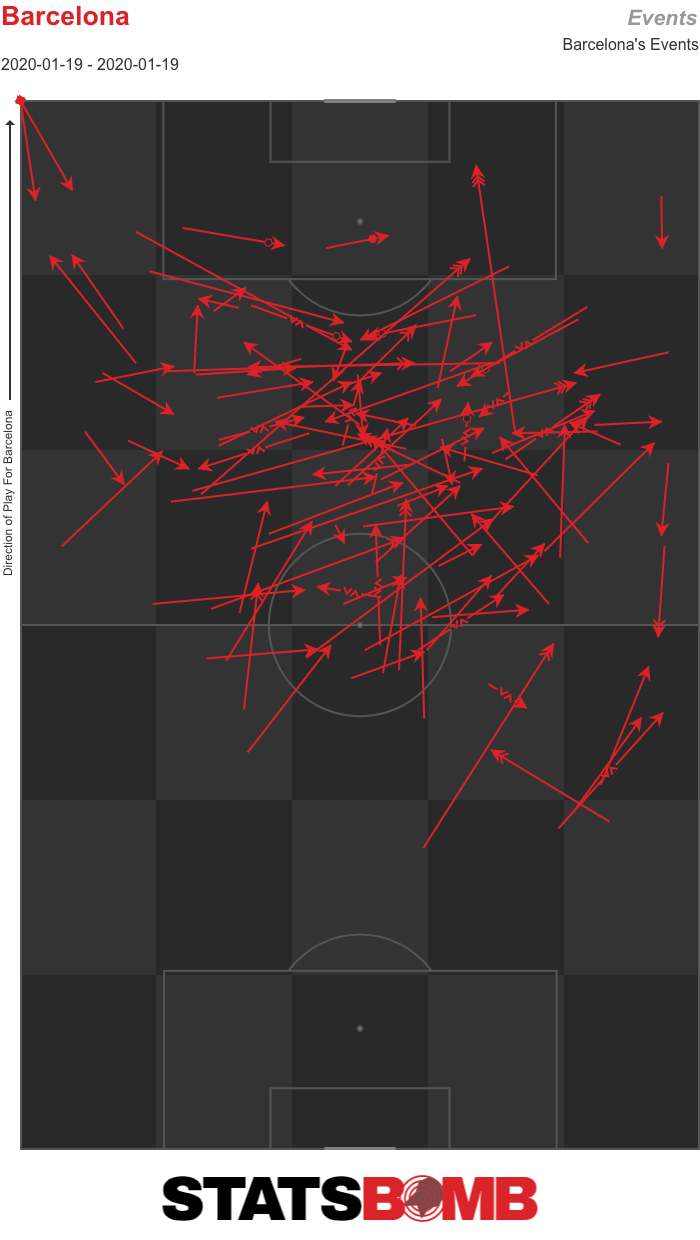 And while Griezmann was at times tasked with stretching play in behind, he was also able to get involved in deeper central areas more frequently than has often been the case this season. This was not the denatured Griezmann of performances past.
And while Griezmann was at times tasked with stretching play in behind, he was also able to get involved in deeper central areas more frequently than has often been the case this season. This was not the denatured Griezmann of performances past. 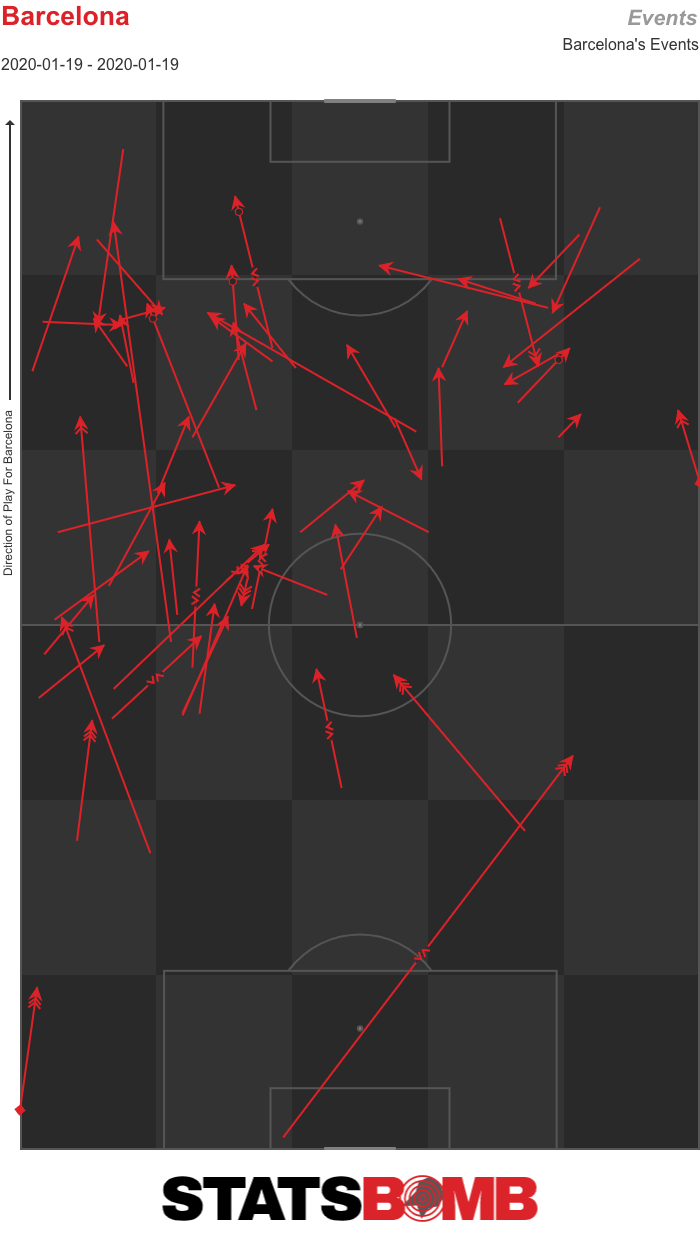 It was only one match, and it didn’t really make an appreciable difference in terms of output. Maybe it was just an aesthetic thing. But given Barcelona are the club who have made aesthetics their thing, and that Setién’s appointment was at least partly driven by that, it feels like a step in the right direction.
It was only one match, and it didn’t really make an appreciable difference in terms of output. Maybe it was just an aesthetic thing. But given Barcelona are the club who have made aesthetics their thing, and that Setién’s appointment was at least partly driven by that, it feels like a step in the right direction.
Last week, Sevilla paid the €20 million release clause for Leganés forward Youssef En-Nesyri. He went straight into the squad for their weekend defeat to Real Madrid, coming off the bench for the final half-hour or so and generating Sevilla's sole opportunity to equalise when he received an errant Madrid pass and drove past a defender into the area, only to fire well wide. That little passage provided a glimpse of the directness that is a key component of En-Nesyri’s game. Throughout the last season and a half at Leganés, he has proved himself adept at picking the ball up inside the final third and driving it on into the penalty area.  The 22-year-old is a slightly awkward runner, more angular than he appears at first glance, but he’s also one of the fastest players in La Liga. To that he adds a decent aerial game (he does stand at six feet and two inches tall after all), and a willingness to press from the front that has made him a top-six forward in each of last three seasons in terms of pressing actions. He has a varied enough toolbox to perform as a more mobile alternative to central striker Luuk de Jong or as direct option on the right or left of Sevilla’s attack. En-Nesyri’s numbers reveal a clear uptick between his 2017–18 campaign at Málaga and his 2018–19 at Leganés.
The 22-year-old is a slightly awkward runner, more angular than he appears at first glance, but he’s also one of the fastest players in La Liga. To that he adds a decent aerial game (he does stand at six feet and two inches tall after all), and a willingness to press from the front that has made him a top-six forward in each of last three seasons in terms of pressing actions. He has a varied enough toolbox to perform as a more mobile alternative to central striker Luuk de Jong or as direct option on the right or left of Sevilla’s attack. En-Nesyri’s numbers reveal a clear uptick between his 2017–18 campaign at Málaga and his 2018–19 at Leganés.  That progression has somewhat stalled this season, but it feels as if there is still more to come. He looks a typical Monchi signing: a young player with a diverse skillset that hasn’t quite yet coalesced into an aggregate greater than the sum of its parts. The expectation is that his output will improve in the company of better players, but it remains to be seen whether reality will conform to this hypothesis.
That progression has somewhat stalled this season, but it feels as if there is still more to come. He looks a typical Monchi signing: a young player with a diverse skillset that hasn’t quite yet coalesced into an aggregate greater than the sum of its parts. The expectation is that his output will improve in the company of better players, but it remains to be seen whether reality will conform to this hypothesis.
Shortly before their home match against Celta Vigo at the end of October, the players and coaching staff of Real Betis met to air their differences and find a way forward. Down in the bottom three, with just two wins and nine points to their credit, and with underlying numbers that weren’t much better, the future of coach Rubi was on the line. The consensus was that changes had been made too abruptly to their previous approach under Quique Setién. The new Barcelona coach has a very particular style of play, and some of the players were struggling to adapt to a new system after a couple of seasons under his command. Compromise was found. From then on, results and performances have greatly improved. In fact, over the subsequent 10 matches, Betis’ underlying numbers have been the fifth-best in La Liga. Only three teams have taken more points. On Sunday, they produced arguably their best performance of the season in an impressive 3–0 win at home to Real Sociedad. With those above faltering, they are slowly working their way back in European contention. 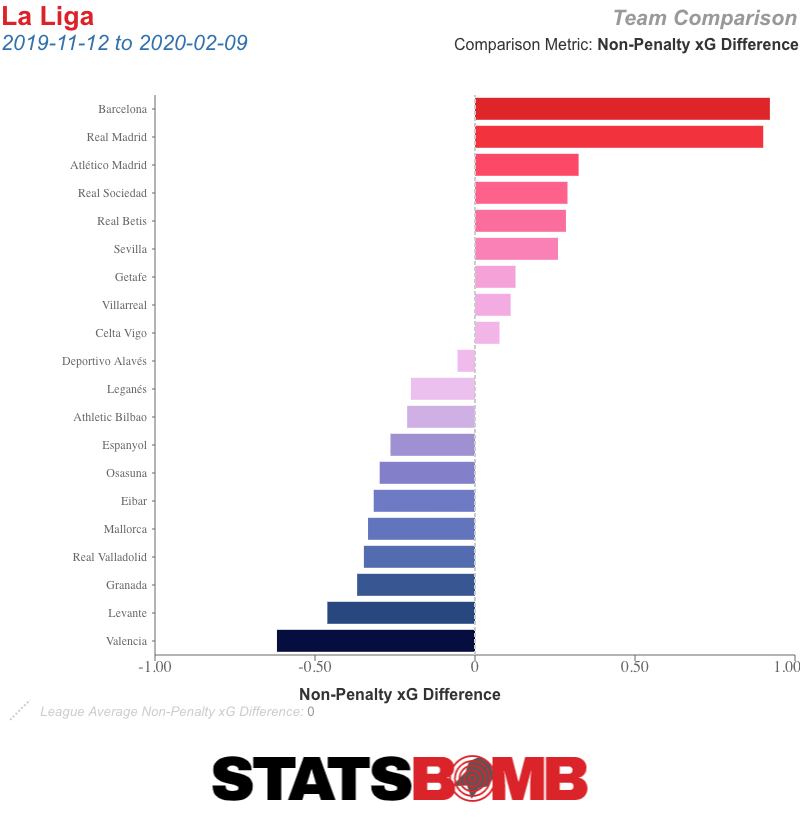 So what has changed? In possession, the side has shifted back to the system of three central defenders and two high-positioned wing-backs that formed the basis of initial ball progression under Setién. Of the pass networks from Betis’ first 10 matches of the season, the large majority feature a clear division between the two central defenders and the midfield zone.
So what has changed? In possession, the side has shifted back to the system of three central defenders and two high-positioned wing-backs that formed the basis of initial ball progression under Setién. Of the pass networks from Betis’ first 10 matches of the season, the large majority feature a clear division between the two central defenders and the midfield zone.
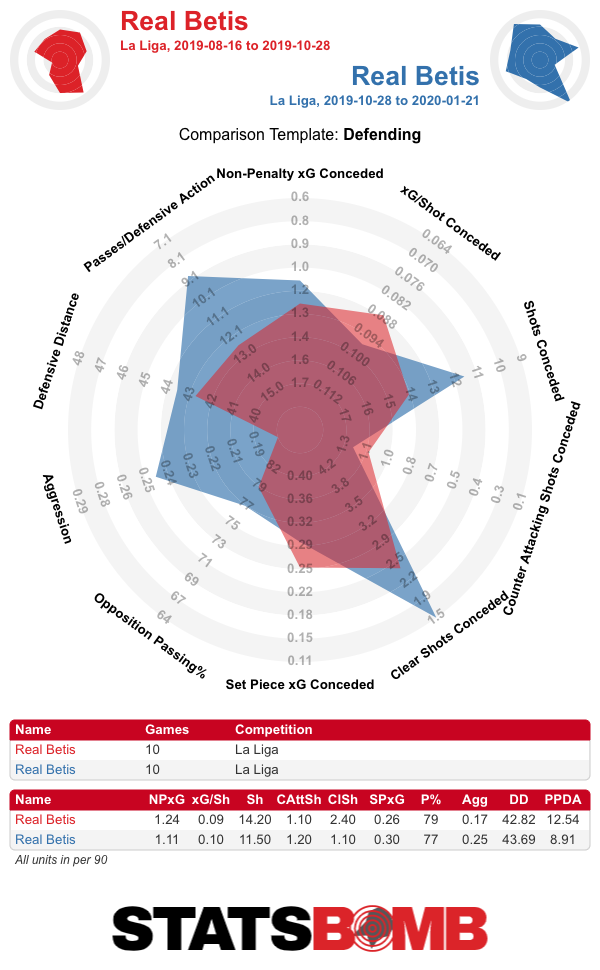 The results are clear to see. Sometimes a little compromise goes a long way.
The results are clear to see. Sometimes a little compromise goes a long way.
Abelardo has a knack for survival missions. In December 2017, he took over an Alavés side then last in the table and led them to safety. Last month, he inherited at Espanyol side likewise positioned at the bottom of the pile. After a draw against Barcelona on his debut, Espanyol recorded their first victory since October in a 2–1 win away to Villarreal on Sunday. The goals arose from two pillars of Espanyol’s survival hopes: the first from a set-piece; the second from new signing Raúl de Tomás. Abelardo’s Alavés side scored 15 times from set pieces last season, the third-best total in the league, and also generated more expected goals (xG) from these situations than any other team. 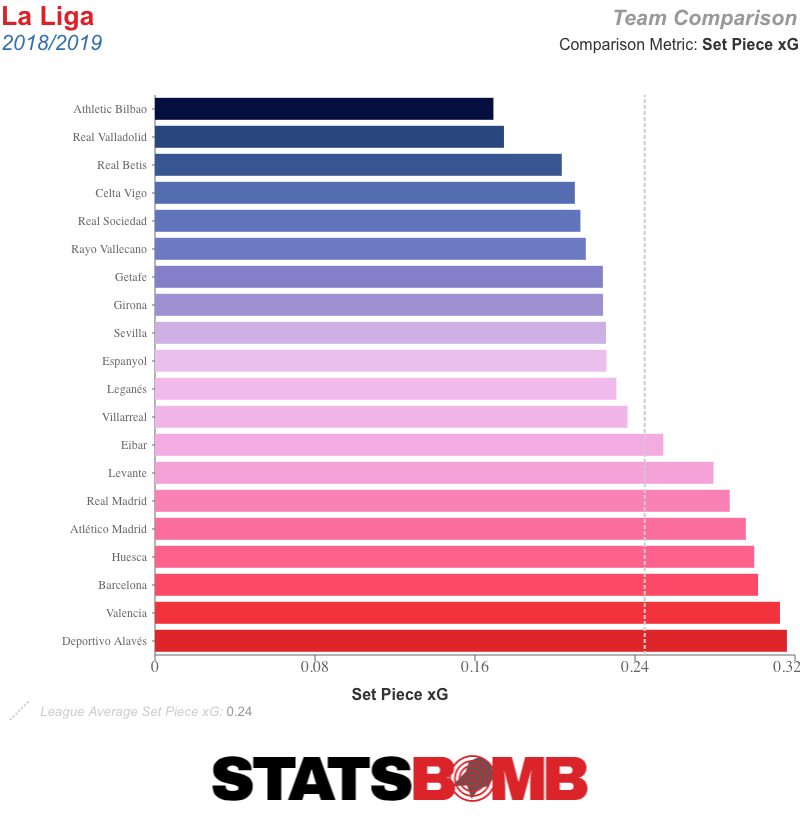 The early evidence at Espanyol suggests they will again be an important resource. David López has twice been the beneficiary to date. He headed home the opener against Barcelona and then arrived to convert Naldo’s near-post flick-on for the first against Villarreal. Espanyol won’t maintain that kind of hit rate—no team is scoring once every two matches from set pieces this season—but a few more set-piece goals will go a long way for the league’s most goal-shy team. At Rayo Vallecano last season, De Tomás showed himself to be a striker capable of generating shots and goals in a relegation-threatened team. Quick, determined and an able dribbler, amongst all players who saw at least 1,200 minutes of action, he ranked fifth in the league on a per-90 basis in shots (3.29), eighth in goals (0.42) and 11th in xG (0.36). His Espanyol debut showed exactly what he provides. Not only did he score the second goal, heading home an excellent right-wing delivery from Jonathan Calleri, but he alone generated over half his team’s expected goals off of his seven shots. Espanyol is strongly backing Abelardo. After laying down €20 million on De Tomás, they spent a further €9 million to bring in Getafe central defender Leandro Cabrera. Other deals seem to be in the works. But whatever additional elements he adds, having both an individual shot-generator and a systemised means of creating shots and goals already puts his side in a much better position to avoid the drop. Header image courtesy of the Press Association
The early evidence at Espanyol suggests they will again be an important resource. David López has twice been the beneficiary to date. He headed home the opener against Barcelona and then arrived to convert Naldo’s near-post flick-on for the first against Villarreal. Espanyol won’t maintain that kind of hit rate—no team is scoring once every two matches from set pieces this season—but a few more set-piece goals will go a long way for the league’s most goal-shy team. At Rayo Vallecano last season, De Tomás showed himself to be a striker capable of generating shots and goals in a relegation-threatened team. Quick, determined and an able dribbler, amongst all players who saw at least 1,200 minutes of action, he ranked fifth in the league on a per-90 basis in shots (3.29), eighth in goals (0.42) and 11th in xG (0.36). His Espanyol debut showed exactly what he provides. Not only did he score the second goal, heading home an excellent right-wing delivery from Jonathan Calleri, but he alone generated over half his team’s expected goals off of his seven shots. Espanyol is strongly backing Abelardo. After laying down €20 million on De Tomás, they spent a further €9 million to bring in Getafe central defender Leandro Cabrera. Other deals seem to be in the works. But whatever additional elements he adds, having both an individual shot-generator and a systemised means of creating shots and goals already puts his side in a much better position to avoid the drop. Header image courtesy of the Press Association